International Journal of Learning, Teaching and Educational Research
- Announcements
- Editorial Board
- Submit a Paper
- Publication Ethics
- ##PAPER TEMPLATE##
- ##Retraction Policy##

Project-Based Learning in Fostering Creative Thinking and Mathematical Problem-Solving Skills: Evidence from Primary Education in Indonesia
The interdependence between the Project-Based Learning (PjBL) Model and the growth and enhancement of Creative Thinking and Mathematical Problem Solving Skills in Elementary Schools is unquestionable nowadays. Prior studies have yet to discover concrete evidence regarding the interdependence being discussed. This study highlighted cognitive abilities related to creative thinking and mathematics problem-solving by implementing the Project-Based Learning Model. This research was a quasi-experiment with a pretest-posttest control group design involving 43 students in the sixth grade of two elementary schools; data was collected through test and classroom observation, and then the data was analyzed using Multivariate Analysis of Variance (MANOVA). Conversely, students exposed to project-based learning models exhibit higher skill levels in creative thinking and problem-solving than those instructed using conventional learning models. The project-based learning model significantly impacted elementary school children’s creative thinking and mathematics problem-solving skills. These findings suggest that the Project-Based Learning Model is acceptable for instructors seeking to foster creativity in teaching mathematics at the primary school level in Indonesia or other countries with comparable settings.
https://doi.org/10.26803/ijlter.23.8.15
Adijaya, M. A., Widiana, I. W., Parwata, I. G. L. A., & Antara, I. G. W. S. (2023). Bloom’s taxonomy revision-oriented learning activities to improve procedural capabilities and learning outcomes. International Journal of Educational Methodology, 9(1), 261–270. https://doi.org/10.12973/ijem.9.1.261
Albab, U., Budiyono, & Indriati, D. (2020). Metacognition skills and higher order thinking skills (HOTS) in mathematics. Journal of Physics: Conference Series, 1613(1), Article 012017. https://doi.org/10.1088/1742-6596/1613/1/012017
Almulla, M. A. (2020). The effectiveness of the project-based learning (PBL) approach as a way to engage students in learning. SAGE Open, 10(3), 1–15. https://doi.org/10.1177/2158244020938702
Amerstorfer, C. M., & Münster-Kistner, C. F. V. (2021). Student perceptions of academic engagement and student-teacher relationships in problem-based learning. Frontiers in Psychology, 12, 1–18. https://doi.org/10.3389/fpsyg.2021.713057
Arends, R. I. (2013). Learning to teach (9th ed.). McGraw-Hill.
Arici, F. (2023). An examination of the effectiveness of problem-based learning method supported by augmented reality in science education. Journal of Computer Assisted Learning, 39(2), 446–476. https://doi.org/10.1111/jcal.12752
Astuti, P., Qohar, A., & Hidayanto, E. (2019). Proses berpikir siswa dalam menyelesaikan soal higher order thinking skills berdasarkan pemahaman konseptual dan prosedural [Students’ thinking process in solving higher order thinking skills questions based on conceptual and procedural understanding]. Jurnal Pendidikan: Teori, Penelitian, dan Pengembangan, 4(1), 117. https://doi.org/10.17977/jptpp.v4i1.11910
Astutik, S., Mahardika, I. K., Indrawati, Sudarti, & Supeno. (2020). HOTS student worksheet to identification of scientific creativity skill, critical thinking skill and creative thinking skill in physics learning. Journal of Physics: Conference Series, 1465(1), Article 012075. https://doi.org/10.1088/1742-6596/1465/1/012075
Aziz, A. A. M. A. (2021). The development of the HOTS mathematical problem-solving framework using the Bar model strategy: A need analysis. Review of International Geographical Education Online, 11(4), 972–981. https://doi.org/10.33403/rigeo.8006811
Babakr, Z. H., Mohamedamin, P., & Kakamad, K. (2019). Piaget’s cognitive developmental theory: Critical review. Education Quarterly Reviews, 2(3), 517–524. https://doi.org/10.31014/aior.1993.02.03.84
Benraghda, A. (2022). Self-assessment as a self-regulated learning approach in English oral presentations: College students’ choices and perceptions. Cogent Education, 9(1), Article 2123472. https://doi.org/10.1080/2331186X.2022.2123472
Cammies, C., Cunningham, J. A., & Pike, R. K. (2022). Not all Bloom and gloom: Assessing constructive alignment, higher order cognitive skills, and their influence on students’ perceived learning within the practical components of an undergraduate biology course. Journal of Biological Education, 58(3), 588–608. https://doi.org/10.1080/00219266.2022.2092191
Chen, J., Kolmos, A., & Du, X. (2021). Forms of implementation and challenges of PBL in engineering education: A review of literature. European Journal of Engineering Education, 46(1), 90–115. https://doi.org/10.1080/03043797.2020.1718615
Cheng, L., Wang, M., Chen, Y., Niu, W., Hong, M., & Zhu, Y. (2022). Design my music instrument: A project-based science, technology, engineering, arts, and mathematics program on the development of creativity. Frontiers in Psychology, 12, 1–8. https://doi.org/10.3389/fpsyg.2021.763948
C?r?t, D. K., & Aydemir, S. (2023). Online scratch activities during the COVID-19 pandemic: Computational and creative thinking. International Journal of Evaluation and Research in Education, 12(4), 2111–2120. https://doi.org/10.11591/ijere.v12i4.24938
Cook, S. C. (2020). Schema-based instruction for mathematical word problem solving: An evidence-based review for students with learning disabilities. Learning Disability Quarterly, 43(2), 75–87. https://doi.org/10.1177/0731948718823080
Creswell, J. W. (2014). Research design: Qualitative, quantitative, and mixed methods approaches (4th ed.). SAGE Publication.
Cruz, S., Lencastre, J. A., & Viseu, F. (2023). Heuristics and usability testing of a project-based learning online course: A case study with structural mathematical concepts. International Journal of Instruction, 16(3), 465–488. https://doi.org/10.29333/iji.2023.16325a
Diego-Mantecon, J. M., Prodromou, T., Lavicza, Z., Blanco, T. F., & Ortiz-Laso, Z. (2021). An attempt to evaluate STEAM project-based instruction from a school mathematics perspective. ZDM – Mathematics Education, 53(5), 1137–1148. https://doi.org/10.1007/s11858-021-01303-9
Edwar, E., Putri, R. I. I., Zulkardi, Z., & Darmawijoyo, D. (2023). Developing a workshop model for high school mathematics teachers constructing HOTS questions through the Pendidikan Matematika Realistik Indonesia approach. Journal on Mathematics Education, 14(4), 603–626. https://doi.org/10.22342/jme.v14i4.pp603-626
Gunawardena, M. (2021). Scaffolding students’ critical thinking: A process not an end game. Thinking Skills and Creativity, 41, Article 100848. https://doi.org/10.1016/j.tsc.2021.100848
Guo, P., Saab, N., Post, L. S., & Admiraal, W. (2020). A review of project-based learning in higher education: Student outcomes and measures. International Journal of Educational Research, 102, Article 101586. https://doi.org/10.1016/j.ijer.2020.101586
Handayani, A. D., & Iswantiningtyas, V. (2020). Javanese traditional games as a teaching and learning media to socialize and introduce mathematics since early age. Journal of Physics: Conference Series, 1521(3), 1–7. https://doi.org/10.1088/1742-6596/1521/3/032008
Hawari, A. D. M., & Noor, A. I. M. (2020). Project based learning pedagogical design in STEAM art education. Asian Journal of University Education, 16(3), 102–111. https://doi.org/10.24191/ajue.v16i3.11072
Hidayati, Y. M., Ngalim, A., Sutama, Arifin, Z., Abidin, Z., & Rahmawati, E. (2020). Level of combinatorial thinking in solving mathematical problems. Journal for the Education of Gifted Young Scientists, 8(3), 1231–1243. https://doi.org/10.17478/JEGYS.751038
Hujjatusnaini, N. (2020). The effect of blended project-based learning integrated with 21st-century skills on pre-service biology teachers’ higher-order thinking skills. Jurnal Pendidikan IPA Indonesia, 11(1), 104–118. https://doi.org/10.15294/jpii.v11i1.27148
Irdalisa, I., Zulherman, Z., Elvianasti, M., Widodo, W. S., & Hanum, E. (2024). Effectiveness of project-based learning on STEAM-based student’s worksheet analysis with ecoprint technique. International Journal of Educational Methodology, 10(1), 123–135. https://doi.org/10.12973/ijem.10.1.923
Jiang, B., & Li, Z. (2021). Effect of Scratch on computational thinking skills of Chinese primary school students. Journal of Computers in Education, 8(4), 505–525. https://doi.org/10.1007/s40692-021-00190-z
Jiang, Y., Xu, N., Xu, S., & Wang, S. (2022). The enlightenment of Piaget’s theory to Chinese primary school education. Advances in Social Science, Education and Humanities Research, 670, 878–882. https://doi.org/10.2991/assehr.k.220704.158
Junianto, J., & Wijaya, A. (2019). Developing students’ mathematical literacy through problem based learning. Journal of Physics: Conference Series, 1320(1), Article 012035. IOP Publishing. https://doi.org/10.1088/1742-6596/1320/1/012035
Karan, E. (2022). Enhancing students’ problem-solving skills through project-based learning. Journal of Problem Based Learning in Higher Education, 10(1), 74–87. https://doi.org/10.54337/ojs.jpblhe.v10i1.6887
Kemendikbudristek. (2023). Laporan PISA Kemendikbudristek [PISA report of the Ministry of Education and Culture]. PISA 2022 Dan Pemulihan Pembelajaran Indonesia (pp. 1–25). https://balaibahasariau.kemdikbud.go.id/wpcontent/uploads/2023/12/LAPORAN-PISA-KEMENDIKBUDRISTEK.pdf
Khalid, M., Saad, S., Hamid, S. R. A., Abdullah, M. R., Ibrahim, H., & Shahrill, M. (2020). Enhancing creativity and problem solving skills through creative problem solving in teaching mathematics. Creativity Studies, 13(2), 270–291. https://doi.org/10.3846/cs.2020.11027
Kharisma, F. N., Susilowati, S. M. E., & Ridlo, S. (2019). The effective learning models in developing problem-solving skills. KnE Social Sciences, 3(18), 595–604 https://doi.org/10.18502/kss.v3i18.4750
Kim, H. W., & Kim, M. K. (2021). A case study of children’s interaction types and learning motivation in small group project-based learning activities in a mathematics classroom. Eurasia Journal of Mathematics, Science and Technology Education, 17(12), em2051. https://doi.org/10.29333/ejmste/11415
Kurniawan, E. S., Mundilarto, M., & Istiyono, E. (2024). Improving student higher order thinking skills using Synectic-HOTS-oriented learning model. International Journal of Evaluation and Research in Education, 13(2), 1132–1140. https://doi.org/10.11591/ijere.v13i2.25002
Lafmejani, A. Q. (2022). Cognitive evolution of the “Human” concept and its adaptation to Piaget’s theory. Caspian Journal of Neurological Sciences, 8(4), 222–233. https://doi.org/10.32598/CJNS.4.31.355.1
Lazi?, B. D., Kneževi?, J. B., & Mari?i?, S. M. (2021). The influence of project-based learning on student achievement in elementary mathematics education. South African Journal of Education, 41(3), Article 1909. https://doi.org/10.15700/saje.v41n3a1909
Leasa, M. (2020). The effect of learning styles on the critical thinking skills in natural science learning of elementary school students. Elementary Education Online, 19(4), 2086–2097. https://doi.org/10.17051/ilkonline.2020.763449
Lee, J. S., & Galindo, E. (2021). Examining project-based learning successes and challenges of mathematics preservice teachers in a teacher residency program: Learning by doing. Interdisciplinary Journal of Problem-Based Learning, 15(1), 1–20. https://doi.org/10.14434/ijpbl.v15i1.28786
Li, Z. (2022). Assessment of scientific thinking and creativity in an electronic educational environment. International Journal of Science Education, 44(3), 463–486. https://doi.org/10.1080/09500693.2022.2032863
Lin, X. (2021). Investigating the unique predictors of word-problem solving using meta-analytic structural equation modeling. Educational Psychology Review, 33(3), 1097?1124. https://doi.org/10.1007/s10648-020-09554-w
Liu, M. (2023). Bayesian optimization and ensemble learning algorithm combined method for deformation prediction of concrete dam. Structures, 54, 981–993. https://doi.org/10.1016/j.istruc.2023.05.136
Lu, X., & Kaiser, G. (2022). Creativity in students’ modelling competencies: Conceptualisation and measurement. Educational Studies in Mathematics, 109(2), 287–311. https://doi.org/10.1007/s10649-021-10055-y
MacLeod, M., & Veen, J. T. V. D. (2020). Scaffolding interdisciplinary project-based learning: A case study. European Journal of Engineering Education, 45(3), 363–377. https://doi.org/10.1080/03043797.2019.1646210
Marbán, J. M., Radwan, E., Radwan, A., & Radwan, W. (2021). Primary and secondary students’ usage of digital platforms for mathematics learning during the COVID19 outbreak: The case of the Gaza strip. Mathematics, 9(2), Article 110. https://doi.org/10.3390/math9020110
Menggo, S., Pramesti, P. D. M. Y., & Krismayani, N. W. (2023). Integrating project-based learning in preparing students’ interpersonal communication skills on speaking courses in Indonesia. International Journal of Learning, Teaching and Educational Research, 22(9), 219–240. https://doi.org/10.26803/ijlter.22.9.12
Meyer, M. W., & Norman, D. (2020). Changing design education for the 21st century. The Journal of Design, Economics, and Innovation, 6(1), 13–49. https://doi.org/10.1016/j.sheji.2019.12.002
Michalsky, T. (2024). Metacognitive scaffolding for preservice teachers’ self-regulated design of higher order thinking tasks. Heliyon, 10(2), e2480. https://doi.org/10.1016/j.heliyon.2024.e24280
Moma, L. (2015). Pengambangan instrumen kemampuan berpikir kreatif matematis untuk siswa SMP [Development of mathematical creative thinking instruments for junior high school students]. Delta-Pi: Jurnal Matematika Dan Pendidikan Matematika, 4(1), 27–41. https://doi.org/10.33387/dpi.v4i1.142
Morteza, T., & Moghaddam, M. Y. (2017). On the plausibility of Bloom’s higher order thinking strategies on learner autonomy: The paradigm shift. Asian-Pacific Journal of Second and Foreign Language Education, 2, Article 14. https://doi.org/10.1186/s40862-017-0037-8
Munar, A., Winarti, W., Nai’mah, N., Rezieka, D. G., & Aulia, A. (2022). Improving higher order thinking skill (HOTs) in early children using picture story book. AL-ISHLAH: Jurnal Pendidikan, 14(3), 4611–4618. https://doi.org/10.35445/alishlah.v14i3.2224
Muttaqin, H., Susanto, Hobri, & Tohir, M. (2021). Students’ creative thinking skills in solving mathematics higher order thinking skills (HOTs) problems based on online trading arithmetic. Journal of Physics: Conference Series, 1832(1), Article 012036. https://doi.org/10.1088/1742-6596/1832/1/012036
Ndiung, S., Sariyasa, Jehadus, E., & Apsari, R. A. (2021). The effect of treffinger creative learning model with the use RME principles on creative thinking skill and mathematics learning outcome. International Journal of Instruction, 14(2), 873–888. https://doi.org/10.29333/iji.2021.14249a
Newton, K. J. (2020). Mathematical flexibility: Aspects of a continuum and the role of prior knowledge. Journal of Experimental Education, 88(4), 503–515. https://doi.org/10.1080/00220973.2019.1586629
Nizaruddin, N., & Kusmaryono, I. (2023). Transforming students’ pseudo-thinking into real thinking in mathematical problem solving. International Journal of Educational Methodology, 9(3), 477–491. https://doi.org/10.12973/ijem.9.3.477
Nuryadin, A., Karlimah, K., Lidinillah, D. A. M., & Apriani, I. F. (2023). Blended learning after the pandemic: The flipped classroom as an alternative learning model for elementary classrooms. Participatory Educational Research, 10(3), 209–225. https://doi.org/10.17275/per.23.52.10.3
OECD (Organisation for Economic Co-operation and Development). (2024). PISA results 2022 (Volume III) – Factsheets: Indonesia. OECD. https://www.oecd.org/en/publications/pisa-results-2022-volume-iii-factsheets_041a90f1-en/indonesia_a7090b49-en.html
Pakpahan, F. H., & Saragih, M. (2022). Theory of cognitive development by Jean Piaget. Journal of Applied Linguistics, 2(2), 55–60. https://doi.org/10.52622/joal.v2i2.79
Palinussa, A. L. (2013). Students’ critical mathematical thinking skills and character: Experiments for junior high school students through realistic mathematics education culture-based. Journal on Mathematics Education, 4(1), 75–94. https://doi.org/10.22342/jme.4.1.566.75-94
Piaget, J. (1936). Origins of intelligence in the child. Routledge & Kegan Paul.
PISA. (2023). PISA 2022 results (Volume I and II) – Country notes: Indonesia. https://www.oecd.org/en/publications/pisa-2022-results-volume-i-and-ii-country-notes_ed6fbcc5-en/indonesia_c2e1ae0e-en.html
Prastiti, T. D., Tresnaningsih, S., Mairing, J. P., & Azkarahman, A. R. (2020). HOTS problem on function and probability: Does it impact to students’ mathematical literacy in Universitas Terbuka? Journal of Physics: Conference Series, 1613(1), Article 012003. https://doi.org/10.1088/1742-6596/1613/1/012003
Puccio, G., Lohiser, A., & Seemiller, C. (2021). Understanding convergent thinking: Developing effective critical thinking. In Creative problem solving: A 21st century workplace skill. SAGE Publications. https://doi.org/10.4135/9781071865637
Purwaningsih, E., Sari, A. M., Yuliati, L., Masjkur, K., Kurniawan, B. R., & Zahiri, M. A. (2020). Improving the problem-solving skills through the development of teaching materials with STEM-PjBL (science, technology, engineering, and mathematics-project based learning) model integrated with TPACK (technological pedagogical content knowledge). Journal of Physics: Conference Series, 1481(1), Article 012133. https://doi.org/10.1088/1742-6596/1481/1/012133
Putri, N., Rusdiana, D., & Suwarma, I. R. (2020). Enhanching physics students’ creative thinking skills using CBL model implemented in STEM in vocational school. Journal of Physics: Conference Series, 1521, Article 042045. https://doi.org/10.1088/1742-6596/1521/4/042045
Rahman, M. S., Juniati, D., & Manuharawati, M. (2023). The quality of mathematical proficiency in solving geometry problem: Difference cognitive independence and motivation. Pegem Journal of Education and Instruction, 13(3), 255–266. https://doi.org/10.47750/pegegog.13.03.27
Rehman, N., Zhang, W., Mahmood, A., Fareed, M. Z., & Batool, S. (2023). Fostering twenty-first century skills among primary school students through math project-based learning. Humanities and Social Sciences Communications, 10(1), Article 424. https://doi.org/10.1057/s41599-023-01914-5
Roble, D. B., Lomibao, L. S., & Luna, C. A. (2021). Developing students’ creative constructs in mathematics with problem-based (PB) and problem posing (PP) tasks. Canadian Journal of Family and Youth, 13(2), 82–94. https://doi.org/10.29173/cjfy29672
Rosidin, U., Suyatna, A., & Abdurrahman, A. (2019). A combined HOTS-based assessment/STEM learning model to improve secondary students’ thinking skills: A development and evaluation study. Journal for the Education of Gifted Young Scientists, 7(3), 435–448. https://doi.org/10.17478/jegys.518464
Rusilowati, A., Negoro, R. A., Aji, A. P., & Subali, B. (2023). Development of waves critical thinking test: Physics essay test for high school student. European Journal of Educational Research, 12(4), 1781–1794. https://doi.org/10.12973/eu-jer.12.4.1781
Safie, N., & Zakaria, S. (2023). Examining the effectiveness of thinking maps usage by analysing students’ achievement in mathematics subject. Journal of Advanced Research in Applied Sciences and Engineering Technology, 31(1), 197–209. https://doi.org/10.37934/ARASET.31.1.197209
Sahudra, T. M., Ary, K. K., Ramadhani, D., Asnawi, A., & Handrianto, C. (2021). The impact of project-based flipped learning model on the technological pedagogical content knowledge skill of prospective teachers. Sustainability (Switzerland), 13(5), Article 2606. https://doi.org/10.3390/su13052606
Saldo, I. J. P., & Walag, A. M. P. (2020). Utilizing problem-based and project-based learning in developing students’ communication and collaboration skills in physics. American Journal of Educational Research, 8(5), 232–237. https://doi.org/10.12691/education-8-5-1
Samsudin, M. A., Jamali, S. M., Zain, A. N. M., & Ebrahim, N. A. (2020). The effect of STEM project based learning on self-efficacy among high-school physics students. Journal of Turkish Science Education, 17(1), 94–108. https://doi.org/10.36681/tused.2020.15
Schindler, M., & Bakker, A. (2020). Affective field during collaborative problem posing and problem solving: A case study. Educational Studies in Mathematics, 105(3), 303?324. https://doi.org/10.1007/s10649-020-09973-0
Schleicher, A. (2018). PISA 2018 insights and interpretations. OECD. Available at https://www.oecd.org/content/dam/oecd/en/about/programmes/edu/pisa/publications/national-reports/pisa-2018/PISA%202018%20Insights%20and%20Interpretations%20FINAL%20PDF.pdf
Serin, H. (2023). Teaching mathematics: The role of project-based learning. International Journal of Social Sciences & Educational Studies, 10(2), Article 28. https://doi.org/10.23918/ijsses.v10i2p378
Setianingsih, R., Sa’dijah, C., As’ari, A. R., & Muksar, M. (2017). Investigating fifth-grade students’ construction of mathematical knowledge through classroom discussion. International Electronic Journal of Mathematics Education, 12(4), 383–396. https://doi.org/10.29333/iejme/619
Shidqi, L., Trisniawati, T., & Rhosyida, N. (2023). The development of kobatar learning media for learning mathematics in elementary school. Advances in Mobile Learning Educational Research, 3(2), 886–892. https://doi.org/10.25082/amler.2023.02.015
Simonton, K. L. (2021). Project-based learning and its potential in physical education: An instructional model inquiry. Curriculum Studies in Health and Physical Education, 12(1), 36–52. https://doi.org/10.1080/25742981.2020.1862683
Sofiyan, S., Amalia, R., & Suwardi, A. B. (2020). Development of mathematical teaching materials based on project-based learning to improve students’ HOTS and character. Journal of Physics: Conference Series, 1460(1), Article 012006. https://doi.org/10.1088/1742-6596/1460/1/012006
Son, A. L., Darhim, D., & Fatimah, S. (2020). Students’ mathematical problem-solving ability based on teaching models intervention and cognitive style. Journal on Mathematics Education, 11(2), 209–222. https://doi.org/10.22342/jme.11.2.10744.209-222
Suanto, E., Maat, S. M., & Zakaria, E. (2023). The effectiveness of the implementation of three dimensions geometry KARA module on higher order thinking skills (HOTS) and motivation. International Journal of Instruction, 16(3), 95–116. https://doi.org/10.29333/iji.2023.1636a
Sukkeewan, P., Songkram, N., & Nasongkhla, J. (2024). Development and validation of a reliable and valid assessment tool for measuring innovative thinking in vocational students. International Journal of Educational Methodology, 10(1), 35–44. https://doi.org/10.12973/ijem.10.1.835
Suratno, S., Wahono, B., Chang, C. Y., Retnowati, A., & Yushardi, Y. (2020). Exploring a direct relationship between students’ problem-solving abilities and academic achievement: A STEM education at a coffee plantation area. Journal of Turkish Science Education, 17(2), 211–224. https://doi.org/10.36681/tused.2020.22
Syahriridani, M., Susilo, H., & Ibrohim, I. (2022). Developing problem based learning through lesson study. Journal of Learning Improvement and Lesson Study, 1(2), 15–22. https://doi.org/10.24036/jlils.v1i2.20
Syamsuddin, A., Juniati, D., & Siswono, T. Y. E. (2020). Understanding the problem solving strategy based on cognitive style as a tool to investigate reflective thinking process of prospective teacher. Universal Journal of Educational Research, 8(6), 2614?2620. https://doi.org/10.13189/ujer.2020.080644
Tamur, M., Ndiung, S., Nurjaman, A., & Jerito, P. (2020). Do differences in measured mathematical abilities moderate the effectiveness of the realistic mathematics education approach? Meta-analysis studies. Jurnal Math Educator Nusantara, 7(1), 13–26. https://doi.org/10.29407/jmen.v7i1.15736
Tanjung, H. S., Nababan, S. A., Sa’dijah, C., & Subanji, S. (2020). Development of assessment tools of critical thinking in mathematics in the context of HOTS. Advances in Mathematics: Scientific Journal, 9(10), 8659–8667. https://doi.org/10.37418/amsj.9.10.91
Tanujaya, B., Prahmana, R. C. I., & Mumu, J. (2021). Mathematics instruction to promote mathematics higher-order thinking skills of students in Indonesia: Moving forward. TEM Journal, 10(4), 1945–1954. https://doi.org/10.18421/TEM104-60
Vink, I. C. D., Hornstra, L., & Kroesbergen, E. H. (2023). Latent profile analysis of working memory: Relations with creativity and academic achievement. Creativity Research Journal, 1–17. https://doi.org/10.1080/10400419.2023.2183323
Wang, X. M. (2023). An online progressive peer assessment approach to project-based learning: A constructivist perspective. Educational Technology Research and Development, 71(5), 2073–2101. https://doi.org/10.1007/s11423-023-10257-6
Widiatsih, A., Wardani, D. A. R., Royhana, U., Djamali, F., & Septory, B. J. (2020). The development of mathematical problems based on higher order thinking skills (HOTS) on comparative material by implementing PBL and its effect on the teacher’s creative thinking skill. Journal of Physics: Conference Series, 1538(1), Article 012110. https://doi.org/10.1088/1742-6596/1538/1/012110
Widyaningsih, S. W., & Yusuf, I. (2019). The project-based learning model is based on simple teaching tools and critical thinking skills. Kasuari: Physics Education Journal (KPEJ), 1(1), 12–21. https://doi.org/10.37891/kpej.v1i1.33
Wijaya, T. T., Zhou, Y., Ware, A., & Hermita, N. (2021). Improving the creative thinking skills of the next generation of mathematics teachers using dynamic mathematics software. International Journal of Emerging Technologies in Learning, 16(13), 212–226. https://doi.org/10.3991/ijet.v16i13.21535
Zubaidah, S., Fuad, N. M., Mahanal, S., & Suarsini, E. (2017). Improving creative thinking skills of students through differentiated science inquiry integrated with a mind map. Journal of Turkish Science Education, 14(4), 77–91. https://doi.org/10.12973/tused.10214a
Zulyusri, Z., Elfira, I., Lufri, L., & Santosa, T. A. (2023). Literature study: Utilization of the PjBL model in science education to improve creativity and critical thinking skills. Jurnal Penelitian Pendidikan IPA, 9(1), 133–143. https://doi.org/10.29303/jppipa.v9i1.2555
- There are currently no refbacks.
e-ISSN: 1694-2116
p-ISSN: 1694-2493

The Importance of Creativity in Children's Education

Many of us are guilty of focusing on logical skills when teaching children how to read, write and even interact with others. While these are needed in order for them to have a better understanding of the world, encouraging creativity can have a huge positive impact on your child’s development.
There are a multitude of benefits linked to inspiring creativity in young children. Here are some of them:
Mental health and self-confidence
Encouraging your child to be creative from a young age can have a significant impact on their mental health and well-being. Fun creative activities such as pretend play and storytelling can offer them some escapism from the real world, and can help young children process their feelings, thoughts, opinions and emotions in a more efficient and productive way.
When children engage in creative expression, they not only have fun but also subconsciously work on emotional development, which is essential for their own mental growth. Creating something from scratch or adding their own creative flair to something that already exists fosters a sense of pride and self-worth, which is a great way to teach your child about self-awareness, self-esteem and self-confidence.
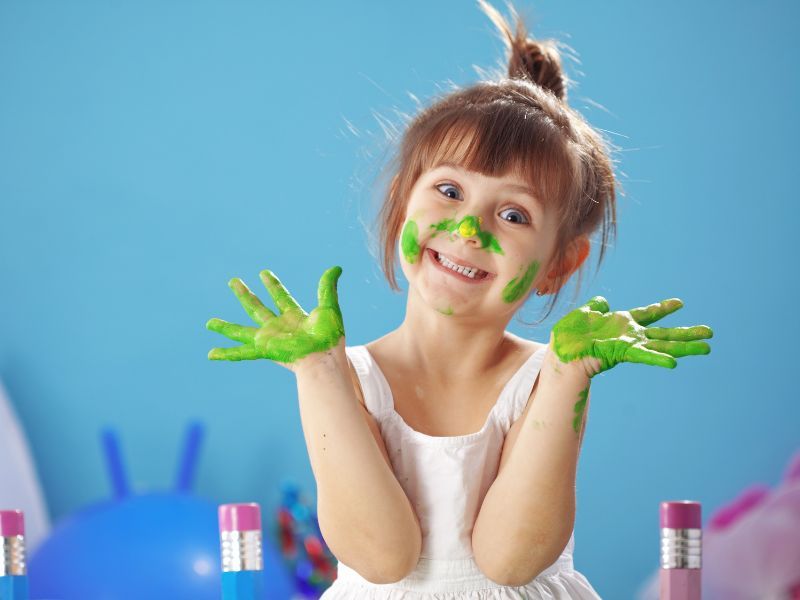
Problem-solving and critical thinking skills
When children face a problem, they tend to use their creative thinking skills to solve it. For instance, if two children want to play basketball but don't have a ball, they might think of using a crumpled piece of paper and an empty box as a makeshift ball and hoop. In this scenario, they are not just finding a solution; they are actively using their problem-solving skills and critical thinking to create an entirely new way to play the game.
Creative thinking allows children to come up with different solutions to a problem, improving their critical thinking skills and brainstorming abilities. Additionally, creativity helps children become more adaptive by teaching them to change their approach when facing obstacles. This flexibility in thinking is crucial for their development and will serve them well as they grow into more capable and resilient people.
Academic and cognitive skills
Creativity is more than an outlet for self-expression, as it can also boost children's academic and cognitive skills, laying a strong foundation for their future success. The creative process allows children to become better thinkers and learners, which can lead to improved performance in key areas like reading and writing . For example, when children participate in creative writing activities , they use their imagination and think outside the box, making the learning process more enjoyable and self-directed.
In early childhood education, fostering creativity has a huge impact on cognitive skills. Activities that promote creative thinking, such as problem-solving tasks and imaginative play, help children develop their memory and critical thinking. These skills are crucial for academic success and are foundational to quality education.
Young learners who have honed their creative abilities early on tend to exhibit better concentration, advanced language development, and better listening skills. These skills are essential for thriving in higher education.
By integrating creativity into children's education, we set them on a path towards achieving quality education and long-term academic success.
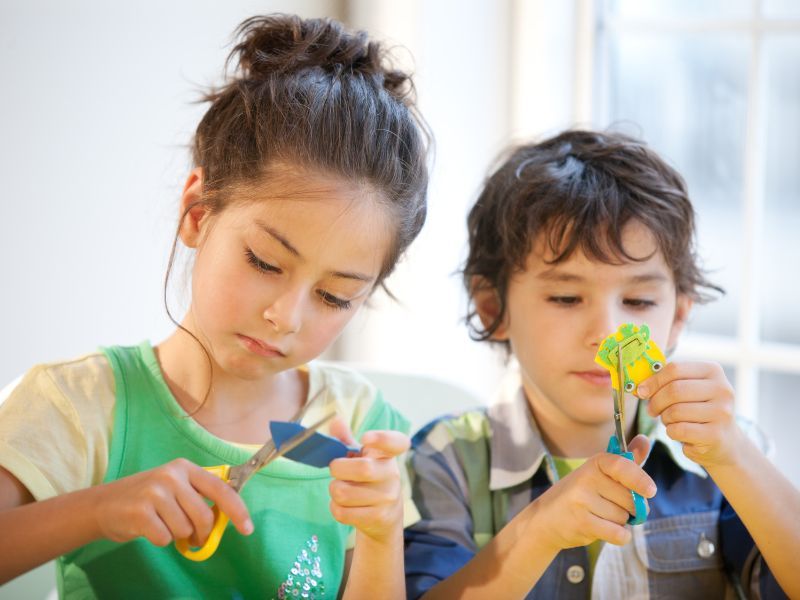
Motor skills
Creativity is not just about thinking outside the box; it also plays a significant role in boosting children's motor skills , which are a key part of their physical development. Engaging in hands-on creative activities can greatly improve fine motor skills. Art activities that involve manipulating materials, like molding playdough or painting with small brushes, are particularly effective for encouraging the development of these motor skills. Shaping playdough into different forms or painting requires children to use their hands in coordinated ways, improving their dexterity and hand-eye coordination.
These fine motor skills are crucial for child development, as they lay the foundation for more complex tasks such as writing, buttoning clothes, and using utensils.
Communication skills
Creativity is not only a gateway to imaginative play but also a powerful tool for boosting children's communication skills. When children engage in creative activities, whether it's storytelling, role-playing, or collaborative art projects, they naturally develop their social skills. These activities encourage them to express their ideas, listen to others and work together, which are essential parts of effective communication. By integrating creativity into their daily routines, children in their early years learn how to show their thoughts and feelings more clearly, laying a strong foundation for their communication abilities as they grow.
In early childhood, creative activities are particularly beneficial for helping children make sense of their surroundings and interact with others. Through imaginative play, for example, children experiment with different roles and scenarios, which helps them get a better understanding of the world and how they fit into it. This in turn inspires them to ask questions, share their perspectives and even build a broader vocabulary !
How to boost creativity
If you’re looking for ways to spark your child's creativity , there are plenty of simple yet effective strategies you can incorporate into their daily routine!
Encouraging creative play at home or in a homeschooling environment is one of the most powerful ways to boost your child’s creativity. Start by creating a fun and supportive environment filled with different materials that inspire imaginative play. Whether it’s a variety of art supplies like crayons, markers, and paper, or building blocks and costumes for pretend play, having these readily available allows young children to express their ideas freely and creatively.
Role-play is an effective way to boost children's creativity. For example, setting up a “restaurant” at home where your child can be the chef or server not only makes playtime more engaging but also helps them develop their storytelling and problem-solving skills. Pretend play scenarios like this allow children to step into different roles and explore new ideas, all while having fun!
Reading is another powerful tool for inspiring your child to be creative and encourage them to use their imagination. When children read, they’re introduced to new worlds, characters , and ideas that can inspire their own imaginative play. Encourage them to create their own stories based on what they’ve read, or ask them to draw pictures of their favorite settings or characters. This not only reinforces what they’ve learned but also allows them to explore different ways to express their thoughts and ideas creatively.
By integrating these creative experiences into your child’s routine, you’re helping them develop a strong foundation for creative thinking that will benefit their academic success and beyond!
How Night Zookeeper can help

One of the most effective ways to boost creativity while ensuring that your child is also getting the academic support they need is by using an educational program.
Night Zookeeper is a reading & writing program for children aged 6 to 12 that puts creativity at the forefront of education. It transforms reading & writing into a game that encourages children’s imaginations by letting them learn through play and encouraging them to build their on Night Zoo by completing lessons, challenges and games. This gamified approach makes learning fantastically fun, engaging and entertaining.
Sign up today and get a FREE 7-day trial!
Got any questions? Email us at [email protected] . Follow us on social media for more advice, updates and freebies:

Make Reading & Writing Fantastically Fun!
- Award-winning reading & writing program for kids
- Improves spelling, grammar, punctuation & vocabulary
- Over 1,000 different learning games and activities
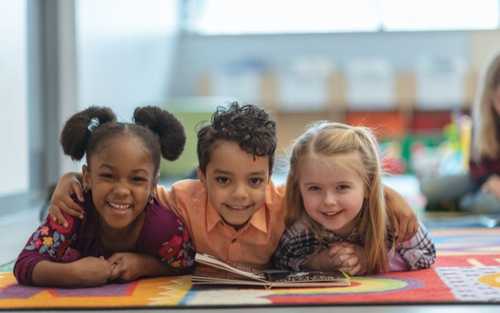
How Creative Writing Improves Children's Wellbeing
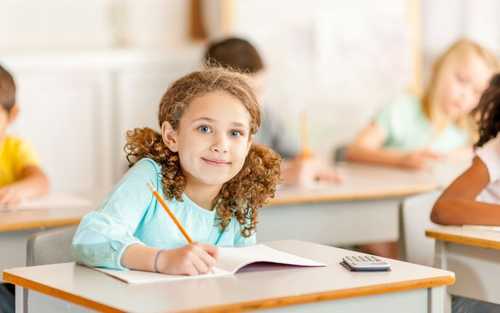
25 Creative Writing Prompts for Kids
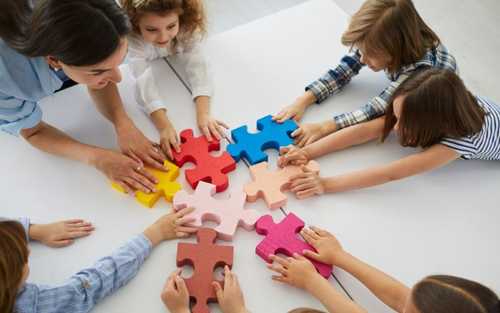
Creative Games For Kids

- Skip to primary navigation
- Skip to main content
- Skip to primary sidebar
- Skip to footer
Demme Learning
Building Lifelong Learners
- Default Sort Order
- Alphabetical: A to Z
Customer Service: M-Th 8:30am - 6pm ET Live Chat • 888-854-6284 • Email
Creative Art Activities and Strategies for Social-Emotional Learning
Demme Learning · August 28, 2024 · Leave a Comment
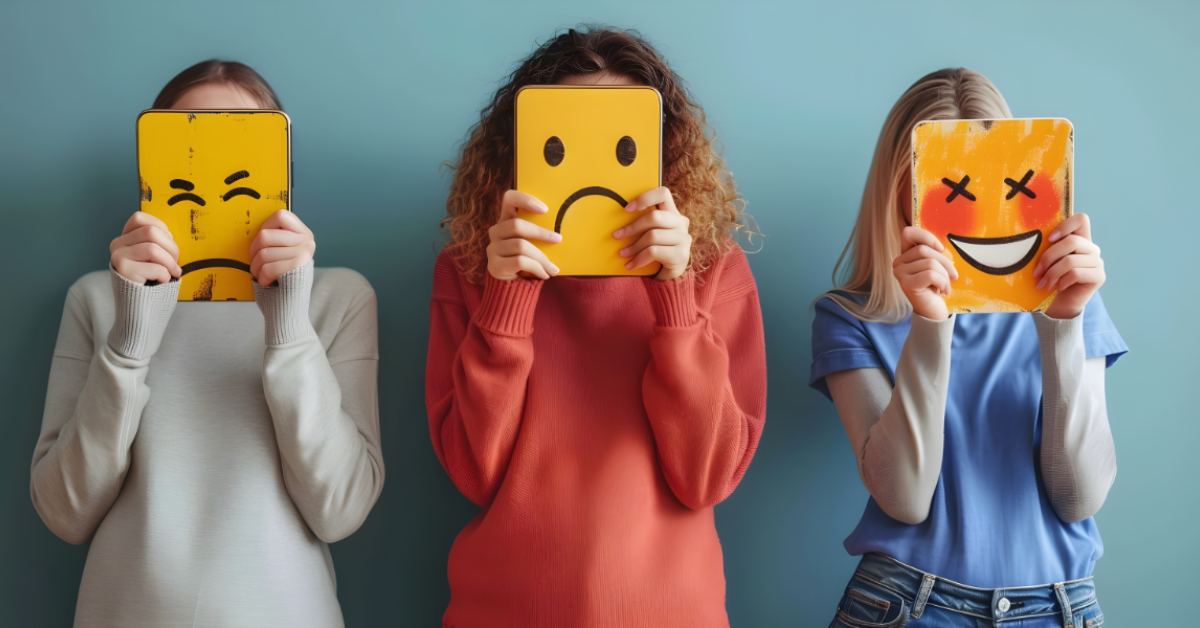
In today’s increasingly tech-focused world, developing children’s social and emotional skills is just as important as developing their academic abilities.
Social and emotional learning (SEL) has gained considerable attention in recent years, and for good reason. Integrating SEL into the classroom empowers students to break out of their digital bubbles and enter the real world. By replacing digital devices and screen time with more primitive objects like paintbrushes, paper mâché, or charcoal, arts education allows students to develop self-awareness, establish interpersonal relationships, and practice responsible decision-making.
While art certainly has academic applications, it also has a unique ability to tap into our emotions. Not only does it encourage self-expression; it also promotes social interactions. Combining social and emotional learning with artistic experiences gives students the freedom to explore their feelings, develop empathy, and practice relationship-building skills.
The Benefits of Social-Emotional Learning (SEL) Through Art
Social and emotional learning encompasses a wide range of skills that contribute to success in school, work, and life. Whether it is self-awareness, social awareness, responsible decision-making, self-management, or building relationship skills, when we integrate SEL into arts education, we contribute to students’ overall development in a way that makes the process effortless and fun.
Art activities provide a natural platform for students to explore and express their emotions. By creating art, students process complex feelings and develop a deeper understanding of themselves and others. This self-awareness is a key component to acquiring the social and emotional skills that lead to empathy and the formation of healthy relationships. In addition, positive experiences with art in a safe space at an early age can make all the difference for art appreciation and expression into adulthood.
Arts integration in SEL also helps students develop critical thinking skills and encourages them to see things from different perspectives. Students learn to manage their emotions and control their impulses as they engage in the creative process. These types of skills profoundly impact academic success, emotional well-being, and the long-term ability to participate positively in conversations and society.
Art-based SEL activities also engender social awareness and relationship skills. Collaborative art projects, for example, require students to work together, communicate effectively, and build relationships with their peers. Through these cooperative experiences, students develop the social and emotional skills necessary to maintain positive relationships throughout their lives.
Art Activities for Different Age Groups
Young children (ages 3-6).
For younger learners, simple yet engaging art activities can be effective in promoting social and emotional learning:
1) Emotional Finger Painting
Encourage students to express specific emotions through colors and patterns, which can help them develop self-awareness.
2) Friendship Collage
Ask children to create collages representing their friendships, which will help elevate their social awareness.
3) Storytelling with Puppets
Show students how to create puppets and then ask them to use them to tell stories. This helps them build empathy and communication skills.
These activities help young children process emotions, develop awareness, and begin to understand social interactions.
Elementary School Children (Ages 7-11)
As students grow, introduce more complex art activities to further develop their social and emotional skills. These can include:
1) Nature Art Mandalas
Ask students to collect natural materials and create mandalas to acquaint them with mindfulness and stress management concepts.
2) Emotion Marks
Ask children to create masks representing the different emotions they may be feeling. This will help them identify their feelings and express them constructively.
3) Collaborative Mural
To promote teamwork and build relationship skills, have the whole class work together on a large mural. Make sure the murals focus on teamwork concepts. For example, a “Kindness Tree” mural might involve students adding leaves that include acts of kindness they’ve witnessed or performed.
These projects encourage students to explore their emotions more deeply while also focusing on building positive relationships with others.
Middle and High School (Ages 12-18)
For older students, art activities can address more complex social and emotional challenges:
1) Mindset Zines
For this activity, students create mini magazines showcasing their emotional mindsets, which help promote self-awareness and self-expression.
2) Current Events Artwork
Encourage students to create art pieces addressing current events, which helps develop social awareness and responsible decision-making skills.
3) Emotion Photography
Students capture photos representing specific emotions they’ve experienced or are experiencing. This exercise can help tweens and teenagers process and understand the complex feelings they may be experiencing.
These activities help older students develop a stronger sense of self, engage with topical events, and prepare for the emotional challenges of adulthood.
Implementing SEL Activities in the Art Room and Beyond
To successfully integrate social and emotional learning into art education, consider the following strategies:
1) Encourage Reflection
After each art activity, guide students through a reflection process. Ask questions like, “How did this activity make you feel?” or “What did you learn about yourself or others?”
2) Teach Emotional Vocabulary
Help students identify and name their emotions. This can be done by creating an “emotion color wheel” or discussing the emotions portrayed in famous artwork.
3) Incorporate Mindfulness
Begin art classes with short mindfulness exercises to help students maintain focus and manage stress.
4) Connect Art to Real-Life
Help students see how the skills they’re learning through art apply to other areas of their lives. The connection between art and math is a good example of this.
5) Collaborate with Other Teachers or Instructors
Work with other educators to integrate art-based SEL activities into different subjects, thereby reinforcing social and emotional skills across the curriculum.
The Lasting Impact of Art-Based Social and Emotional Learning
Every brush stroke, every sculpture, and every other artistic expression represents an opportunity for students to grow. After all, education isn’t just about developing young academics; it’s also about developing young minds .
Remember to treat your student’s work like the piece of art it is and give it the appropriate respect and recognition. Art is very personal and there’s a difference between skill building and expression. When it comes to art-based social and emotional learning, expression is the key to lasting impact.
Integrating social and emotional learning into arts education provides students with valuable tools for navigating life’s challenges. These artistic experiences not only help them create beautiful works of art but also enable them to draw on these experiences to become engaged citizens who approach complex issues with creativity and understanding and ultimately contribute positively to their communities. For more information on implementing social and emotional learning through art, be sure to subscribe to our newsletter and check out our blog posts on exposing your family to art and teaching art at home .
Reader Interactions
Leave a reply cancel reply.
Your email address will not be published. Required fields are marked *
Save my name, email, and website in this browser for the next time I comment.
Related Stories

The Connection Between Math and Art

Why Teach Art at Home?
- Newsletters
IE 11 Not Supported
How education technology companies pitch ai to teachers, a top concern among educators remains that when students use ai to write essays or come up with ideas for projects, they miss out on the hard and focused thinking that builds creative reasoning skills..


Top 58 Creative Art Activities for Kids and Preschoolers
Unleashing creativity through art is a vital part of childhood development. This collection of creative art activities is designed to inspire young imaginations and foster self-expression in kids and preschoolers.
From innovative painting techniques to sculptural projects and crafting with recycled materials, these hands-on activities encourage exploration of colors, textures, and forms.
Not only do these artistic activities enhance fine motor skills and sensory development, but they also provide a joyful outlet for children to express their unique perspectives on the world.
1. Tie-Dye Art with Baby Wipes
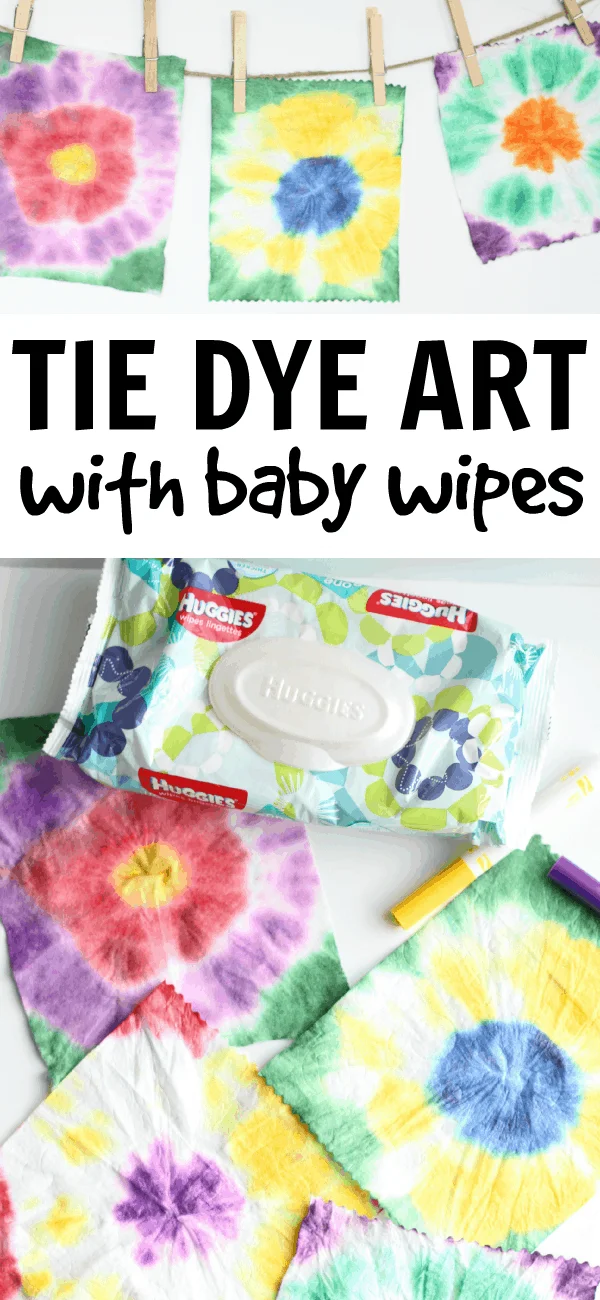
This Tie-Dye Art with Baby Wipes activity involves using baby wipes as a medium for tie-dye creations. Students can apply different colored ink or fabric dye onto unfolded baby wipes, then fold or twist them to create unique tie-dye patterns.
Learn more: I Can teach my Child
2. Baking Soda Painting
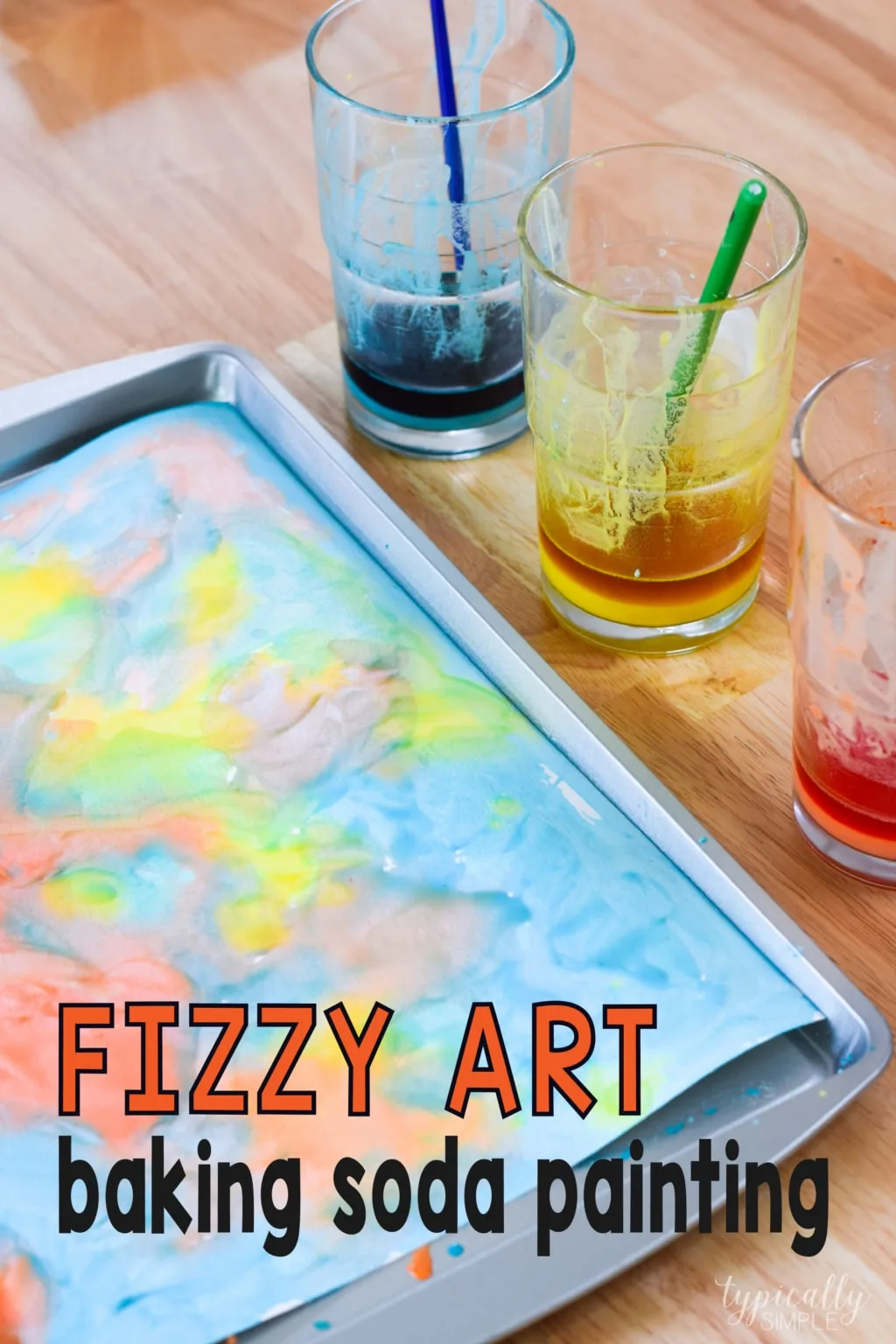
Baking Soda Painting is a creative and engaging art activity that involves using a mixture of baking soda and water as a canvas for painting. To create baking soda paint, students mix baking soda with a small amount of water until it forms a smooth paste.
Learn more: Typically Simple
3. Watercolor Jelly Fish
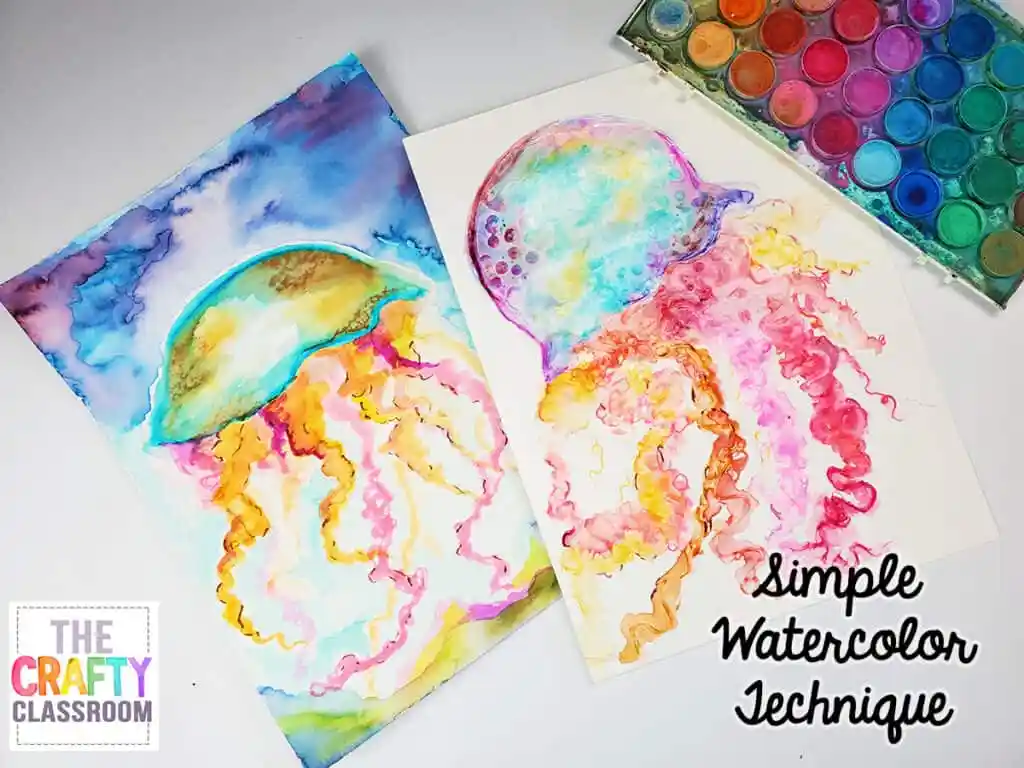
This enchanting activity brings the beauty of underwater life to the canvas as kids craft their own vibrant jellyfish using the magic of watercolors.
Learn more: The Crafty Classroom
4. Marble Painting
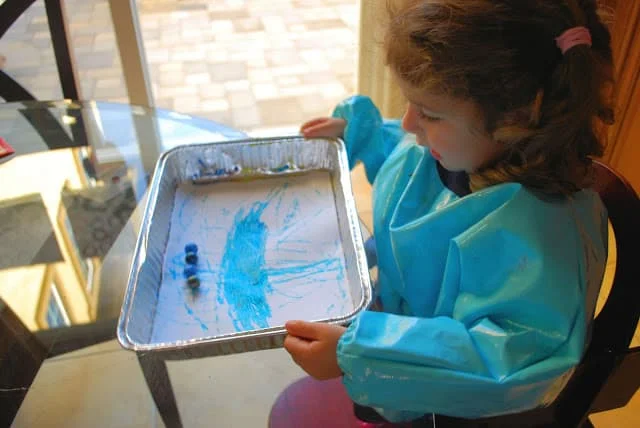
Marble painting is a creative art activity where students use marbles to create unique and colorful paintings. To do marble painting, students place a sheet of paper inside a shallow container or tray. They then add drops of different colored paint onto the paper.
Learn more: Me for Less
5. Autumn Tree Q-Tip Painting
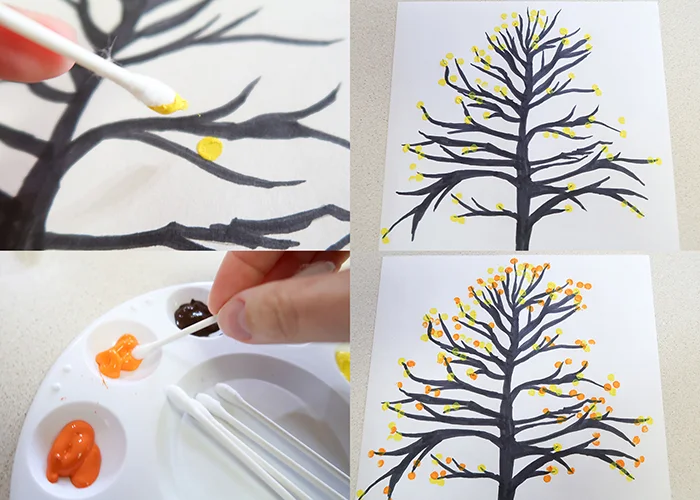
The Autumn Tree Q-Tip Painting activity involves using Q-tips as painting tools to create the vibrant foliage of an autumn tree. Students dip the Q-tips into fall-colored paints and apply them to a tree template, creating a textured and visually appealing artwork.
Learn more: Woo Jr
6. Tree Painting Using Cotton Balls
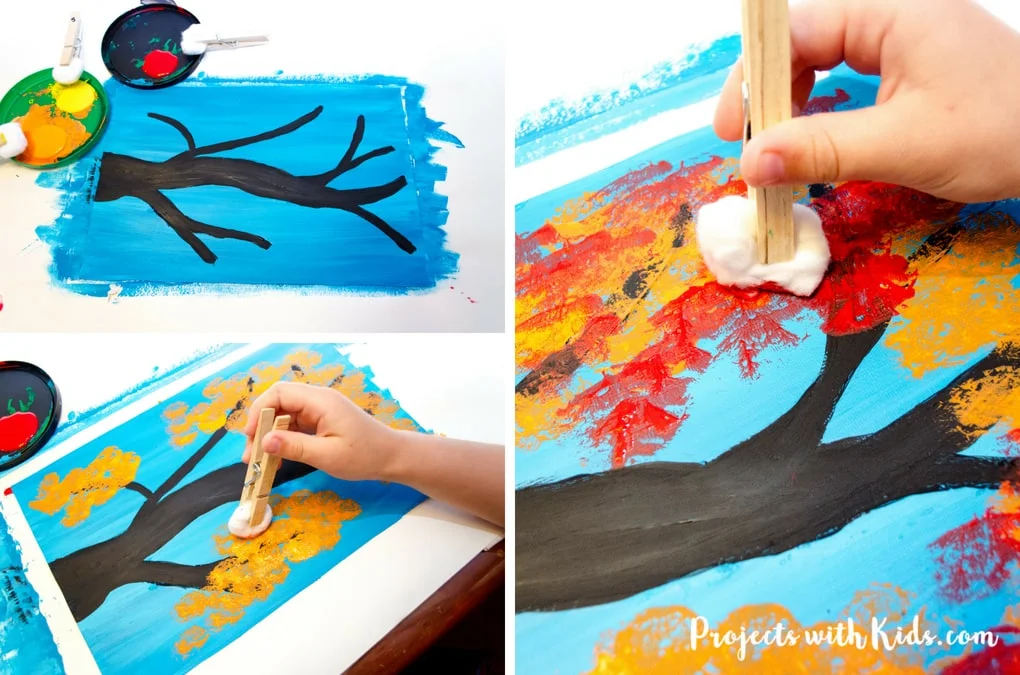
Try this whimsical adventure with Tree Painting Using Cotton Balls! Preschoolers, get ready to turn simple cotton balls into the brushes for your artistic masterpiece.
Learn more: Project with Kids
7. Kindergarten Weaving Project
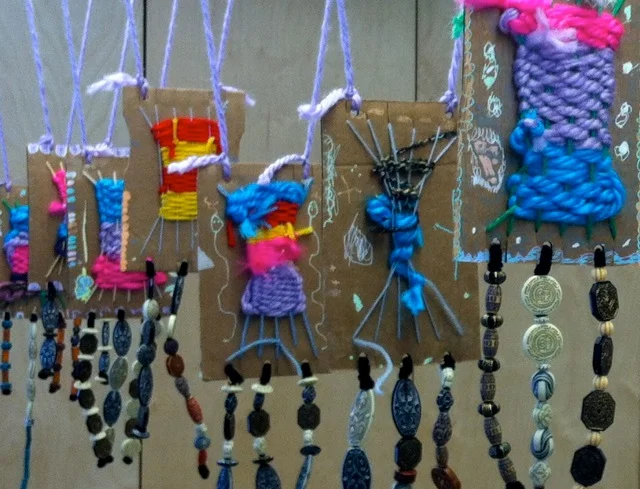
A Kindergarten weaving project is a hands-on activity that introduces young students to the art of weaving using simple materials. In this project, students typically use materials such as paper, yarn, and craft sticks to create their woven designs.
Learn more: Meri Cherry
8. Kandinsky Squares with Concentric Circle Art

The Kandinsky Squares with Concentric Circle Art project involves creating geometric artwork inspired by Wassily Kandinsky’s abstract style.
Students use squares as a canvas to paint concentric circles, exploring color combinations and spatial relationships.
Learn more: Art Prep
9. Cardboard Tube Sculpture
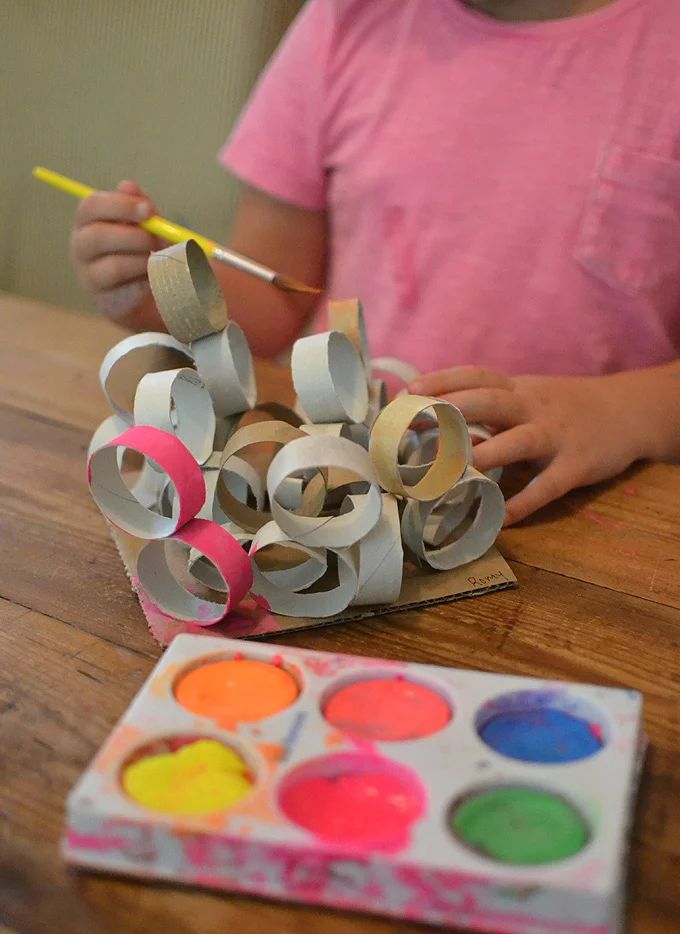
The Cardboard Tube Sculpture project entails using cardboard tubes to create three-dimensional art pieces. Students can cut, shape, and arrange the tubes to form unique sculptures.
Learn more: Art Bar Blog
10. Snail Craft
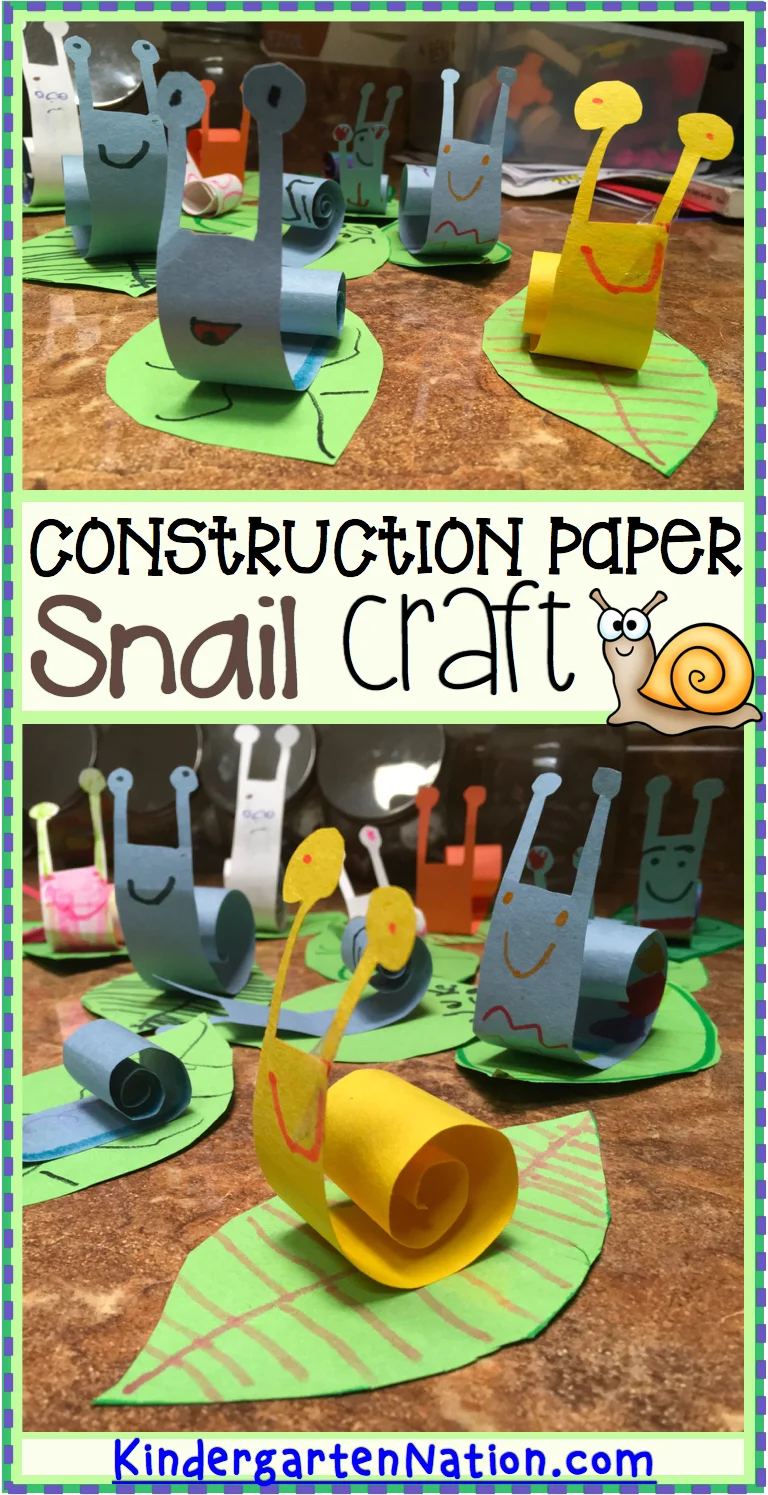
The Snail Craft activity involves creating a snail-shaped art project using various materials. Students can use paper, cardboard, googly eyes, and other craft supplies to assemble their snail.
Learn more: Kindergarten Nation
11. Alphabet Painting
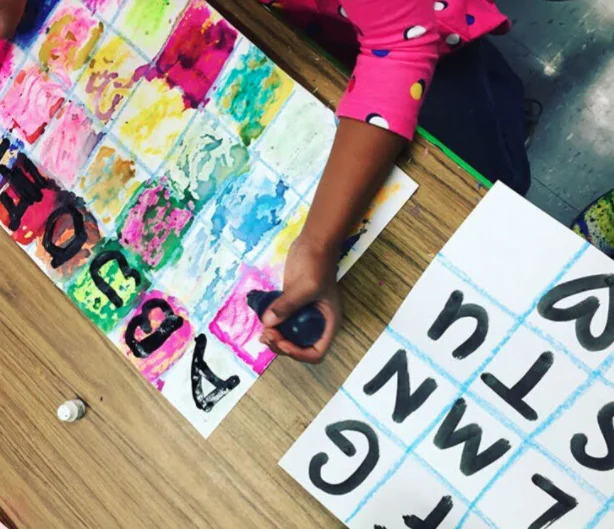
Alphabet Painting involves a creative and educational activity where students paint letters of the alphabet.
Learn more: Cassie Stephens
12. Castle Paper Art
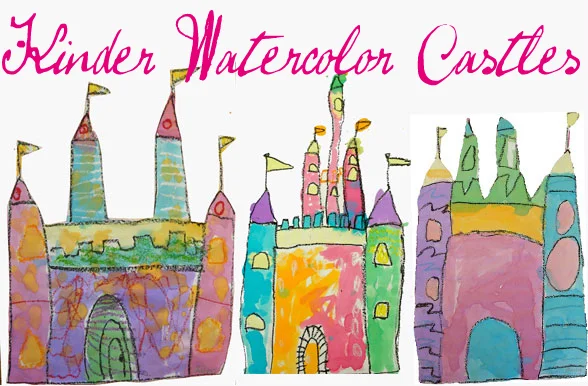
Castle Art involves creating a visual representation of a castle using various art materials. Students can use paper, cardboard, paint, markers, and other supplies to construct their castle.
Learn more: Deep Space Sparkle
13. Color Wheel Flowers
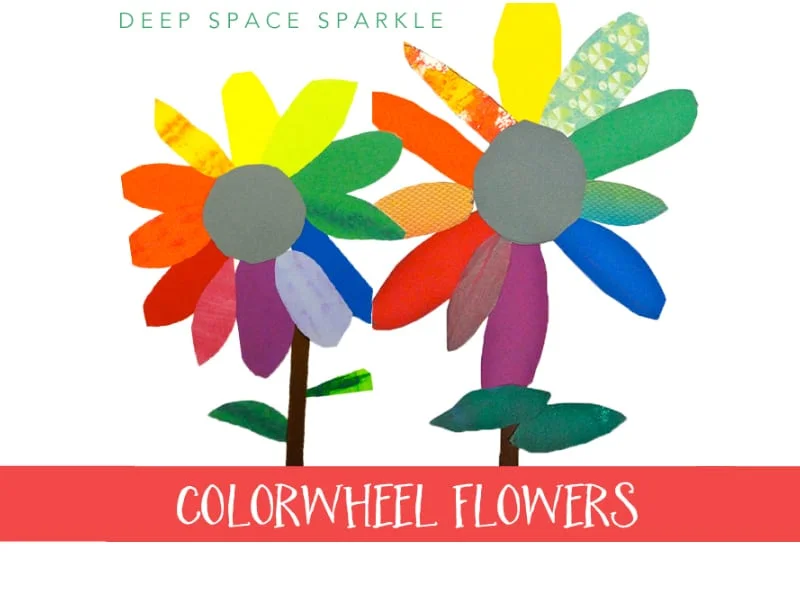
Color Wheel Flowers is a creative art project where students use the concept of a color wheel to design and paint flowers. By selecting and arranging colors in a circular pattern reminiscent of a color wheel, students can experiment with color combinations and relationships.
14. Scribble Art
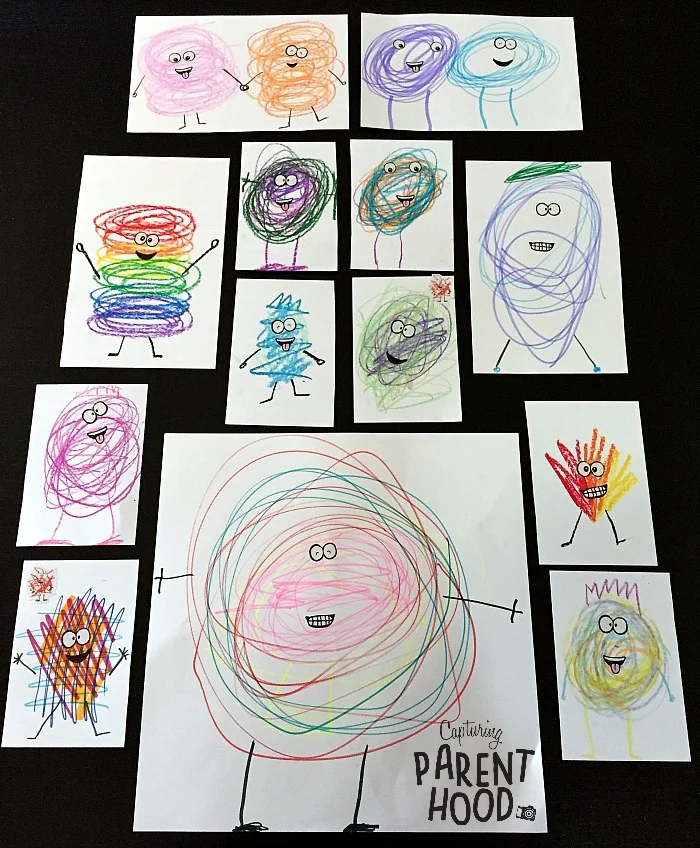
Scribble Art is a spontaneous and imaginative art activity where students create artwork by making random scribbles on paper or other surfaces.
Learn more: Capturing Parenthood
15. Clay Turtle
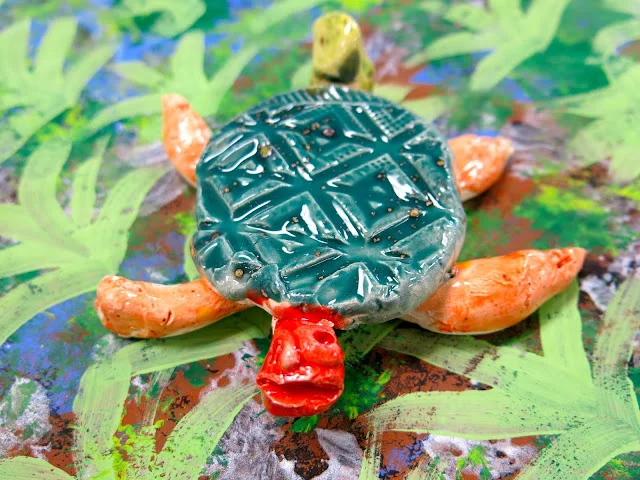
Clay Turtle is not just an art project; it’s a hands-on exploration of textures and shapes, sparking creativity in every twist and turn. So, grab that clay, let the sculpting magic begin, and watch your little turtles waddle into a world of artistic delight!
16. Build a Dino
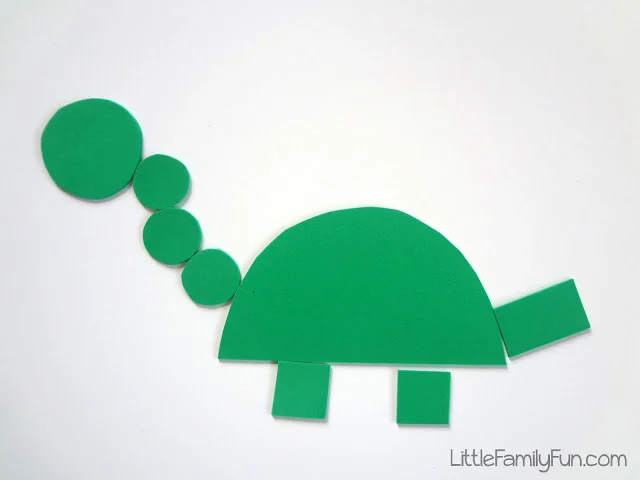
Preschoolers, get ready to unleash your inner paleontologist as you build and design your very own dinosaurs. It’s not just crafting; it’s a journey into the land of the dinosaurs, where creativity meets imagination.
Learn more: Little Family Fun
17. Salt Paintings
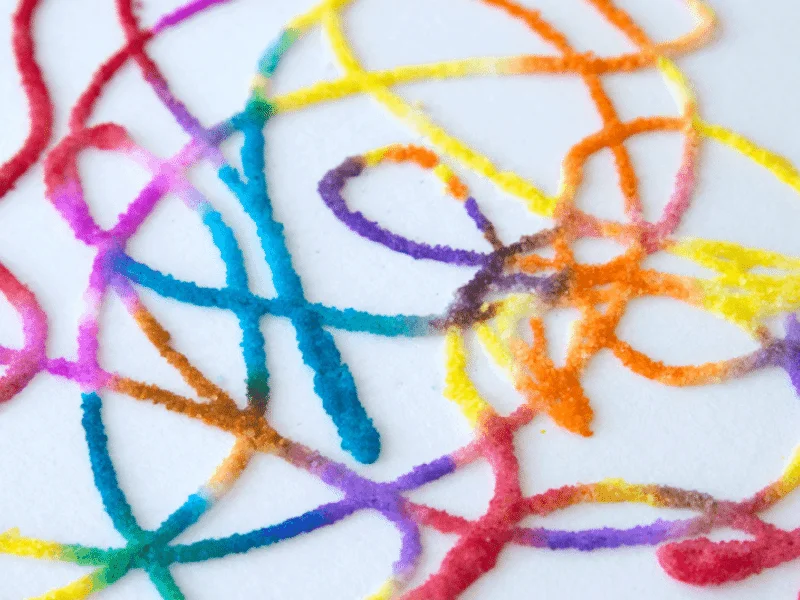
Sprinkle some excitement into your preschool art time with Salt Paintings an electrifying activity that adds texture and pizzazz to your masterpiece! Preschoolers, grab your paintbrushes and explore the magic of salt as it transforms ordinary watercolor paintings into dazzling, crystallized wonders.
Learn more: Artful Parents
18. Foil-Printed Moon Craft
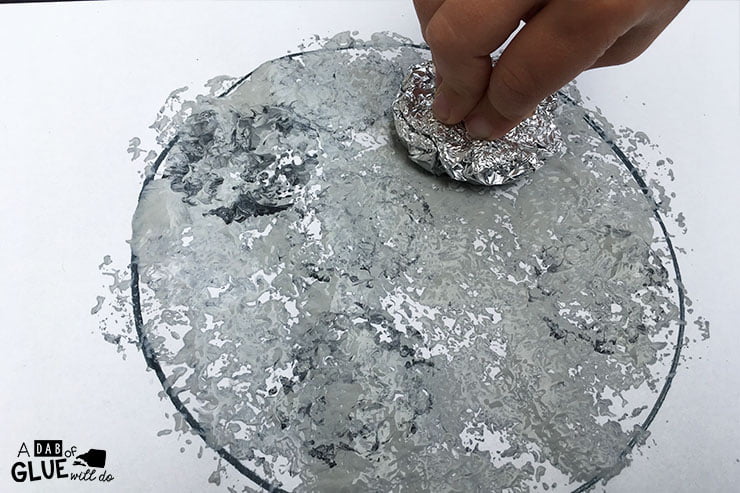
The Foil-Printed Moon Craft involves creating a lunar-themed artwork using foil and other art supplies. Students can design and shape the moon’s surface on paper using crumpled foil, exploring texture and form.
Learn more: A Dab of Glue
19. Cat Craft
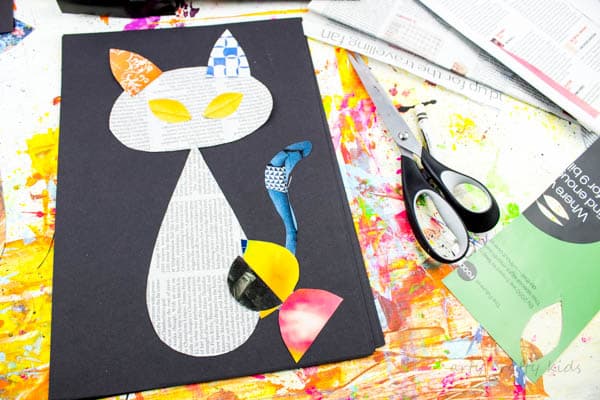
The Cat Craft involves creating a cat-themed art project using various materials. Students can use paper, cardboard, paint, markers, and other craft supplies to craft their feline creation.
Learn more: Arty Crafty Kids
20. Paper Roll Scribblers
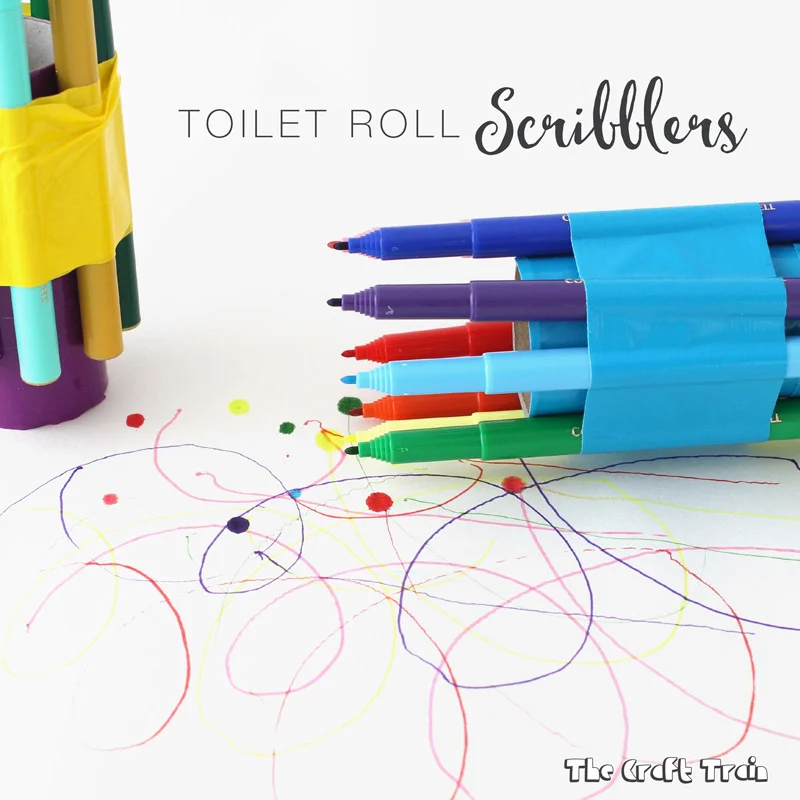
It’s not just about making marks on paper; it’s a journey where every twist and turn of the roll creates whimsical patterns and designs.
Learn more: The Craft Rain
21. Exploding Hearts
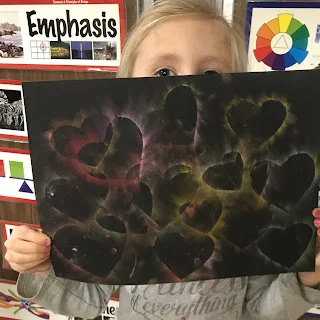
The Kindergarten Exploding Hearts activity involves a creative art project where students design and craft hearts that seem to “explode” with vibrant colors. Using materials like paper, paint, and possibly glitter, children can create dynamic and visually engaging heart shapes.
Learn more: Elements of Heart Room
22. An Alphabet Yarn Craft
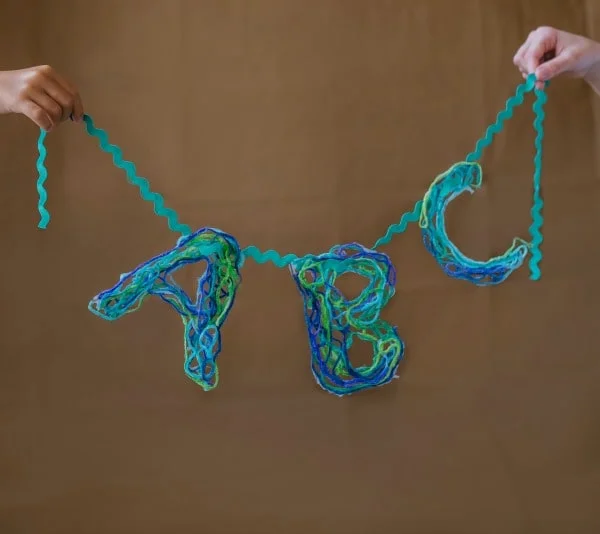
In this activity kids craft engaging letters with glue and string. Once completed, these can be ideally displayed in alphabetical order for additional practice with letters.
Learn more: Premeditated Leftovers
23. Crumpled Paper Art for Kids
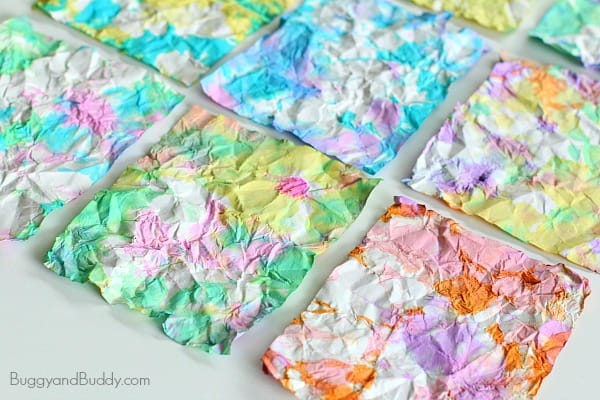
Crumpled Paper Art for Kids is a creative and hands-on activity where children crumple paper to create unique and textured artwork. Students can experiment with different colors, sizes, and shapes of crumpled paper to form imaginative compositions.
Learn more: Buggy and Buddy
24. No Mess Art
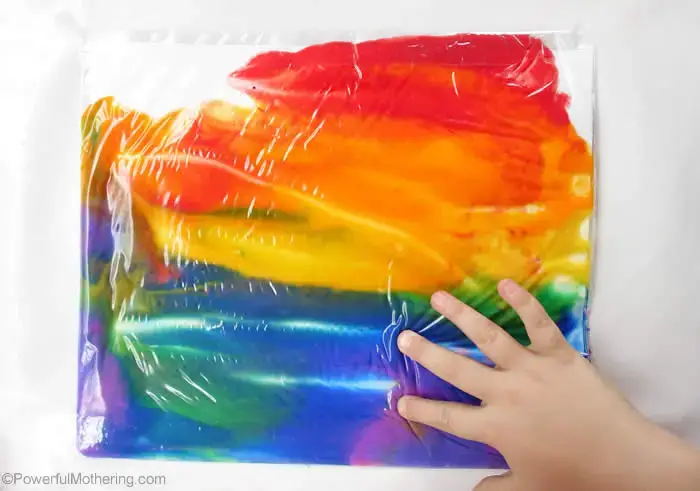
No Mess Art brings the joy of colors without the cleanup stress, making it a perfect blend of creativity and convenience. So, grab those Ziplock bags, let the color exploration begin, and watch your preschoolers create a mess-free gallery of artistic wonders!
Learn more: Powerful Mothering
25. Balloon Stamping
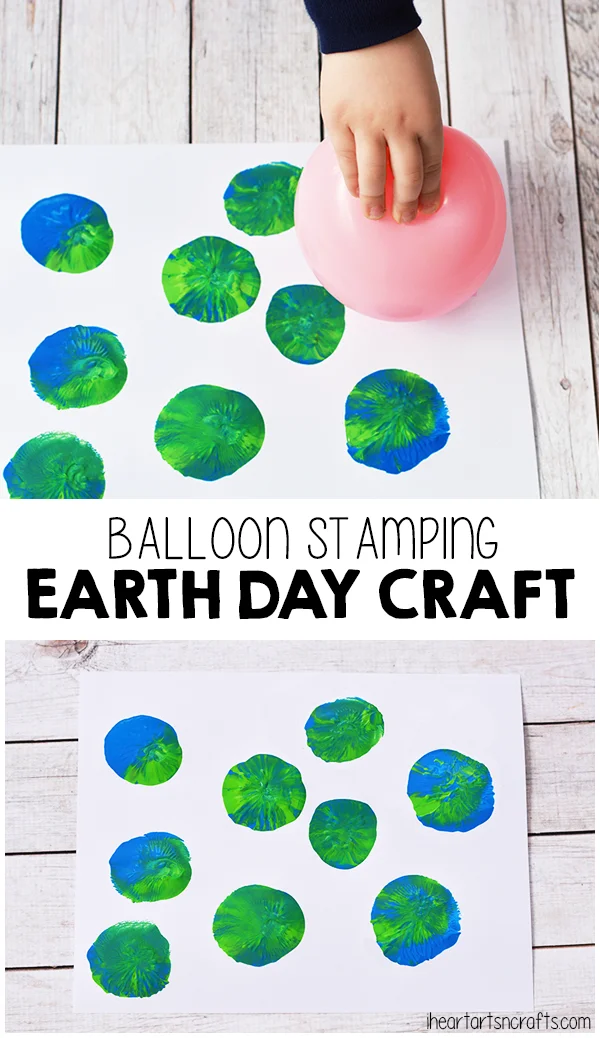
Balloon stamping is a creative art technique where students use balloons to stamp patterns and designs onto paper or other surfaces. By dipping the inflated balloons into paint and then pressing them onto the canvas, students can experiment with colors and shapes.
Learn more: I HeartsnCrafts
26. Painting with Yarn
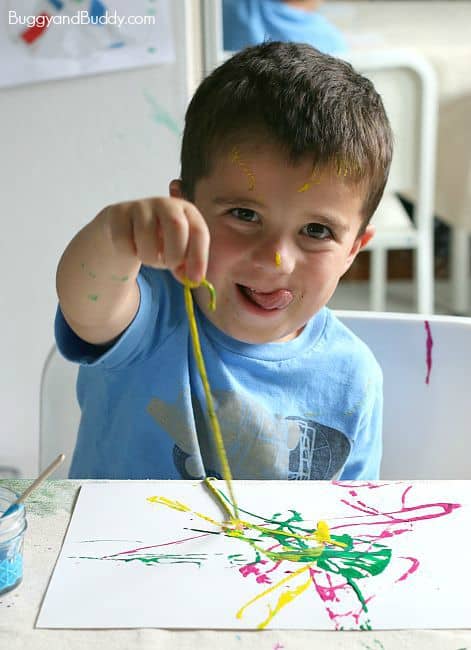
Painting with yarn is a creative art technique where students use yarn to create textured patterns and designs on paper or other surfaces. By dipping the yarn into paint and then dragging or pressing it onto the canvas, students can experiment with colors, shapes, and lines.
27. Shape Garland
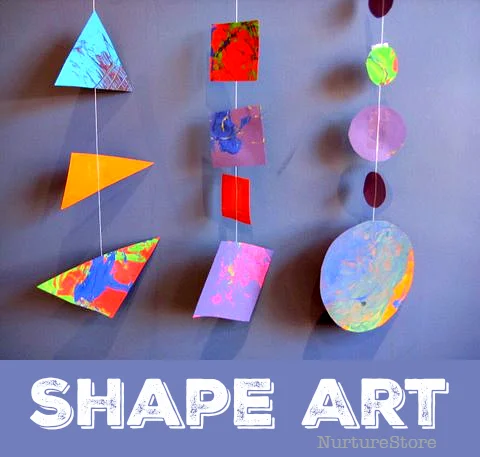
Transform your space into a celebration of shapes and colors with the Shape Garland a delightful art activity that turns simple shapes into a whimsical decoration!
Learn more: Nurture Store
28. Process Art Craft Stick Rainbow
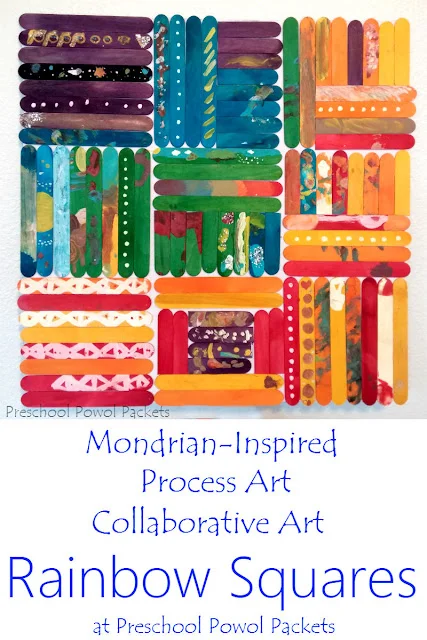
Process Art Craft Stick Rainbow celebrates the joy of creativity and self-expression, making each rainbow as unique as the little artist creating it. So, grab your craft sticks, let the colors flow, and watch your preschoolers craft a rainbow of pure artistic delight!
Learn more: Pre-school Powol Pockets
29. Giant Crayon Craft
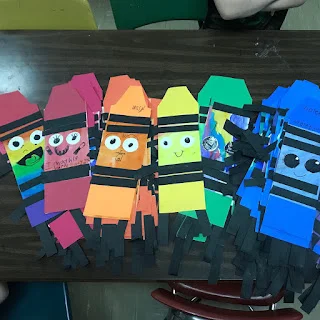
Show your inner artist on a larger-than-life canvas with the Giant Crayon Craft an exciting adventure that transforms ordinary materials into colossal bursts of color!
Learn more: Elements Heart Room
30. Paint with Bubble Wrap
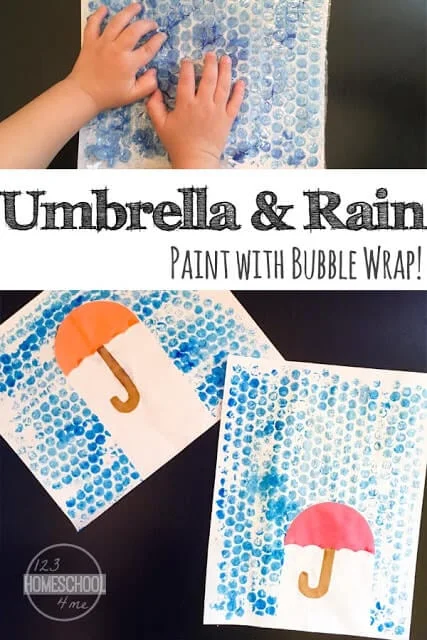
Get ready to dip, press, and pop your way to colorful masterpieces. It’s not just about painting; it’s a tactile journey where bubble wrap becomes a tool for exploring texture and patterns.
Learn more: 123homeschool 4me
31. Corn Painting
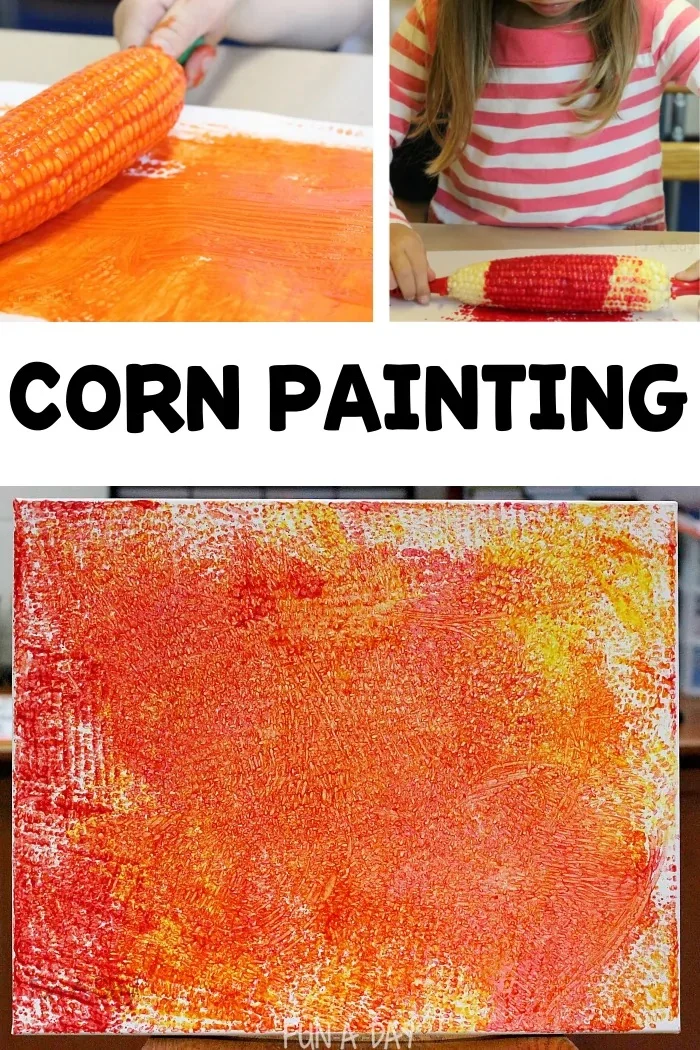
Engage young minds in a colorful adventure with Corn Painting! This preschool shape activity combines the joy of artistic expression with the tactile experience of painting using corn as a unique tool.
Learn more: Fun a Day
32. Sweet Potato Stamps
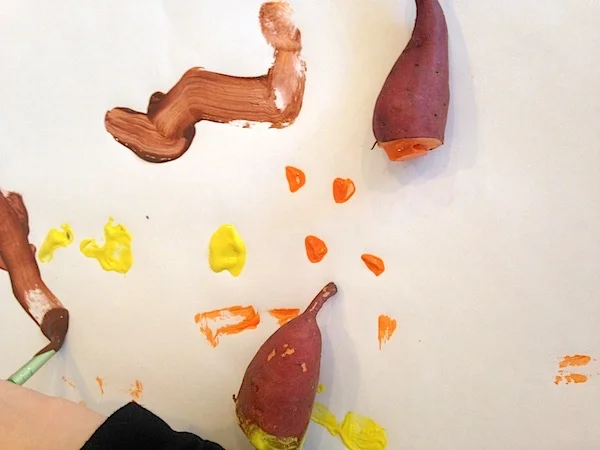
Unlock creativity with Sweet Potato Stamps in this delightful preschool shape activity! By carving various shapes into sweet potatoes and dipping them into bright, washable paints, young artists can explore a world of patterns and forms.
Learn more: Sunny Family Da
33. Roll Painting with Autumn Materials
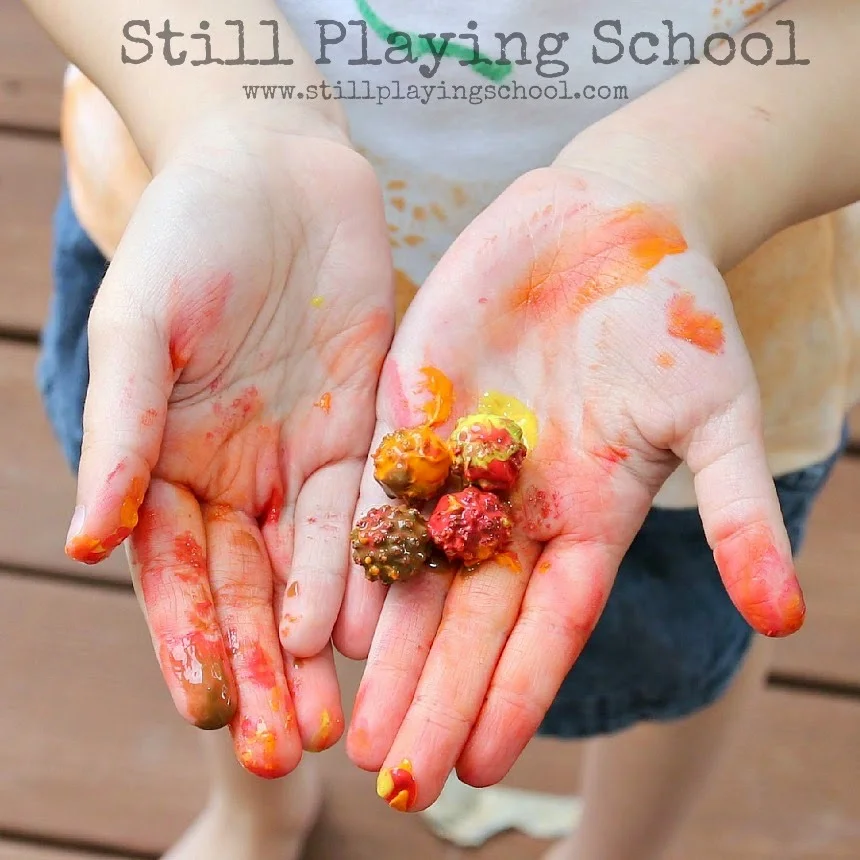
Roll painting with autumn materials is a creative art activity where students use objects associated with fall to roll and create textured patterns on paper.
By rolling items like acorns, pinecones, or leaves dipped in paint, students can experiment with colors and shapes, adding a seasonal touch to their artwork.
Learn more: Still Playing in School
34. Messy Art
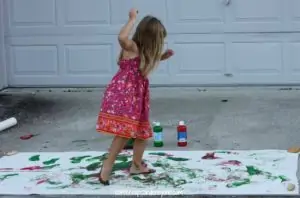
Through finger painting, splattering, and squishing, children not only discover the beauty of different shapes but also enhance their sensory experiences and fine motor skills.
Learn more: How We Learn
35. Oil and Water Painting
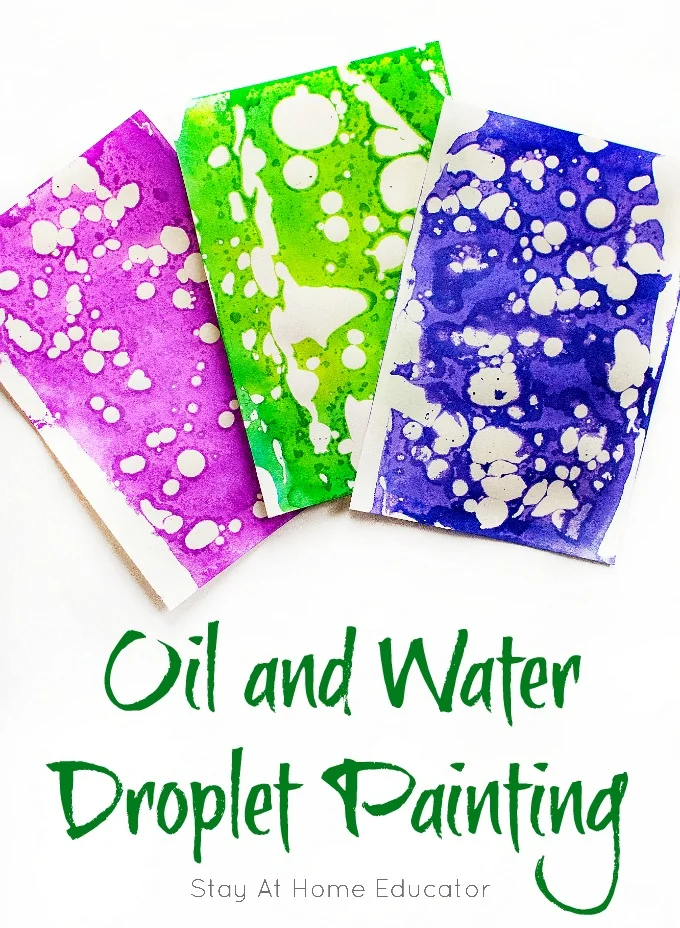
Oil and water painting is a creative art technique where students use the interaction between oil and water to create unique and vibrant designs on paper. By applying watercolors to a surface and then adding drops of oil on top, students can observe the intriguing patterns that emerge as the two substances repel each other.
Learn more: Stay at home Educator
36. Fly Swatter Painting
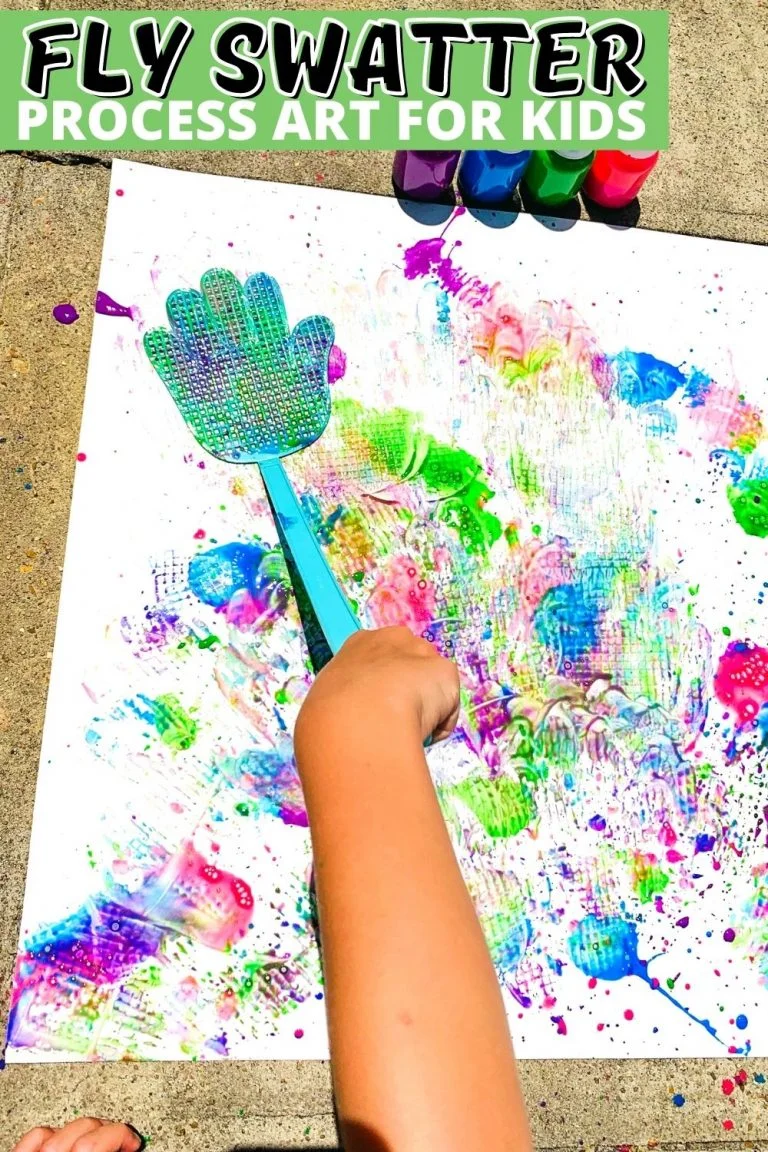
Fly swatter painting is a dynamic and creative art activity where students use fly swatters as painting tools to create expressive and textured artwork. By dipping the fly swatters into paint and then swatting them onto paper or canvas, students can experiment with colors, patterns, and movement.
Learn more: Little Bins for Little Hands
37. Coffee Filter Rainbow Craft
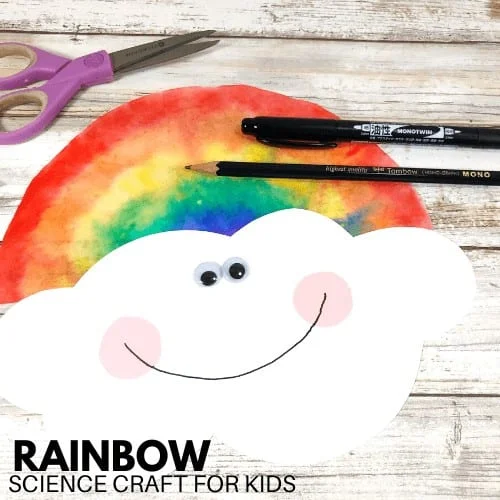
The Coffee Filter Rainbow Craft is a creative and hands-on art project where students use coffee filters to create vibrant rainbow designs. By using watercolor markers or liquid watercolors, students can add color to the coffee filters, and when water is applied, the colors blend and spread, creating a beautiful rainbow effect.
Learn more : Little Bins for Little Hands
38. Paper Marbling with Shaving Cream
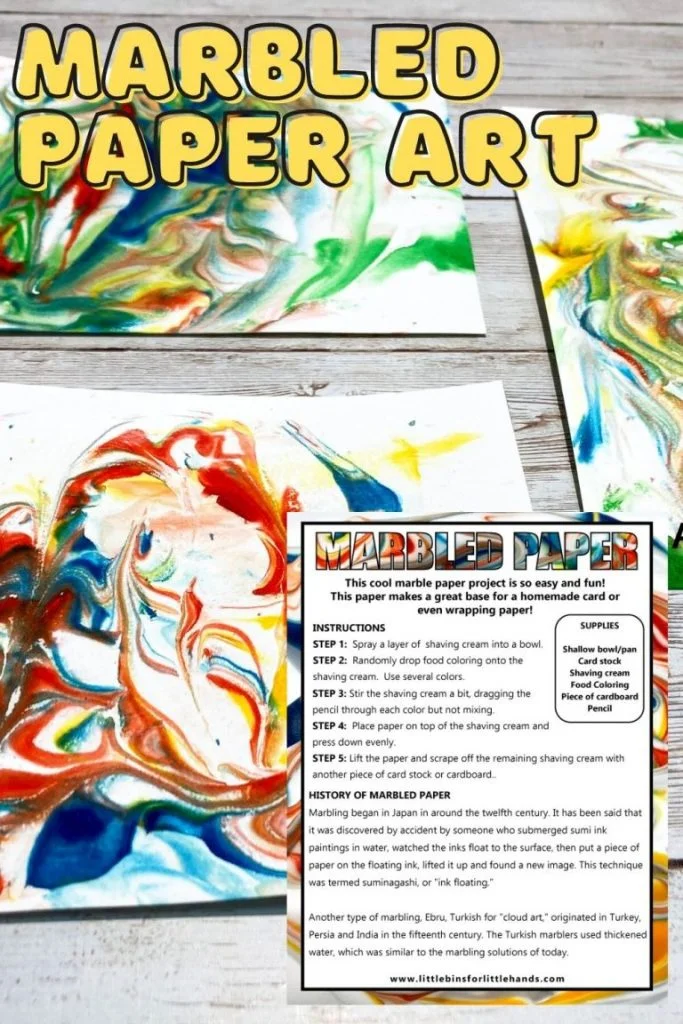
Paper marbling with shaving cream is a creative and sensory art activity where students use shaving cream and liquid watercolors to create unique and marbled patterns on paper.
39. Make Sun Prints for Outdoor STEM
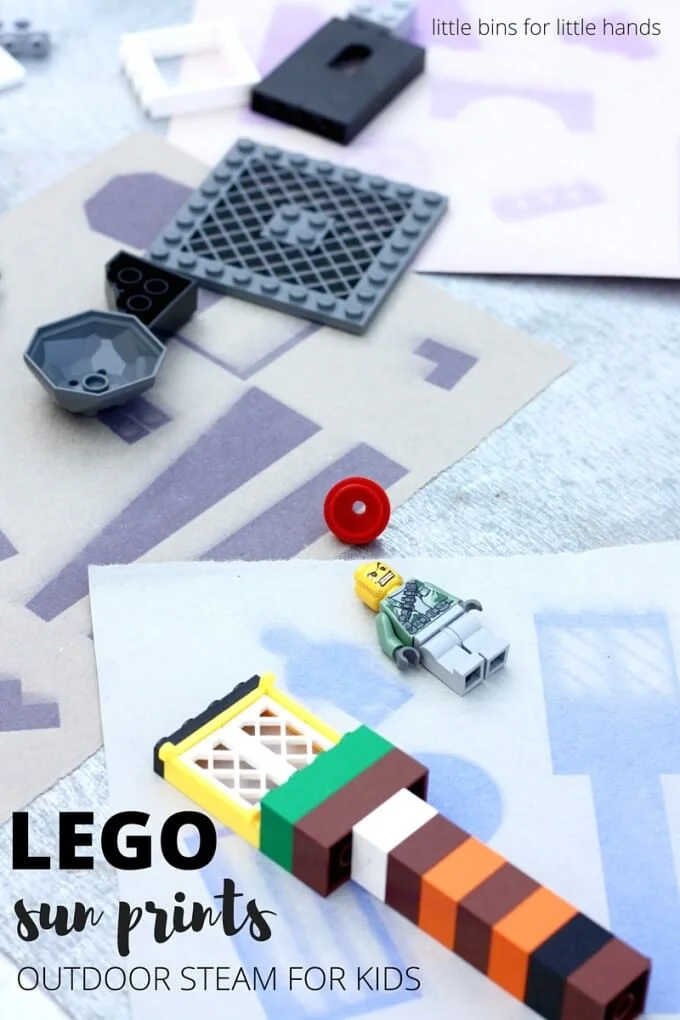
This activity involves creating LEGO sun prints outdoors, combining art and science to explore light and shadows. Students build LEGO structures on sun print paper exposed to sunlight, producing silhouettes as a result of a chemical reaction.
40. Colorful Painting with Ice Cubes
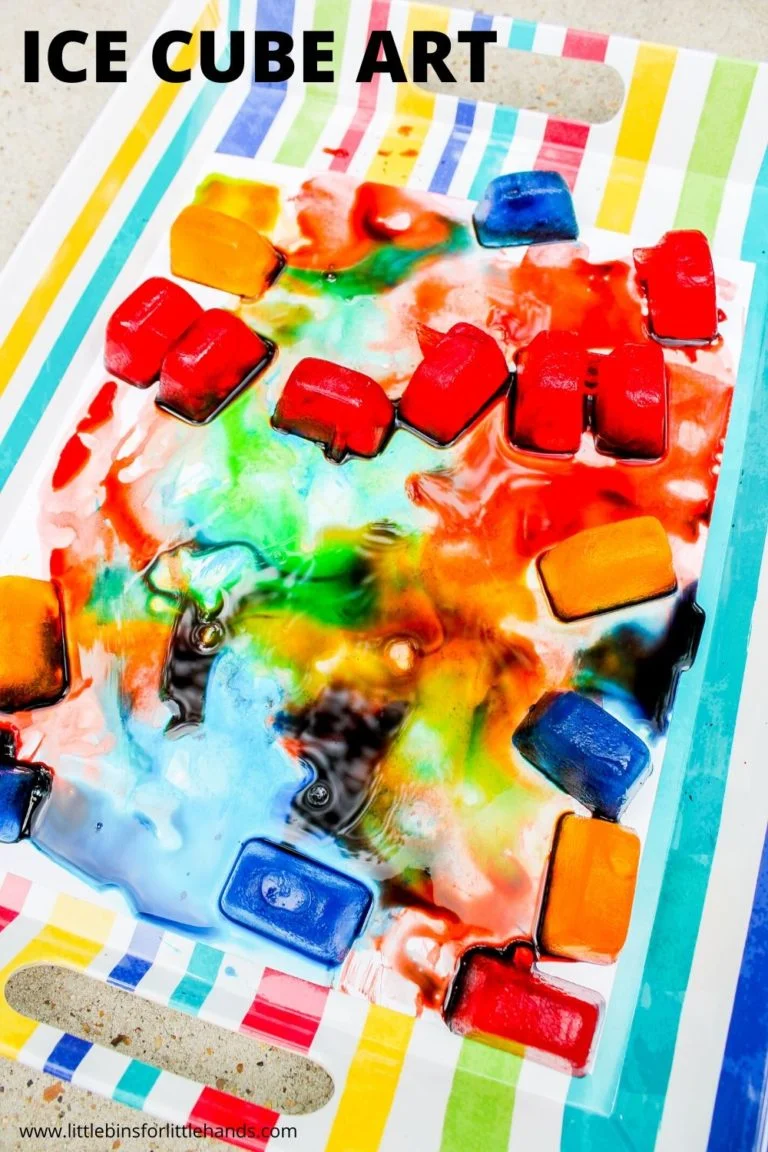
Colorful painting with ice cubes is a sensory art activity where students use frozen, colorful ice cubes as unconventional paintbrushes. By applying the melting ice cubes to paper or canvas, students create vibrant and dynamic artwork with swirling patterns
41. Nature Weaving with Found Object Art
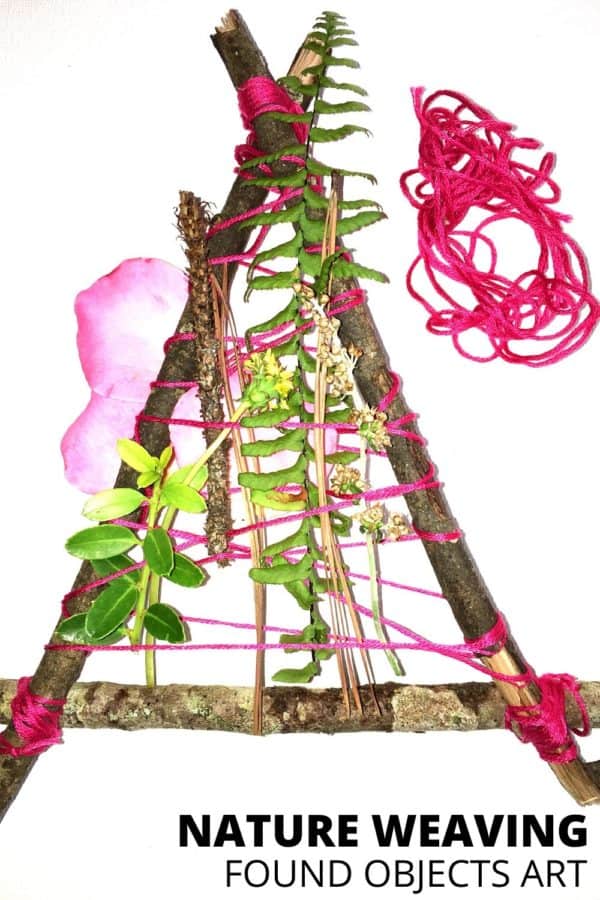
Nature weaving with found object art is a creative activity where students use natural materials and found objects to weave intricate designs. By incorporating items like twigs, leaves, and feathers into a weaving structure, students blend art and nature.
42. Pinecone Painting
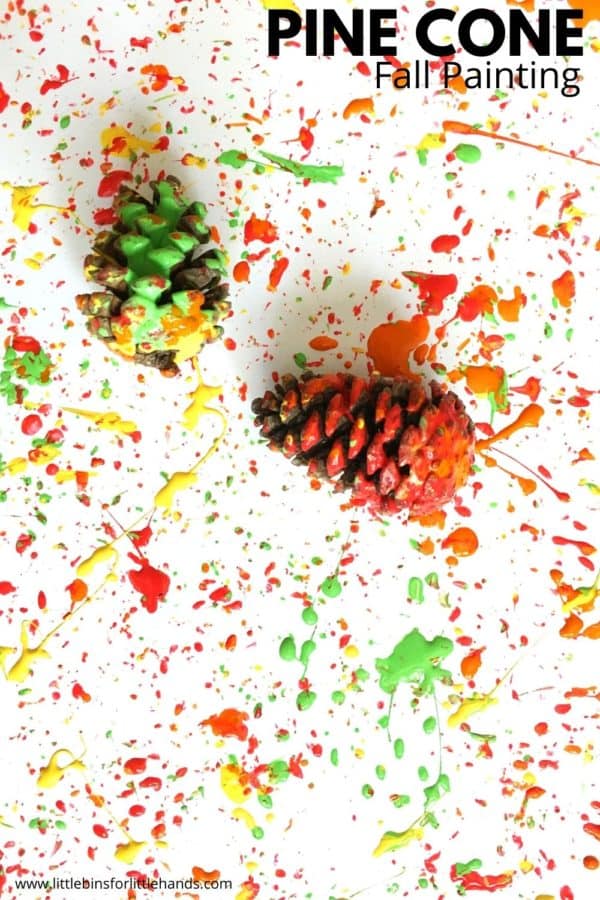
Pinecone painting is a creative art activity where students use pinecones as painting tools to produce textured and nature-inspired artwork. By dipping the pinecone scales into paint and pressing them onto paper or canvas, students can explore different patterns and designs.
43. Easy Paper Sculptures for Kids
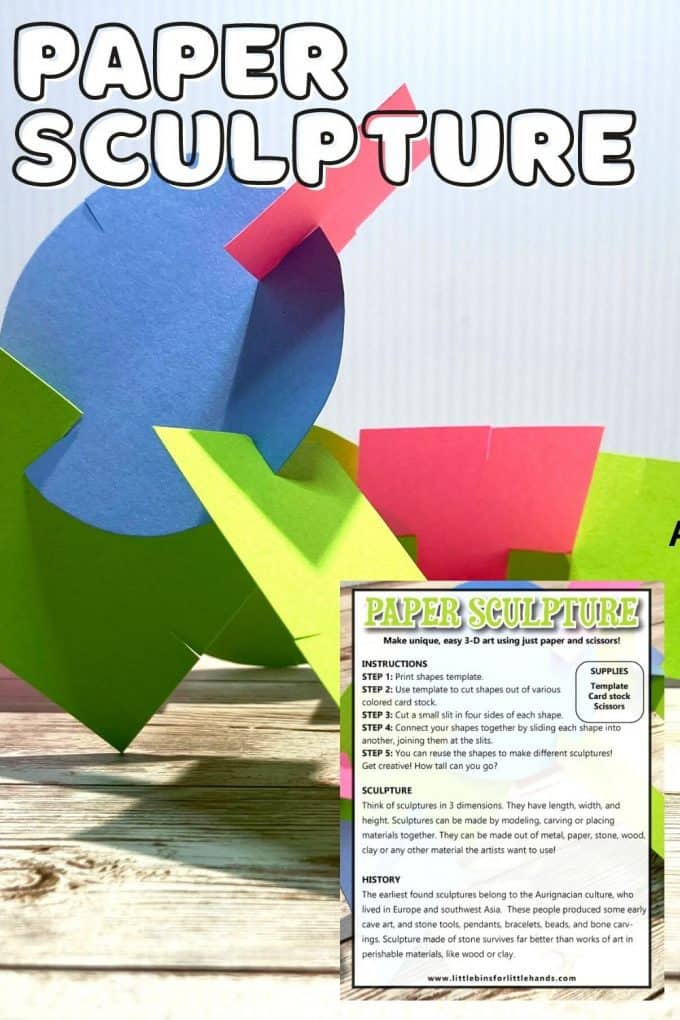
Creating easy paper sculptures for kids is a hands-on art activity that encourages creativity and fine motor skills. Children can use simple materials like colored paper, scissors, and glue to craft three-dimensional sculptures.
44. Cool Paper Towel Art for Kids
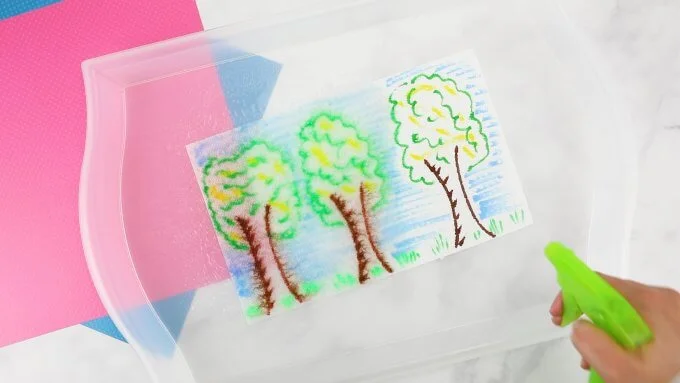
Cool Paper Towel Art for Kids is a creative and accessible activity where children can use paper towels as a unique canvas for artistic expression. By applying watercolor markers or diluted food coloring onto folded or unfolded paper towels, kids can create vibrant and dynamic designs as the colors spread and blend.
45. Super Fun Salad Spinner Art
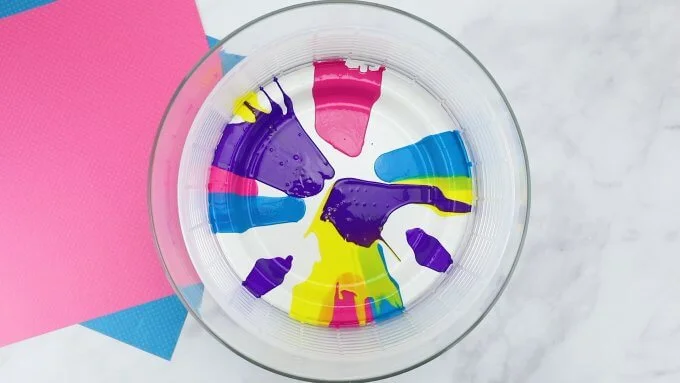
Super Fun Salad Spinner Art is an entertaining and creative activity for kids that involves using a salad spinner as a unique tool for creating dynamic and abstract artwork. By placing paper and paint inside the salad spinner and giving it a spin, children can observe the mesmerizing patterns and designs that emerge.
46. Paint A Color Wheel with Skittles Paint
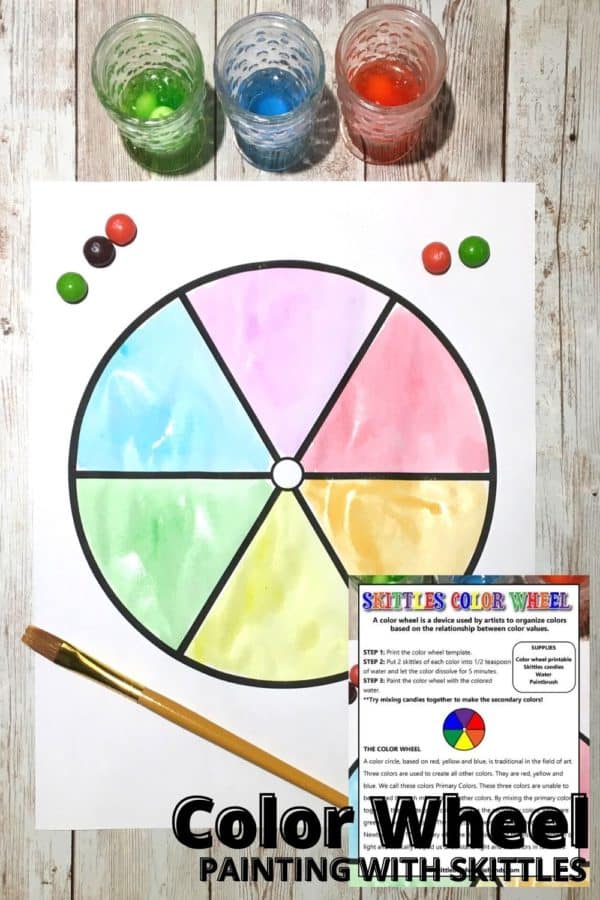
Painting a color wheel with Skittles paint is a creative and engaging activity where students use Skittles candies to explore color mixing. By arranging Skittles in a circle on a plate or paper and adding a drop of water to each candy, students can observe the colors dissolve and blend, creating a vibrant edible color wheel.
47. Snow Paint Spray for Winter Art

This unique outdoor adventure allows children to spray colorful water onto snow, creating beautiful and temporary winter art. Not only does it introduce them to basic shapes and colors, but it also encourages outdoor play and exploration.
48. Snowflake Art for Preschool

Let creativity sparkle with ‘Snowflake Art for Preschool’ an enchanting activity that brings the magic of winter indoors! Children can explore shapes and patterns by crafting unique snowflakes using various materials.
49. Paint Splatter Art for Kids
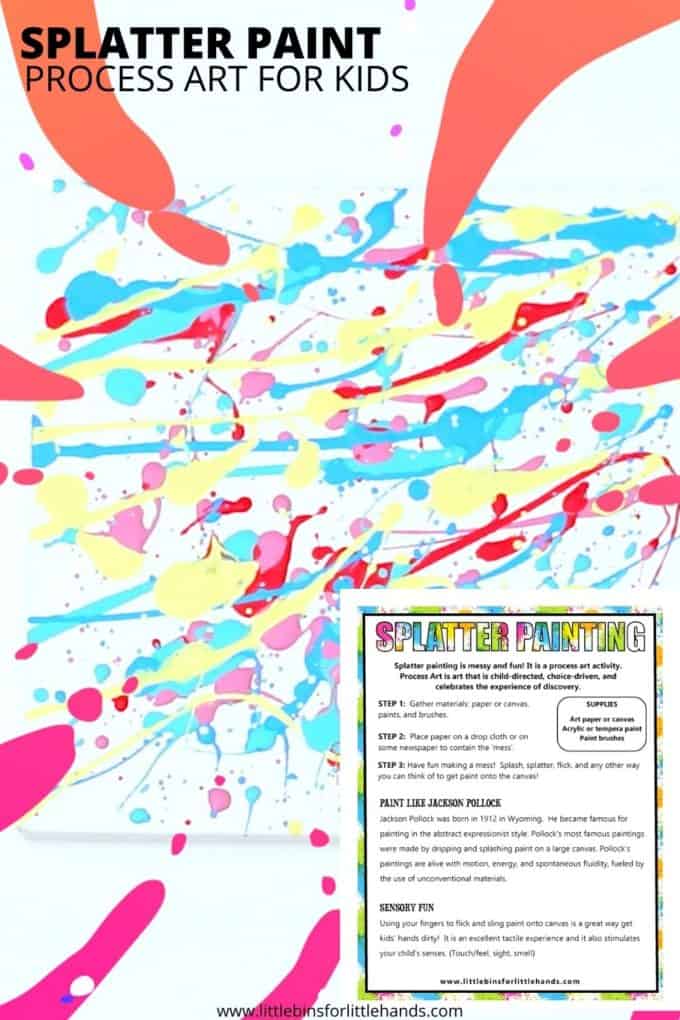
Paint splatter art for kids is a lively and expressive activity where children use various tools to create dynamic and colorful splatters on paper or canvas. By flicking or tapping paintbrushes, toothbrushes, or other implements, kids can experiment with different techniques to achieve unique and abstract designs.
50. String Painting
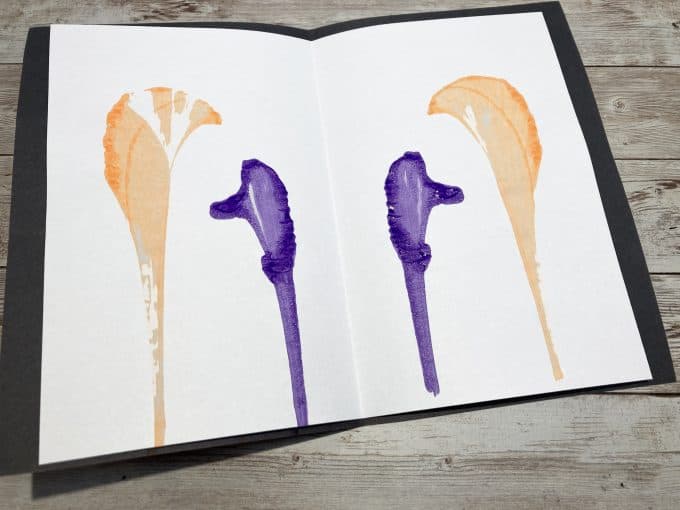
String painting is a creative art technique where artists use strings to create unique and textured designs on paper or canvas. By dipping strings into paint and laying them onto the surface, artists can pull, drag, or lift the strings to form intricate patterns.
51. Colorful Water Drop Painting
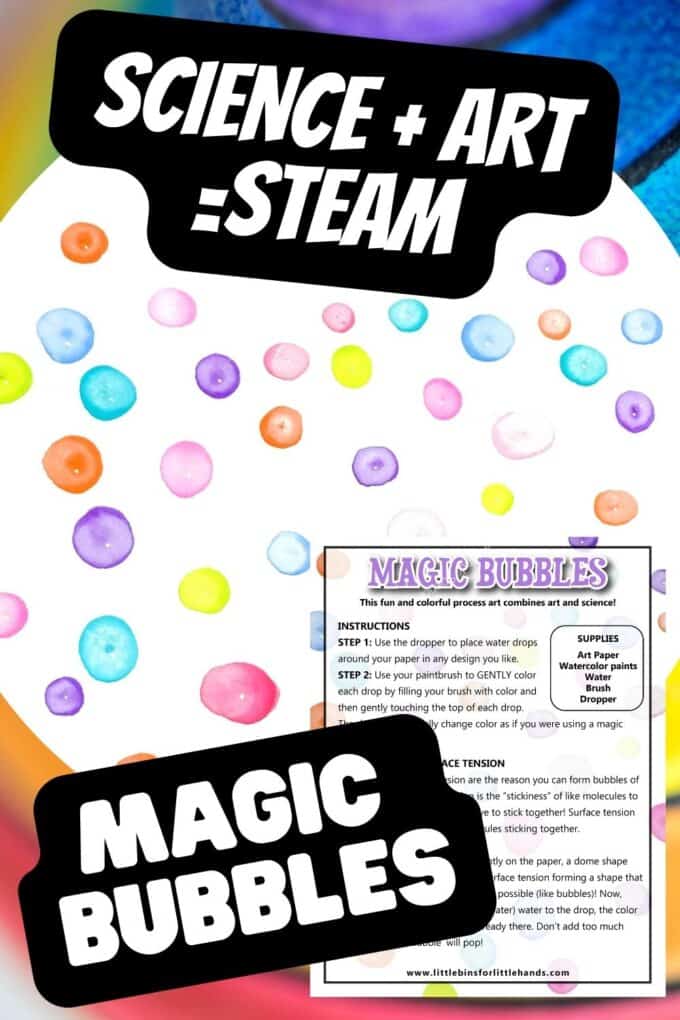
Colorful water drop painting is a captivating art activity where individuals use droppers or pipettes to release colorful water onto paper or absorbent surfaces. By dropping various watercolor hues onto the canvas, participants can observe the blending and diffusion of colors, creating vibrant and abstract designs.
52. Water Gun Painting
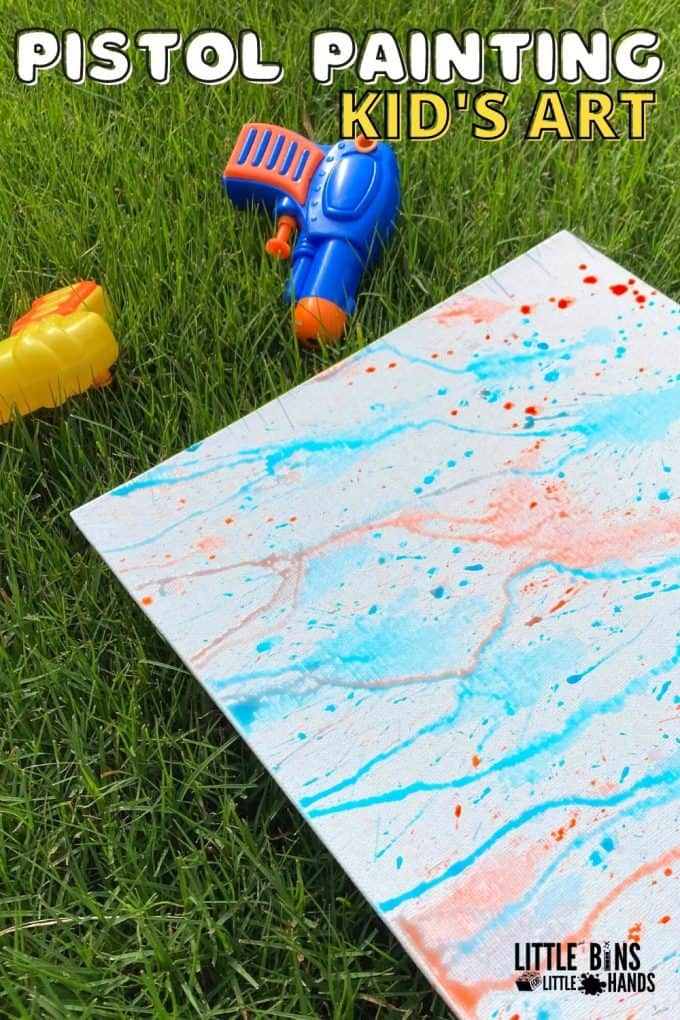
Water Gun Painting is a delightful and refreshing way for preschoolers to express themselves artistically while enjoying the excitement of water play. Watch as each burst of color becomes a joyful expression of creativity in this lively and engaging art adventure!
53. Paint Blowing
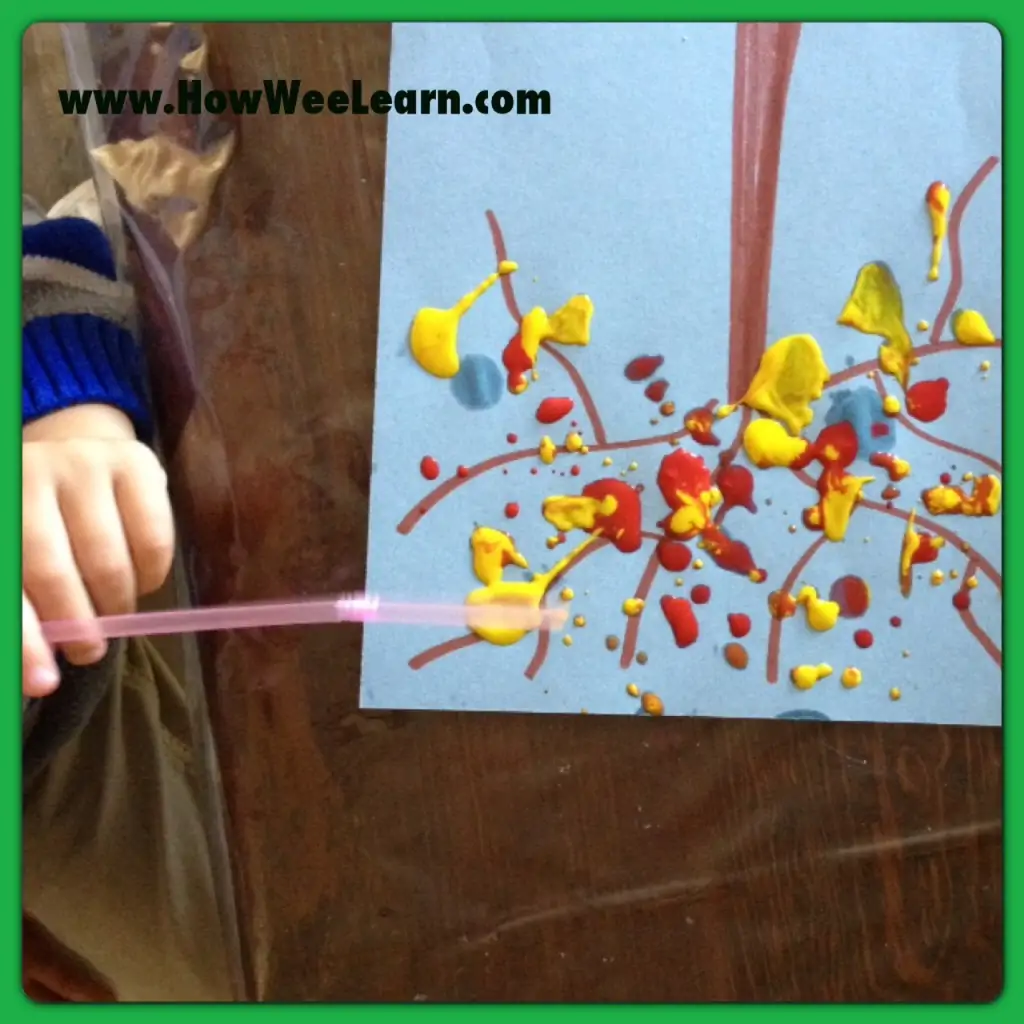
Paint blowing is a dynamic and creative art technique where artists use air to disperse liquid paint across a surface. By blowing air through a straw or other tool, individuals can create abstract and visually interesting patterns.
Learn more: How we Learn
54. Rainbow Lighting
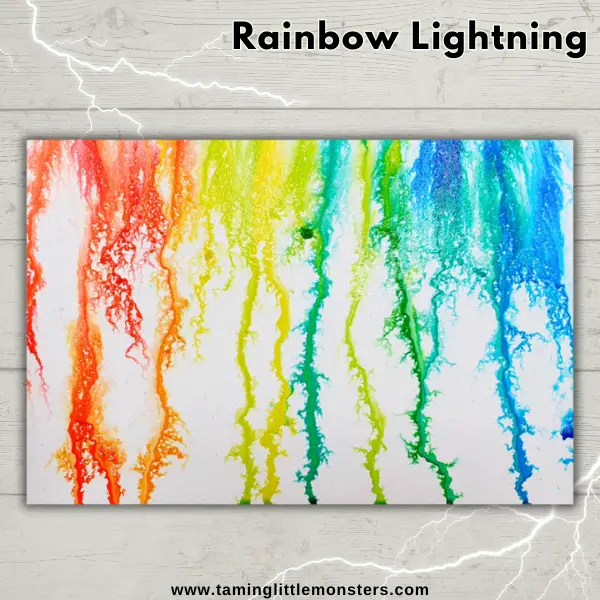
Rainbow lighting refers to the use of various colored lights to create a vibrant and dynamic display resembling the colors of a rainbow. This lighting technique is often employed in artistic installations, stage productions, or decorative settings to evoke a visually striking and immersive experience
Learn more: Taming Little Monsters
55. Spaghetti Paintbrushes
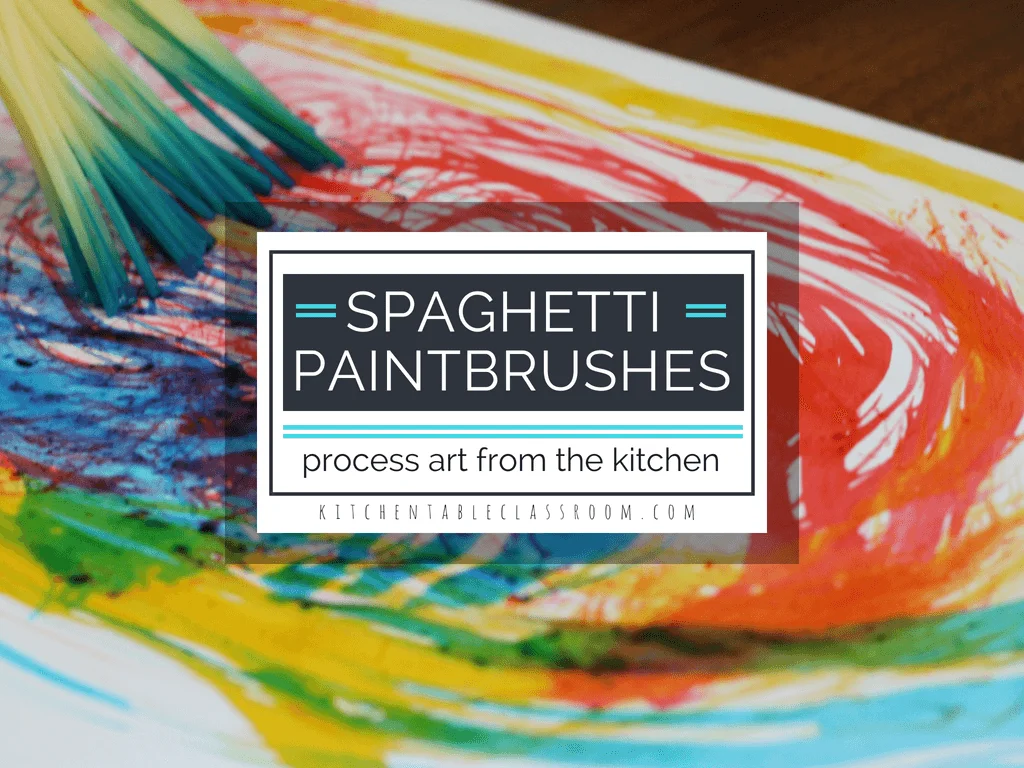
Children can explore shapes and colors by using cooked spaghetti as paintbrushes, creating textured and unique masterpieces.
Learn more: Kitchen Table Classroom
56. Spiderweb Sun Catcher
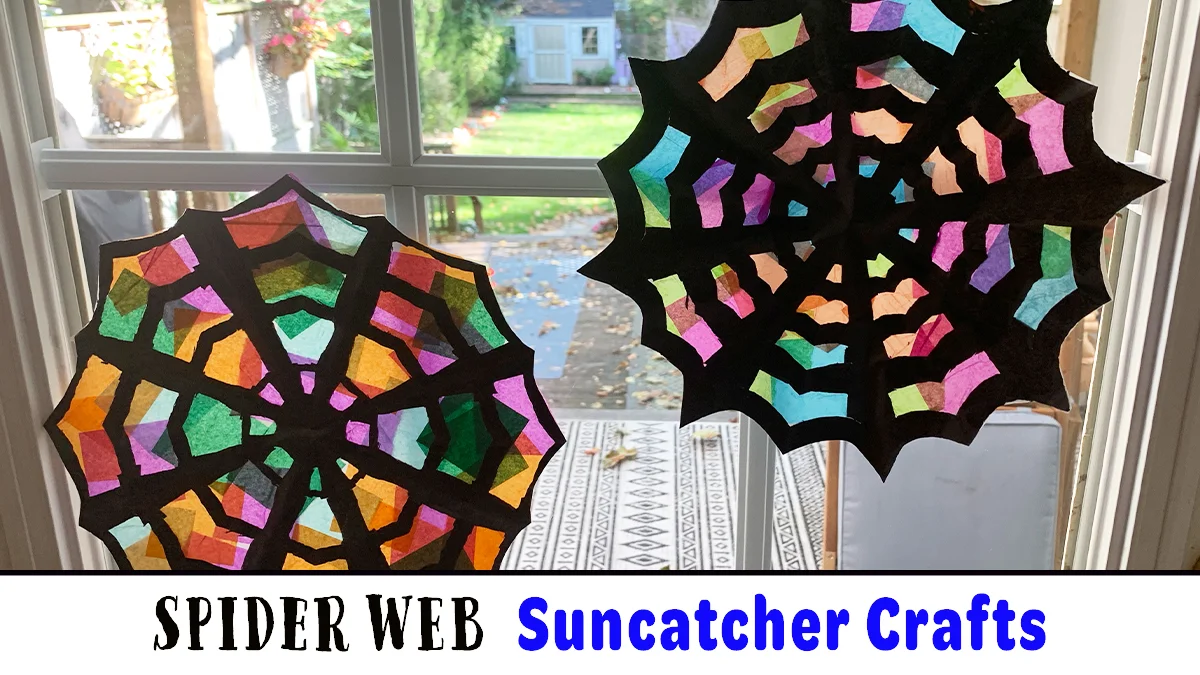
Craft a web of wonder with ‘Spiderweb Sun Catcher’ an engaging and artistic preschool activity that transforms simple materials into beautiful decorations! Children can explore shapes and patterns by weaving yarn or string around a hoop to create a spiderweb design.
Learn more: Happy Toddler Playtime
57. Shower Curtain Painting
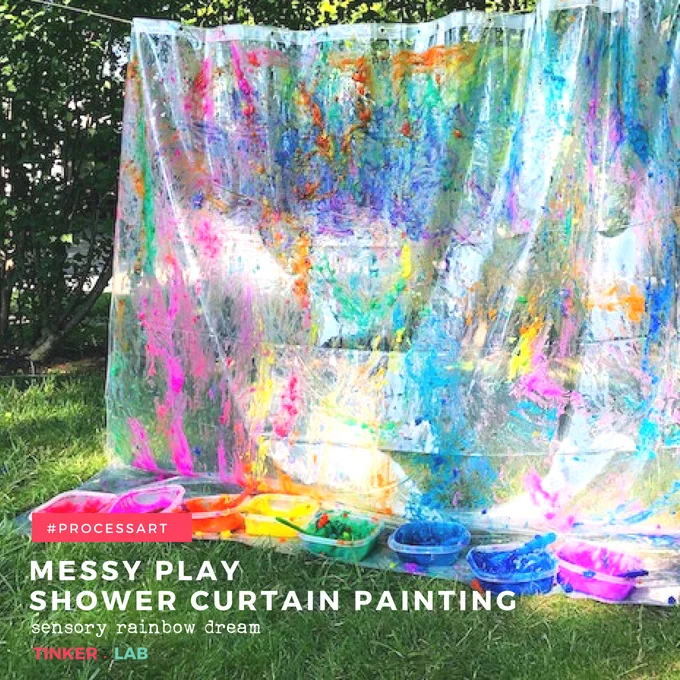
Children can explore shapes and colors as they paint vibrant designs on a large shower curtain. This hands-on experience not only introduces young minds to basic shapes but also fosters gross motor skills and encourages collaborative play.
Learn more: Tinker Lab
58. Embossed Tin Leaves
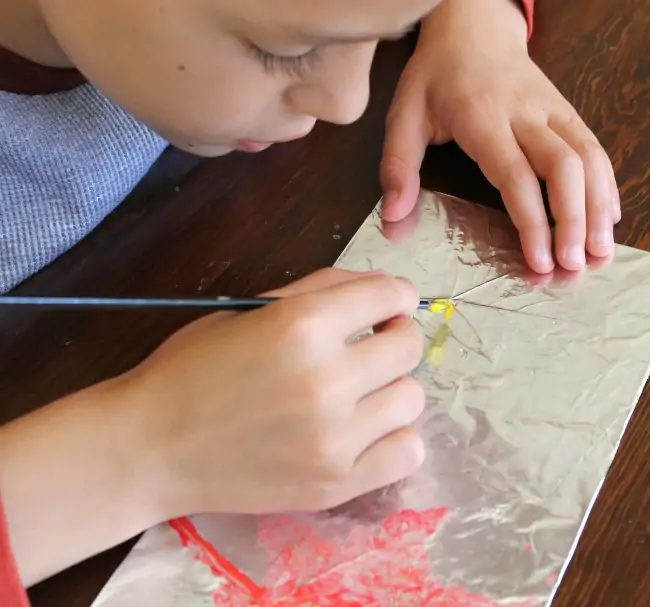
Embossed tin leaves involve a creative craft where students use tin foil or thin metal sheets to create textured and decorative leaf shapes. By pressing the metal against various textured surfaces or using embossing tools, students can add intricate patterns and details to mimic the veins of leaves.
Similar Posts:
- Top 100 Fine Motor Skills Activities for Toddlers and Preschoolers
- Top 47 Shape Activities for Toddlers and Preschoolers
- 68 Best Chemistry Experiments: Learn About Chemical Reactions
Leave a Comment Cancel reply
Save my name and email in this browser for the next time I comment.

Spark creativity in your students – and boost their employability
Thinking creatively is a crucial skill for the future workplace. But how can we instil it in today’s students?
Sarah Montano
.css-76pyzs{margin-right:0.25rem;} ,.

You may also like
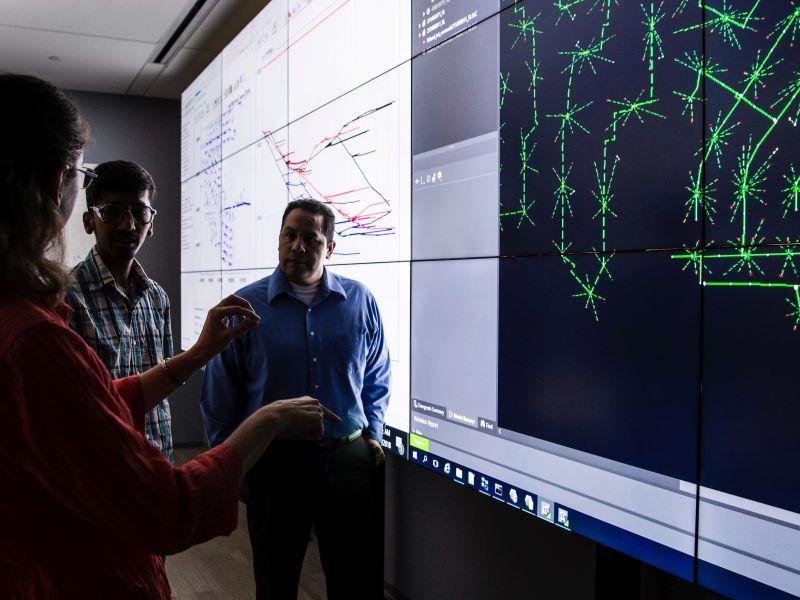
Popular resources
.css-1txxx8u{overflow:hidden;max-height:81px;text-indent:0px;} It’s time: how to get your department off X
Deepfakes are coming for education. be prepared, campus webinar: the evolution of interdisciplinarity, emotions and learning: what role do emotions play in how and why students learn, relieve student boredom by ‘activating’ lectures.
In today’s rapidly evolving job market, innovation and creativity have become crucial skills for graduates . Our research has shown that employers are looking for employees who can think outside the box, adapt to change and devise innovative solutions to complex problems. As educators, we play a vital role in preparing students for these challenges by enabling creativity within curricula . Here, we will explore the importance of innovation and creativity in graduate jobs and discuss how educators can facilitate creativity through innovative teaching and assessment techniques.
Innovation and creativity go hand in hand with problem-solving. When faced with challenges, individuals who can think creatively are more likely to come up with effective solutions and be better at adapting to changing circumstances. Employers in industries such as services, retailing, technology, design, marketing and entrepreneurship highly value the ability to think creatively and come up with innovative ideas. This approach also instils a sense of responsibility and accountability .
- How to embed creativity more fully into university curricula
- Making space for creativity in higher education
- Five ways to apply a creative mindset to education
But how can educators foster creativity in their students? Traditional teaching methods often prioritise theoretical learning and standardised assessments, generally geared towards certain answers and leaving little room for creativity to flourish.
In our authentic assessment , students are expected to develop a competitive and innovative product as the outcome of their theoretical learning, which is applied to a real-life challenge. We argue that an experiential learning approach enables students to gain future skills and help them develop confidence, autonomy, self-governance and better learning opportunities . Experiential learning is different from theoretical learning as it focuses on behavioural changes through experiencing real-world challenges, rather than theoretical cognition . Students can be given the opportunity to design new shops, create adverts and solve challenges, such as designing sustainable packaging. Using the various media, students can also demonstrate their creative work and innovations to potential employers .
We often see that this task can be daunting to our students from non-marketing academic backgrounds. Taking this on board, we offer a supportive environment to scaffold student learning, helping them to feel comfortable to “think outside the box” and demonstrate their creativity.
Our process has a few simple elements. We use small-group dynamics to allow students to build on their strengths, offering constructive formative feedback while taking turns to give them different perspectives, and we use innovative digital tools that they can adopt.
Here are three ideas that have helped us spark creativity in our lessons:
- Embrace AI: Today’s students will need to work in AI-induced environments . Bringing AI platforms to the classroom will help students learn how to use them while showcasing their experience in authentic assessments. By incorporating AI into the curriculum, educators can create a dynamic and engaging learning environment that encourages students to think critically and creatively .
- Introduce Lego Serious Play : This methodology uses Lego bricks as a tool for creative thinking and problem-solving. It’s particularly successful at the start of the creative process as Lego breaks down barriers and, by being fun and enjoyable, enables students to communicate their ideas in a simple visual format. Students are encouraged to build models that represent their ideas and concepts, allowing them to explore different perspectives. Lego Serious Play promotes collaboration, communication and creativity, making it an effective tool for fostering innovation in business schools. Through hands-on activities and group discussions, students learn to work together, share ideas and build upon each other’s creativity. This collaborative approach prepares them for the teamwork and interdisciplinary collaboration required in the modern workplace.
- Focus on the product: Authentic assessments not only foster creativity by focusing on the final product, but also boost learner motivation by enhancing student engagement with the subject . Students enjoy the work and prefer these assessments as they better reflect their learning and enable skill development, according to research.
In our module at Birmingham, we combine all three elements to stimulate creativity and offer students an exciting way to engage with module content. By offering a visual and creative assessment, we allow students complete freedom to design their own retail or service places, offering innovative elements to stand out in a competitive marketplace. Our motto is: “If they can think it, they can design it.” Unencumbered from traditional format restrictions, students can use a variety of digital tools to bring their visions to life. The assignment concludes with a video portfolio, showcasing their work. The students involved report increased engagement, improved problem-solving skills and a greater sense of creativity, and gain skills that they can showcase to their future employers.
Educators have a crucial role to play in fostering creativity at business schools. By integrating an innovative experiential learning approach and combing techniques such as AI, Lego Serious Play and digitalisation, educators can prepare students for future jobs and boost their employability.
Sarah Montano is professor of retail marketing and Inci Toral is associate professor at Birmingham Business School, University of Birmingham.
It’s time: how to get your department off X
Using data skills to turn students’ passion for sports into rewarding careers, a diy guide to starting your own journal, the zone of proximal development in four stages, contextual learning: linking learning to the real world, ‘it just isn’t safe to disclose’.
Register for free
and unlock a host of features on the THE site
AI Essentials Guidelines and Approaches for UTSA Students
A starting point for research, exploration and creativity.
The following approaches and guidelines serve as a starting point to exploration of Generative Artificial Intelligence (GenAI). Developed collaboratively by a team of UTSA students, faculty and staff, it provides tools and guidance aimed at developing knowledge and skills for the use of GenAI. These resources ensure all Roadrunners are prepared to use this new technology responsibly, ethically and productively during their academic careers and beyond!
The guidelines will be updated regularly, based on student and faculty experiences to adapt to changes in GenAI models and tools. Our approach emphasizes our dedication to fostering innovation while respecting individual choices.

AI Essentials: Guidelines & Approaches
Want to learn how you can leverage GenAI in building academic and career success? Launch AI Essentials, a learning module built specifically for UTSA students.
Explore opportunities and discover the potential of Generative AI

Coursera Career Academy
Earn a certificate and enhance your resume
Join the UTSA Learning Program and gain free access to career related micro-credentials in GenAI from leading industry providers like IBM and Meta. These industry-recognized credentials can help you stand out to employers.
Start earning microcredentials >>

Adobe Creative Skills
Sharpen your Adobe creative skills
As an Adobe Creative Campus, UTSA provides access to Adobe's suite of Creative tools to UTSA students. The Adobe Education team has curated these short courses to introduce you to Adobe tools in two hours or less, including on its GenAI tools. Login with your UTSA credentials to get started today!
Get started with Adobe Creative Cloud >>

LinkedIn Learning
Explore hundreds of GenAI courses across different fields
Students can access hundreds of courses that address GenerativeAI on LinkedIn Learning at no cost.
Get started on LinkedIn Learning >>

Discover the latest GenAI developments
GenAI news happens fast! Get a curated list of the latest GenAI insights, research and real-world stories from students and faculty about this transformative tech.
Read more GenAI news >>
Discover how UTSA is using GenAI for teaching and learning
Learn how the Roadrunner community is using GenAI in the classroom and in our community to build new skills, solve grand challenges and create bold futures.
Using GenAI to succeed in a digitally-connected future
Melissa Vito, Vice Provost for Academic Innovation, explains why mastering generative AI skills is crucial for today’s students and explains why you don’t need a deep technical background to succeed.
Exploring creativity with GenAI and Adobe
Explore demos from UTSA's resident Adobe Creative Cloud specialist and learn how GenAI can enhance your work, research and resume! Check out the YouTube channel for a full list of training tutorials.
Building a HigherEd GenAI Community of Practice
UTSA hosted a conference on GenAI in teaching and learning, attracting top-tier talent from across the UT System and other innovative leaders in HigherEd. Watch to learn how students played a role in the event!
View more stories
Learn more about GenAI from other Roadrunners
Does your student organization use GenAI? Email us to get added to the list!
Adobe Student Ambassadors
The ambassadors' program offers workshops, lectures, field trips, special Adobe programming, networking and Adobe swag, not to mention showing Roadrunners to career opportunities with Adobe!
The Association for Computing Machinery
The association's chapter at UTSA is dedicated to giving members and students the opportunity to gain experience, network, socialize, learn and grow outside the classroom in all fields of technology and computing.
The UTSA University Career Center
Turn your GenAI experience into resume highlights, connect with employers, and build new skills at the UTSA Career Center. Plus, get a professional headshot in the Iris Booth.
UTSA's Faculty Guide to GenAI
UTSA faculty have developed their own set of guidelines and approaches to using GenAI. Explore the faculty resource page to see what UTSA instructors are doing with GenAI.
Visit the Teaching & Learning with GenAI >>
Academic Affairs
Phone: (210) 458-4110
Email: [email protected]
Main Building, Suite 4.120
The University of Texas at San Antonio
One UTSA Circle
San Antonio, TX 78249

UTSA's Mission
The University of Texas at San Antonio is dedicated to the advancement of knowledge through research and discovery, teaching and learning, community engagement and public service. As an institution of access and excellence, UTSA embraces multicultural traditions and serves as a center for intellectual and creative resources as well as a catalyst for socioeconomic development - for Texas, the nation and the world.
UTSA's Vision
To be a premier public research university, providing access to educational excellence and preparing citizen leaders for the global environment.
UTSA's Core Values
We encourage an environment of dialogue and discovery, where integrity, excellence, inclusiveness, respect, collaboration and innovation are fostered.
UTSA'S Destinations
- UTSA will be a model for student success
- UTSA will be a great public research university
- UTSA will be an innovative place to work, learn and discover
UTSA is a proud Hispanic Serving Institution (HSI) as designated by the U.S. Department of Education.

- International
- Education Jobs
- Schools directory
- Resources Education Jobs Schools directory News Search

WRYSE Skills Self Reflection
Subject: Whole school
Age range: 14-16
Resource type: Worksheet/Activity
Last updated
3 September 2024
- Share through email
- Share through twitter
- Share through linkedin
- Share through facebook
- Share through pinterest

There are 16 WRYSE competencies – or sets of knowledge, skills and experience. They are based on the National Occupational Standards for the creative industries, and are developed with industry professionals that breaks down the technical and transferable skills and knowledge required to work within the stage & screen sector.
The WRYSE competencies include: Transferable competencies Communication Diversity, equity and inclusion Mental health awareness Team working Planning Management and leadership Problem solving Negotiating
Industry awareness competencies Networking Set etiquette Roles and departments Working as a freelancer
Technical competencies Managing costs Research and analytical Contracts and permissions Health and safety
Use this WRYSE Skills Self Reflection with students to get an understanding of how they would RAG Rate their on skill set which helps them to check their progress and improve their overall understanding.
Tes paid licence How can I reuse this?
Your rating is required to reflect your happiness.
It's good to leave some feedback.
Something went wrong, please try again later.
This resource hasn't been reviewed yet
To ensure quality for our reviews, only customers who have purchased this resource can review it
Report this resource to let us know if it violates our terms and conditions. Our customer service team will review your report and will be in touch.
Not quite what you were looking for? Search by keyword to find the right resource:
The Practical Value of Studying Philosophy
Posted in: Why Study Philosophy?
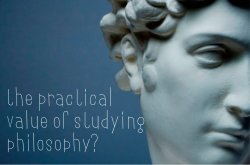
Transferable Skills
By studying philosophy, students develop cognitive transferable skills that pay off in a variety of professions—transferable skills such as Logical Reasoning • Analysis • Abstract Conceptualization • Problem-Solving • Creative Thinking • Clear and Persuasive Writing • Mental Dexterity • An Ability to Assess Different Perspectives and Frameworks • Information Management.
Earning Potential
The national median salary of Philosophy graduates is higher than nearly every other major in the social sciences, humanities, and higher than many other majors—higher than Psychology, Criminology, Communication, Special Education, Early Childhood Education, Business Management, Political Science, History, English, and so on (data source: payscale.com ).
Which professions do philosophy graduates pursue? • Technology • Business • Law • Publishing • Government • Advertising • Journalism • Teaching • Sales • Human Resources • Public Relations • Activism • Public Policy, and so on.
Read about the practical value of studying philosophy
• Forbes (2017) – “ A Case For Majoring In Philosophy ”
“Every year, college students choose their majors with an eye toward the return on investment. Among the usual lucrative suspects like finance and engineering, one liberal arts field stands out: philosophy. It turns out that philosophy majors earn significantly more than most majors, especially over the long term.”
“The surprisingly robust ROI [return on investment] for philosophy majors can be traced to its intellectual rigor. Philosophers are taught to seek out the pressure points in arguments and to reason for themselves. They dive into highly technical conversations, construct their own positions and arguments, and analyze relevant problems from multiple perspectives.”
“Beyond finances, the study of philosophy can also help students learn for themselves how they define the good life and how to go about living it.”
• U.S. News & World Report (2020) – “ What You Can Do With a Philosophy Degree ”
“Philosophy students learn how to question conventional thinking, which is a marketable skill.”
“A Wall Street Journal analysis of the long-term earning potential of people with various college majors revealed that philosophy majors tend to get raises and promotions more quickly than individuals with other majors, and a result of this rapid career progression is that philosophy majors’ mid-career earnings are usually double the size of their starting salaries.”
• CNBC (2018) – “ Mark Cuban says studying philosophy may soon be worth more than computer science—here’s why ”
“’I’m going to make a prediction’, Cuban told AOL in 2017. ‘In 10 years, a liberal arts degree in philosophy will be worth more than a traditional programming degree’…He views previously lucrative jobs in industries like accounting and computer programming as subject to the powers of automation. To remain competitive, Cuban advises ditching degrees that teach specific skills or professions and opting for degrees that teach you to think in a big picture way, like philosophy.”
• Times Higher Education (2019) – “ What Can You Do with a Philosophy Degree? ”
“Philosophy graduates have highly transferable skills that are valuable to employers.”
“Graduates secure work in a variety of disciplines after their degree, such as teaching, PR or politics. Communications, publishing, HR and advertising can be attractive options for philosophy graduates, as well as law, banking, the civil service, business and science. Others go on to further study, research, academia and/or lecturing in philosophy or a related field.”
• Entrepreneur Magazine (2017) – “ 5 Reasons Why Philosophy Majors Make Great Entrepreneurs ”
“When accomplished entrepreneurs like Reid Hoffman, Peter Thiel and Carly Fiorina credit their philosophy backgrounds for their success, you have to wonder if they’re on to something.”
• New York Times (2018) – “ A Wall Street Giant Makes a $75 Million Bet on Academic Philosophy ”
“Philosophy, he [Bill Miller] added, ‘has made a huge difference both to my life outside business, in terms of adding a great degree of richness and knowledge, and to the actual decisions I’ve made in investing’.”
“Mr. Miller, 67, is not the only old-guard Wall Street figure with a background in philosophy. George Soros was heavily influenced by the Austrian philosopher Karl Popper. Carl Icahn was a philosophy major at Princeton . . . (On the watchdog side of the street, Sheila Bair, the former chair of the Federal Deposit Insurance Corporation, was also a philosophy major.)”
• Harvard Business Review (2014) – “ How Philosophy Makes You a Better Leader ”
“A CEO client . . . found that contemplating the teachings of an ancient philosopher (Socrates) and a 20th century philosopher (Habermas) empowered him to implement an enhanced process of dialogue, consensus building, and ‘communicative rationality’ with his leadership team.”
• National Bureau Of Economic Research (2017) – “ The Costs Of And Net Returns To College Major ”
“Health and Engineering majors, where earnings returns are large on a per graduate basis, have per-dollar returns similar to those observed in education, math, philosophy , and language degrees. . .”
Graduate Study
Some philosophy majors go on to graduate studies in philosophy in order to pursue an academic career. The philosophy major is also exceptional training for many other post-graduate paths, such as law school. In fact, statistics indicate that philosophy majors perform very well on standardized tests for post-graduate and professional study.
- The GRE (“the SAT for graduate school”) – Philosophy majors come out on top.
“When students are compared by major on how far above average they do on the Graduate Record Examinations (GRE), a standardized test used in many disciplines to assess applicants to graduate programs, philosophy majors come out on top , according to a new look at test score data over the past few years.” (Daily Nous)
- Our philosophy department and Montclair State’s Feliciano School of Business have partnered for a “4 + 1” Philosophy BA/MBA program .
- The LSAT (the entrance exam for law school admissions) – Philosophy majors tie for first place with Economics majors.
- Medical School – The Philosophy major is a solid path to medical school. Consider the data and facts as explained by Paul Jung, M.D: “ If you think biochemistry is your ticket into medical school, think again. “
19 Creative Thinking Skills (and How to Use Them!)

Design your next session with SessionLab
Join the 150,000+ facilitators using SessionLab.
Recommended Articles
A step-by-step guide to planning a workshop, 54 great online tools for workshops and meetings, how to create an unforgettable training session in 8 simple steps.
- 18 Free Facilitation Resources We Think You’ll Love
In a fast-moving world, being able to find new perspectives and create innovation is an increasingly valuable skill . Creative thinkers are often at the forefront of driving change, solving problems, and developing new ideas. Not only that, but those who bring creative thinking to how they work are often happier, more productive, and resilient too!
So you might be asking yourself, how can I develop my creative thinking skills and think more creatively at work? Whether you want to supercharge your interpersonal skills, advance your career or be happier and more satisfied in the work you do, it pays to learn to think more creatively.
For many people, creative thinking is the key that unlocks solutions, promotes diverse thinking, and leads to better relationships and job satisfaction. So how can you get started with creative thinking? As passionate believers in the value of creative thinking, we’re here to help and truly think unleashing your creativity can be key to your personal development!
In this post we’ll define what creative thinking is, highlight the benefits, explore 19 key creative thinking skills and give you some examples of how to apply them in the workplace . Let’s dig in!
What is creative thinking?
Why is creative thinking important, what are the benefits of creative thinking.
- What are creative thinking skills?
- Examples of creative thinking skills (and how to use them)
- How to use creative thinking skills at work?
How to improve your creative thinking skills?
Creative thinking is the ability to approach a problem or challenge from a new perspective, alternative angle, or with an atypical mindset. This might mean thinking outside of the box, taking techniques from one discipline and applying them to another, or simply creating space for new ideas and alternative solutions to present themselves through dialogue, experimentation, or reflection.
Bear in mind that the number of different creative approaches is as vast as the number of creative thinkers – if an approach helps you see things differently and approaching a challenge creatively, follow that impulse.
While there are some proven methods and guidelines that can help you be a better creative thinker, remember that everyone can be creative and finding what works for you is what is important, not the terminology or specific framework.
One misapprehension about creative thinking is that you have to be skilled at more traditional creative skills like drawing or writing. This isn’t true. What’s important is that you are open to exploring alternative solutions while employing fresh techniques and creative approaches to what you’re working on.
You don’t need to be a great artist or even work in a traditionally creative field – we believe everyone is capable of creative thinking and that it enriches your personal and professional lives when you learn to be more creative.
Another misconception about creative thinking is that it applies only to the ideation or technically creative parts of the process. All aspects of our lives and interactions with people and challenges can benefit from creative thinking – from the ability to see things differently.
At work, thinking creatively might mean finding better ways to communicate, improve your working practices, or developing and implementing fresh solutions too.
Creative thinking is important because it drives new ideas, encourages learning, and creates a safe space for experimentation and risk-taking.
As organizations and people grow, they often develop tried and tested ways of operating. While it’s important to have solid working practices and processes, unswerving dedication to the norm can lead to stagnation and a lack of innovation and growth.
Creative thinking is important because it drives new ideas, encourages learning and creates a safe space for experimentation and risk-taking. Simply put, creativity and creative thinking are part of what helps businesses and individuals succeed and grow .
Whether your team or business thinks of itself as a creative one, you can’t afford to miss out on the benefits of creative thinking if you want to grow , deliver change, and help your team bring their best selves to work.
Using creative thinking skills at work creates b enefits not only in the ways we solve problems but also in how we approach everything from communication to self-fulfillment, task management, and growth . Bringing a culture of creative thinking into a workshop or group is often the job of a talented facilitator but whatever your role, there are benefits to thinking more creatively. Let’s explore some of the benefits of thinking creatively at work and in your everyday life!
Build empathy
- Bust assumptions
- Become a better problem solver
Find ways to move quickly and effectively
- Increase happiness
Discover new talents and promote learning
- Boost resilience and deal with adversity
Boost your CV and employability
Empathy and creative thinking go hand-in-hand. By practicing creative thinking skills and regularly looking for new ideas and points of view, you can actively become better at understanding your colleagues, customers, and even your family and friends. One of the major barriers to having productive and meaningful relationships is an unwillingness to see things from a perspective other than your own or failing to understand how another person is feeling.
By developing this skill, you can engage more meaningfully and honestly with people, ideas, and perspectives in all aspects of life. What’s more, because of the benefits that creative thinking can bring, you’ll actively want to see things from new perspectives and be more empathic : something that’s fundamental to creating real change.
Bust assumptions
Assumptions can be harmful in both our personal and professional lives. Whether it’s making assumptions about why someone is behaving the way they are in a workshop or what features will make your customers happiest, holding onto incorrect or inadequately formed assumptions can be problematic . It can create difficulty and tension in relationships and what’s more, it can lead to the development or introduction of solutions that are simply unfit for purpose.
Using creative thinking skills to challenge assumptions, build clarity, and see things from new perspectives can be transformative. If an assumption someone else makes feels incorrect, think about why and try to find out more. If someone challenges an assumption you hold, be open and listen.
Become a better problem solver
An example of not being a creative thinker is sticking to a tried and tested approach and sticking to the norm in every situation without considering whether trying something new might not lead to better results.
When looking to solve a problem or create innovative solutions, going outside of what you know and being open to new ideas is not only exciting, but it can create more impactful solutions too. You might even try using problem-solving techniques alongside some of the creative thinking skills below to find the absolute best solutions!
Some processes and working practices can be slow, especially in large organizations with many moving parts – but do they all have to be? Thinking creatively can help you find lean, actionable solutions that you can put into practice quickly and test ahead of bigger changes .
Experimentation and a willingness to take risks are vital to growth and change, and creative thinking helps create a climate conducive to finding and trying quick, effective solutions.
Increase happiness and satisfaction
Finding fresh, appropriate solutions to problems can be incredibly satisfying and is a fast-track to finding happiness both in and out of work. Bringing your whole self to a situation and being enabled to think outside of the box is a great way to feel valued and engaged with what you are doing.
Feeling frustrated with how a situation or process at work is going? Try developing and employing your creative thinking skills alongside your colleagues to find a better, happier way to collaborate! Feel unfulfilled or that not all of your skills and interests are being utilized? Consider how you might creatively deploy the skills or talents that make you happy and scratch that itch.
As children, we are encouraged to see things differently and try new things as part of our learning and growing process. There’s no reason we shouldn’t do this as adults too! Trying new things and learning to think creatively can help you find new skills, talents, and things you didn’t even know you were good at.
Staying curious and following what interests you with an open mind is a prime example of what a small change in thinking can achieve. Remember that creative thinking is a gateway to learning and by actively developing your creative toolset, you can grow and discover more in all walks of life – a surefire path to personal development.
Get better at dealing with adversity
It’s easy to get frustrated when problems seem to come thick and fast and existing solutions or methods don’t work. Adversity is something all of us will face at some point in our personal and professional lives but there are ways you can become more able to handle problems when they arise .
A strong suite of creative thinking skills is an important aspect of how we can build resilience and be more flexible when adapting or creating change. By exploring alternative ways of thinking, you’ll be better prepared to face adversity more openly and find alternative ways to resolve challenges in whatever context they emerge.
Creative thinkers are valuable employees at organizations of any size. Whether it’s championing innovation, creating change in policy, or finding better ways to collaborate, people who can effectively solve problems and leverage their creative thinking skills are better positioned for success at work.
Consider how you might plug your skills gap and boost your CV by developing your creative skillset and you won’t just be more successful – you’ll be happier and more engaged at work too!
Whatever your background or role, you are capable of thinking creatively and bringing creativity into your life.
What are creative thinking skills?
Creative thinking skills are the methods or approaches you might use when trying to solve a problem differently and explore a fresh perspective. While some of these skills might come naturally to you, others might need a more considered, purposeful approach.
For example, you might be a natural visual thinker who is great at presenting and interpreting visual information but you might not be so good at freely experimenting or creating space for reflection. In this case, you might try some brainstorming exercises to loosen up your experimentation muscles or create scheduled time for reflection in your working routine.
While creative professions like artists, writers, or designers may see more obvious uses for creative thinking skills, all professions can benefit from developing and deploying creative thinking . If you find yourself having difficulty at work or in need of inspiration or motivation, finding space to build on your creative skillset is a way to not only move forward but have fun while doing so.
If you think you’re not creative or have no creative thinking skills, we’re here to tell you that whatever your background or role, you are capable of thinking creatively and bringing creativity into your life : you might just need a little push or to reframe how you think about creativity!
Save time planning your next creative workshop
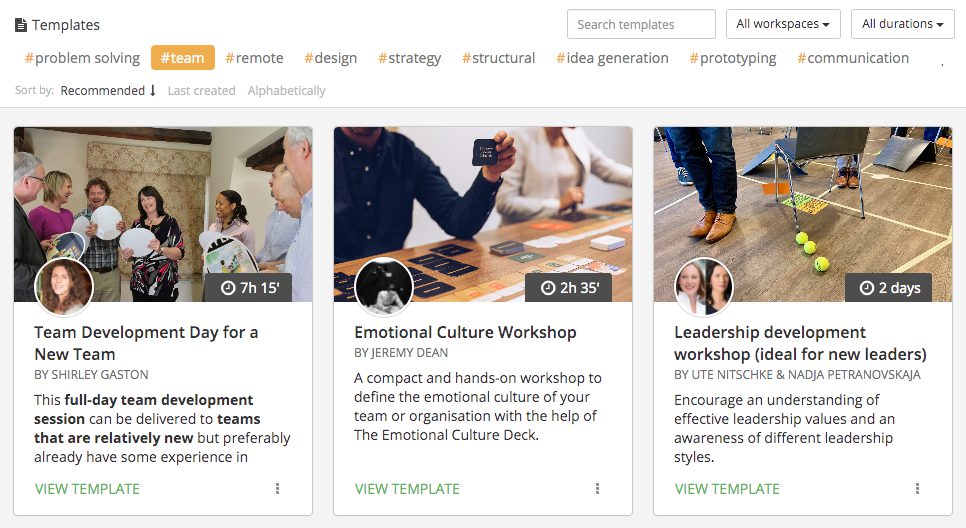
Examples of creative thinking skills (and how to use them)
Creative thinking skills come in all shapes and sizes, ranging from things like abstract thinking and storytelling to finding ways to radically plan projects or recognize organizational patterns .
In this section, we’ll explore each of the example creative skills below and talk about how you might use them in your personal and professional practice. We’ll also point out some things to watch out for where appropriate so you can make the most out of your new creative skills and avoid potential setbacks.
We’ll also include a method from the SessionLab library that will help you practice and explore each skill, whether alone or with others .
Feel free to read and explore the creative thinking skill which feels most interesting or applicable to you and come back and experiment with others in the future!
Some example creative thinking skills include:
Experimentation
Open-mindedness, lateral thinking.
- Pattern recognition
Deep and active listening
Challenging norms, lean organization, simplification, radical planning.
- Collaborative thinking
Data collection
- Interpretation and analysis
Interdisciplinary thinking
Frameworks and rulesets, micro and macro thinking, visual thinking, abstract thinking, storytelling.
Note that this list is not exhaustive, and there are many more ways of thinking creatively – try to see these creative skills as a jumping-off point for seeing things differently and exploring creative thinking at work .
Let’s get started!
A core creative skill is the ability to experiment and try new things, whether that’s in your personal practice, in a closed environment, or even in the field. It can be easy to fall short of implementing new ideas or following through with creative projects because critical judgment or overthinking gets in the way . A good experimenter is a self-starter who makes informed decisions to kickstart projects and test hypotheses.
Think of a painter who throws paint at a canvas and introduces new materials without overthinking or being self-critical. While not everything they try will be perfect, that’s the point – not every experiment needs to be successful in order to teach you something useful. By experimenting, you can try things that might prove useful or will lead you towards new solutions and better ideas. Remember that the act of experimentation is generative and often fun so be sure to give it a try!
One thing to watch out for is being sure to effectively capture the results of your experiments and to continue developing and iterating on the results. Experimentation is a great place to start, but remember that it is part of a larger process. Without effective documentation, you might not trace what delivered the best results and be unable to reproduce the outcomes. Experimentation is a great example of why creative freedom should be paired with a strong process in order to be at its best.
Four-Step Sketch #design sprint #innovation #idea generation #remote-friendly The four-step sketch is an exercise that helps people to create well-formed concepts through a structured process that includes: Review key information Start design work on paper, Consider multiple variations , Create a detailed solution . This exercise is preceded by a set of other activities allowing the group to clarify the challenge they want to solve. See how the Four Step Sketch exercise fits into a Design Sprint
Four-Step Sketch is a great method for promoting experimentation. By following a process that enables quick brainstorming before development, you can help build an experimental mindset that also generates results.
Open-mindedness is a critical element of creativity and one of the best creative thinking skills you can try to build if you’re new to the practice. Being open-minded means being receptive to new ideas, different ways of thinking, and perspectives which are not your own. It means not closing down conversations or ideas prematurely and trying to actively explore what is presented to you.
Imagine that a colleague comes up with an idea that is so far out of the status quo it seems off-the-wall and bizarre. Being open-minded means actively engaging with what is presented and to refrain from forming judgments before first understanding where your colleague is coming from .
Your colleagues’ initial idea might not be perfect, but being open-minded and truly attempting to understand their perspective means you can create dialogue, foster creativity, and move forward as a team.
Being open-minded doesn’t mean accepting every new idea and agreeing wholesale with every different opinion. While you should always try to be open and receptive to new ideas and other perspectives, you should also critically appraise and engage with them as part of a larger creative process. Don’t be so open-minded you have no strong opinions of your own!
Heard, Seen, Respected (HSR) #issue analysis #empathy #communication #liberating structures #remote-friendly You can foster the empathetic capacity of participants to “walk in the shoes” of others. Many situations do not have immediate answers or clear resolutions. Recognizing these situations and responding with empathy can improve the “cultural climate” and build trust among group members. HSR helps individuals learn to respond in ways that do not overpromise or overcontrol. It helps members of a group notice unwanted patterns and work together on shifting to more productive interactions. Participants experience the practice of more compassion and the benefits it engenders.
Open-mindedness is particularly useful when it comes to meaningfully communicating with others. Whether its developing the ability to walk in the shoes of someone else or building empathy and listening skills, Heard, Seen, Respected is a great method to try when learning to be more open-minded.
Lateral thinking is a prime example of how we can creatively solve real-world problems in a measurable and easy-to-understand manner. Deploying lateral thinking means using reasoning or non-traditional logic to find an indirect or out-of-the-box approach to solving a problem.
A simple example might be a challenge like: we need to increase revenue. Traditional thinking might mean considering hiring new salespeople to try and get more direct sales. A lateral approach might mean engaging more with current customers to reduce churn, working with external partners to get new leads, working to get sponsorship, piloting an affiliate scheme or any number of new ways to solve the existing problem.
Broadly speaking, lateral thinking often means stepping back and considering solutions or approaches outside of the immediately obvious.
One potential danger with lateral thinking is spending time to create new solutions to problems that don’t need them. Not every problem needs to be solved laterally and the best solution might actually be the most straightforward. Be sure to tap into existing knowledge and appraise a problem before trying something radical to avoid wasted time or frustration!
The Creativity Dice #creativity #problem solving #thiagi #issue analysis Too much linear thinking is hazardous to creative problem solving. To be creative, you should approach the problem (or the opportunity) from different points of view. You should leave a thought hanging in mid-air and move to another. This skipping around prevents premature closure and lets your brain incubate one line of thought while you consciously pursue another.
Developing your lateral thinking skills comes more naturally to some than others. The Creativity Dice is a great method for getting out of linear thinking habits and moving into different ways of thinking.
Pattern recognition
Pattern recognition is the ability to recognise existing or emerging patterns and make connections based on the patterns you have discerned . While pattern recognition goes back to our prehistoric roots, being able to spot patterns outside of the ordinary and consider what may not be immediately obvious is a vital creative thinking skill for today.
Consider how meetings between some members of a team might often end in conflict. While it might first seem that these two people just can’t get along, it might actually be that certain emotional triggers are being tripped or the format of the conversation isn’t working. Looking beyond your initial impressions and from a new perspective might let you find a repeating pattern that isn’t immediately obvious.
When trying to spot patterns, try to be mindful of existing biases so you avoid bending what is happening to fit a pattern you might be expecting. Be sure to interpret all data fairly and honestly, even if you believe a pattern is already forming.
Affinity Map #idea generation #gamestorming Most of us are familiar with brainstorming—a method by which a group generates as many ideas around a topic as possible in a limited amount of time. Brainstorming works to get a high quantity of information on the table. But it begs the follow-up question of how to gather meaning from all the data. Using a simple Affinity Diagram technique can help us discover embedded patterns (and sometimes break old patterns) of thinking by sorting and clustering language-based information into relationships. It can also give us a sense of where most people’s thinking is focused
Pattern recognition is a skill that benefits from thoughtful practice. Try starting with a deliberate pattern-finding process like Affinity Map to build the ability to see patterns where they might not first be obvious.
While it might not seem like it at first, being a good listener is a creative thinking skill. It asks that a person not only try to understand what is being said but also to engage with the why and how of the conversation in order to reframe prior thinking and see things from a new perspective.
Deep listening or active listening is not only hearing the words that someone is saying but actively seeking to interpret their intent, understand their position, and create a positive space for further conversation. Not only does this create a deeper conversation for both parties, but this act of engagement and understanding leads to more creative and dynamic results too.
Think of a workplace grievance that one person might have against another. Without actively listening and trying to understand the core issues from the perspective of everyone involved, you might not only fail to solve the issue but actually make staff feel less heard and valued too.
By employing this creative thinking skill in such a conversation you can see things more clearly and find a way to creatively satisfy the needs of everyone involved.
Active Listening #hyperisland #skills #active listening #remote-friendly This activity supports participants to reflect on a question and generate their own solutions using simple principles of active listening and peer coaching. It’s an excellent introduction to active listening but can also be used with groups that are already familiar with it. Participants work in groups of three and take turns being: “the subject”, the listener, and the observer.
Trying to be more present in conversations is a great place to begin building your deep listening and active listening skills . Want to supercharge the process as a group? Try a role-play activity like Active Listening to more thoughtfully see and reflect on how important this skill can be.
Not all established working practices are the best way of doing things. People who practice this creative thinking skill are likely to question the status quo in search of something new which can deliver meaningful change. While any challenge to the established order needs to be conducted respectfully and thoughtfully, thinking of how to go beyond the norm is how innovation occurs and where creative thinkers excel.
When trying to practice this skill, be prepared to question existing methods and frameworks and ask if there might be a better way outside of the limits of the current system.
As with lateral thinking, it’s important to recognize that not everything is a problem that needs to be solved and so you may need to be selective in which norms should be challenged – otherwise, you may never make it out of the front door!
Additionally, challenging the established order often means questioning the work someone else has already done. While this is a necessary part of growth, it should always be done constructively and respectfully.
W³ – What, So What, Now What? #issue analysis #innovation #liberating structures You can help groups reflect on a shared experience in a way that builds understanding and spurs coordinated action while avoiding unproductive conflict. It is possible for every voice to be heard while simultaneously sifting for insights and shaping new direction. Progressing in stages makes this practical—from collecting facts about What Happened to making sense of these facts with So What and finally to what actions logically follow with Now What . The shared progression eliminates most of the misunderstandings that otherwise fuel disagreements about what to do. Voila!
Challenging norms without a considered approach can be ineffective and potentially frustrating. Taking the time to build shared understanding and push in the same direction with What, So What, Now What? is a great way to explore how your existing process is or isn’t working and challenge norms productively.
Creative thinking doesn’t mean being disorganized or chaotic just because you have an abundance of ideas. In order to facilitate creative thinking, it’s important to stay organized and approach the process with the right framework, mindset, and space. As a creative thinking skill, lean organization means considering what you absolutely need to do in order to make things happen, versus what you don’t.
Think of how a large, multi-discipline team might go about organizing themselves for a big project. While it’s vital everyone is aligned and kept up to date, a traditional system of scheduled meetings might not be the most productive. Lean organization means considering the needs of the team, the project and thinking creatively about what you need to stay organized, and keeping unnecessary admin to a minimum.
Thinking creatively about organization is something all leaders should practice but any project can benefit from thinking through the process by which it will be accomplished.
MoSCoW #define intentions #create #design #action #remote-friendly MoSCoW is a method that allows the team to prioritize the different features that they will work on. Features are then categorized into “Must have”, “Should have”, “Could have”, or “Would like but won‘t get”. To be used at the beginning of a timeslot (for example during Sprint planning) and when planning is needed.
Lean organization often means being honest and realistic about what is absolutely necessary versus nice to have. MoSCoW is an effective agile framework for planning work and also reframing your approach to organizing time, tasks and more!
Simplifying, presenting or decoding any information is a vital skill when working with others. In a creative thinking context, simplification is the act of seeing what is important about a task or piece of data and stripping away the extraneous parts to see things more clearly.
Some problems can feel unassailable because of their complexity or scale – simplification allows you to reconsider a problem in simple terms and reframe it in a way that means you can approach it productively.
An example of using this creative thinking skill at work might be when presenting the results of a project to the rest of your organization. People working on other teams and in different disciplines could become disengaged if exposed to too many complex moving parts or it might simply be a waste of time to discuss every detail.
By simplifying a project into more succinct terms, you not only can help your group connect with the material swiftly but also boil a project down to its most important elements . This is a great way to creatively re-energize a project and identify where you can make an impact immediately.
6 Words #ufmcs #red teaming This tool is designed to help critical thinkers focus on a core idea by writing a short phrase summarizing their thoughts into a set number of words that are clear, concise, and accurate. This idea is based on a complete short story written by Ernest Hemingway: “For sale, baby shoes – never worn.” Six Words forces people to synthesize their ideas in a succinct and meaningful way, cutting away fluff and distilling the idea to its bare essence.
One way of practicing simplification is by summarising or condensing thoughts, ideas of stories into a more concise, compressed form . 6 Words is a method for cutting away extraneous material from ideas that engages creative thinking and reframing approachably – great for groups!
Any major project requires some measure of planning in order to succeed, especially when working with others. But are there times where overplanning or traditional working processes feel too slow or frustrating for the project at hand? This is where these creative thinking skills come in handy! Radical planning is a way of approaching project planning from an alternative angle in order to generate fast, effective results.
When taking this planning approach, you will often shuffle the order of the normal planning process in order to create alternative outcomes and cut out elements you may not need. For example, with the backcasting workshop activity, the approach is to think of desired outcomes up to twenty years in the future and work backward to figure out how we can make small steps today.
You might also try planning with a mindset of what you and your team can each achieve immediately and in a more experimental fashion with an activity like 15% solutions .
By approaching planning with a creative thinking mindset, you can surface ideas and plans which may not have come up with a more traditional planning process. Another great benefit is to question the normal manner in which your team or organisation approaches planning and can help your team find a method that works best for you!
Backcasting #define intentions #create #design #action Backcasting is a method for planning the actions necessary to reach desired future goals. This method is often applied in a workshop format with stakeholders participating. To be used when a future goal (even if it is vague) has been identified.
Collaborative thinking
Effective collaboration requires us to bring many different skills together, but consciously considering how to be a more effective collaborator is worth mentioning separately. When a creative thinker approaches collaboration, they will try to think of how to use alternative approaches to make the collaborative process more effective while also helping everyone on the team contribute and be heard.
An example is when it comes to getting work done in meetings – if the current process isn’t enabling everyone to collaborate effectively, you might employ creative thinking to try finding an alternative format, consider working asynchronously, or timeboxing parts of your agenda.
The best collaborators also find ways to champion the work of others and create a safe space for everyone to contribute – it might not be enough to assume collaboration will be accomplished when you get people in a room.
Employing this creative thinking skill can make all the difference when it comes to job satisfaction, interpersonal relationships and group outcomes too! Try approaching your collaborative projects more mindfully and see how it changes things for you!
Marshmallow challenge with debriefing #teamwork #team #leadership #collaboration In eighteen minutes, teams must build the tallest free-standing structure out of 20 sticks of spaghetti, one yard of tape, one yard of string, and one marshmallow. The marshmallow needs to be on top. The Marshmallow Challenge was developed by Tom Wujec, who has done the activity with hundreds of groups around the world. Visit the Marshmallow Challenge website for more information. This version has an extra debriefing question added with sample questions focusing on roles within the team.
Working together on a task as a team is an effective way of kickstarting collaborative thinking, especially if you approach the task mindfully . The Marshamllow Challenge with debriefing is a proven method for engaging teamwork and by adding reflection time afterward, your group can share and build on what they learned.
Collecting data might seem like a solely analytical skill, but it is another area where creative thinking can lead to productive, unexpected and transformative results. Approaching the data collection process creatively might mean trying new techniques or sources, or simply reconsidering the how and why of your data collection processes.
Imagine you are running a survey to measure customer happiness. You might try asking traditional survey questions, but find that your response rate is low and furthermore, your approach might be invasive and actively decrease happiness too!
If you were to approach this problem creatively, you might find that using a simplified form, asking for feedback at a different point in the customer journey, or utilizing an alternative measurement scheme delivers the data you are looking for. In many cases, thinking about the questions you are asking from a new point of view is what unlocks a better data collection process.
The key to this creative thinking skill is to try looking at the data collection process from a new, preferably customer-centric perspective while also considering why and how you are collecting data. You will likely find that by asking for input from your customers more creatively, you create space for more creative responses too!
3 Question Mingle #hyperisland #team #get-to-know An activity to support a group to get to know each other through a set of questions that they create themselves. The activity gets participants moving around and meeting each other one-on-one. It’s useful in the early stages of team development and/or for groups to reconnect with each other after a period of time apart.
3 Question Mingle is a get to know you activity that does double duty in demonstrating the power of approaching data collection creatively. By creating their own questions, a group can really think about what they want to know, how they ask questions, and how the results differ. Be sure to give it a try!
Interpretation and analysis
Interpretation skills can be varied though in a creative thinking context it means being able to successfully analyze an idea, solution, dataset, or conversation and draw effective conclusions. Great interpreters are people with a desire to listen, understand, and dig deeper in order to make their interpretation fully realised.
One of the ways creative thinking can improve interpretation is in helping us challenge assumptions or initial readings of data in order to consider other possible interpretations and perspectives.
Say your product is having a problem with losing lots of new customers shortly after signing up. You do a survey and people say that they leave because the product isn’t useful to them. Your initial interpretation of that data might be that you’re not the right fit for these customers or that the product needs new features.
If you were to apply creative thinking to the interpretation of this data, you might conduct further research and see that the product is fine, but people didn’t find the right features for them and that your onboarding process needs to be improved.
The key here is interpreting the data from various perspectives and then correlating that with other sources to form an accurate and representative interpretation, rather than going with your initial assumption . By following this process, you might also find that the way you are collecting data is flawed (perhaps not asking the right questions) or that more research and data collection is needed.
So long as you are sure to have data points and analysis to back up your findings, it pays to explore alternative interpretations so you can avoid bias and find the most accurate takeaways .
Fishbone diagram #frame insights #create #design #issue analysis Fishbone diagrams show the causes of a specific event.
Effective interpretation and analysis isn’t possible without a thorough exploration of the problem or topic at hand. Fishbone Diagram is a simple method for not only surfacing insights but framing them in a way that allows for proper and multi-perspective analysis.
Einstein is quoted as saying, “We cannot solve our problems with the same thinking we used when we created them.” In this mold, sometimes the best ideas and solutions come from fields and disciplines outside of our own. By considering how someone with a different skillset to your own would solve a problem or deploy solutions, you can often find ideas and techniques you may never have considered.
Consider being tasked with improving employee happiness. A social media manager with a background in illustration and events management would likely try a very different approach to a sales manager who is used to a culture of incentives and bonuses. If you were trying to develop a new product, think of how a developer would approach deciding on key features versus an academic or a customer success manager?
The important thing here is to try and use the perspective, skill set , and approach of another field or discipline to first consider and then solve a problem more fully . Where possible, try and include people from other disciplines in the process and try to avoid making assumptions.
As with all creative thinking skills, being open-minded and sourcing the expertise and opinions of others where necessary is vital when creating true innovation.
Mash-Up Innovation #hyperisland #innovation #idea generation Mash-ups is a collaborative idea generation method in which participants come up with innovative concepts by combining different elements together. In a first step, participants brainstorm around different areas, such as technologies, human needs, and existing services. In a second step, they rapidly combine elements from those areas to create new, fun and innovative concepts. Mash-ups demonstrates how fast and easy it can be to come up with innovative ideas.
Interdisciplinary thinking isn’t just for radical academics. By combining ideas from disparate fields in a fast, fun manner, Mash-Up Innovation is great for building creative thinking skills and generating results in one fell swoop!
All creative thinking skills are about reframing things in a new way of finding alternative approaches. This can often mean abandoning an existing framework and thinking outside of the box. That said , another way of applying creative thinking is by bringing rulesets, constraints, or frameworks to your approach in order to trigger deeper creative work and tap into a problem-solving mindset .
Consider a simple task like trying to generate more customers. With free reign, there are innumerable ways to accomplish this. But what happens if you create a rule like, we cannot spend any money, or, these must be driven by social media alone. In order to accomplish your goal under these conditions, you must think more creatively and deeply, deploying more concentrated problem-solving skills than if you could try any approach you wanted.
Alternatively, you might approach a problem with a framework that forces you to think under specific circumstances or with a rigid set of steps. Six thinking hats is a great workshop activity that asks participants to frame and reframe a problem from six different angles. While it might first seem counterintuitive, the use of rules or frameworks can create fertile ground for creative thinking and lead to more realized solutions!
The Six Thinking Hats #creative thinking #meeting facilitation #problem solving #issue resolution #idea generation #conflict resolution The Six Thinking Hats are used by individuals and groups to separate out conflicting styles of thinking. They enable and encourage a group of people to think constructively together in exploring and implementing change, rather than using argument to fight over who is right and who is wrong.
Not all problems are created equal. Depending on how much it directly affects you, you might see a given problem as being more or less important than your colleagues, leading to a different response and approach to solving the problem. This creative thinking skill is all about being able to switch between seeing the bigger picture while also considering how something might manifest on a smaller scale.
Think of how frustrating it can be when an executive team makes sweeping changes that affect frontline staff in a way they might not have anticipated. Micro and macro thinking means seeing both problems and potential solutions from multiple perspectives and adjusting accordingly.
Another key aspect of applying this approach is knowing the limits of your own knowledge and involving stakeholders from all levels of an organization to inform your ideation and problem-solving process.
If you’ve never worked in support and don’t regularly talk to your support team, you might not understand how a change to helpdesk software could impact your team and your clients – remember that a big part of any change in perspective is doing the research and talking to who will be affected !
Stakeholder Round Robin Brainstorm #idea generation #brainstorming #perspectives #remote-friendly #online A divergent process to generate ideas and understanding from different perspectives.
Learning to practice micro and macro thinking often starts with first listening to and understanding the needs and perspectives of others . Especially those who have varied positions in relation to the problem, solutions, or organization you are working with. Stakeholder Round Robin Brainstorm is an effective method of surfacing insights and perspectives quickly and productively.
Of all the creative thinking skills on this list, visual thinking might be one you are most familiar with. Visual thinking is a method of processing, learning, and presenting information and concepts with visual assets such as images.
Visual thinking is often associated with creative thinking because of the consumption and creation of images at its heart. Don’t let this make you think you have to be able to draw in order to be a visual thinker.
Applying this creative thinking skill means being able to interpret visual information, present concepts in an often simple visual manner, and communicate in a way that is more universally understood. Drawing stick people is actively encouraged!
Visual approaches to problem-solving can help foster shared understanding and help people be more succinct or creative in their ideas. Remember: if an idea is too complex to be put into pictures, perhaps it needs further refinement .
Imagie-ination #idea generation #gamestorming Images have the ability to spark insights and to create new associations and possible connections. That is why pictures help generate new ideas, which is exactly the point of this exercise.
While you might be able to jump straight into direct applications of visual thinking, it can help to try an exercise where you and a group explore using images simply and engagingly. Imagie-ination helps unlock the power of visual thinking as a team while also helping generate ideas too!
Abstraction or abstract thinking is the art of taking things out of their normal context and presenting them in a radical new light . While most creative thinking skills utilise abstraction in some form, it’s worth noting that actively trying to take an idea from one context and place it in another is a creative approach all on its own.
Think of Pablo Picasso’s cubist portraits – by taking something as common as a human face and bringing abstraction to his process, he created something radically different and innovative. You can create a similar effect by recontextualizing ideas, concepts, and problems and by looking at them from different, perhaps even conflicting points of view.
Abstract thinking is often built on engaging with absurdities, paradoxes, and unexpected connections . As such, it can often be fun, wild and surprising, and is a great way to generate creative ideas even in those who might be resistant to other forms of creative thinking. Lean into the weird!
Forced Analogy #divergent thinking #zoom #virtual #remote-friendly People compare something (e.g. themselves, their company, their team) to an object.
Forced Analogy is a quick, fun activity you can use to promote abstract thinking. Comparing one thing to another seemingly unrelated thing asks for a creative approach to context and metaphor and can really unlock a groups divergent thinking process.
Telling stories or narrativizing a problem can help us not only see things differently but understand where we share common ground with others. Everybody tells stories – whether that’s explaining our employment history, telling colleagues about what happened at the weekend, or when creating user personas and journeys.
Leverage this inclination to help people not only realize they are creative thinkers by nature but to help them share something of themselves too!
As a creative thinking skill, storytelling is about applying our natural proclivity for stories into new situations or thinking about how to reappraise or present material narratively . Think of the basic storytelling concept like the idea that all stories have a beginning, middle, and end – how might we bring this thinking to a tough challenge, a new product, or when solving a customer complaint?
You might even use storytelling tropes like the hero’s journey when exploring ideas or company conflicts. Whichever way you go, remember that stories are a universal element of culture and you have a rich lineage to dip into if you need a new perspective.
Telling Our Stories #hyperisland #team #teambuilding To work effectively together team members need to build relations, show trust, and be open with each other. This method supports those things through a process of structured storytelling. Team members answer questions related to their childhood, young adulthood, and now; then weave them into a story to share with the rest of their team.
Telling Stories in a collaborative space is one of the best ways you can approach creative thinking through narrative . By doing this activity as a team, you can help a group see the benefit of applying storytelling approaches outside of more traditional forms.
How many times have you had a tough problem that you can’t seem to solve so you get frustrated and leave your desk. Then, when you’re on a walk, standing in the supermarket, or falling asleep, a solution seems to arrive out of thin air? Often, you’ll find that creating space to reflect on a problem is an effective way to find a way forward.
The trick with making reflective space work as a larger part of your working practice is knowing when to take time to reflect, building space into your regular schedule, and finding techniques that allow things to surface effectively.
This might mean going for a walk with the intention to be present in noticing the world around you and gaining insights that can help your situation. It might also mean remembering to take time to rest or simply read and give your brain something good to chew on.
I notice, I wonder #design #observation #empathy #issue analysis Learn through careful observation. Observation and intuition are critical design tools. This exercise helps you leverage both. Find clues about the context you’re designing for that may be hidden in plain sight.
In a creative thinking context, reflection often means giving an idea time to unfurl and to resist the temptation to force it – by creating space to observe and reflect with I notice, I wonder you might see new ways of thinking emerge naturally.
How to use creative thinking skills at work?
At SessionLab, we’ve found many of the above creative thinking skills helpful when finding better ways to collaborate , handle workplace challenges or generate new ideas . Here are just a few small examples of things we’ve done that have benefited from thinking creatively as a team.
Using creative thinking to facilitate a site redesign
Using creative thinking to improve team communication, using creative thinking to improve collaboration.
Remember that creative thinking needn’t be explosive or radical to be useful – a simple shift in mindset or perspective can be all you need to create meaningful and impactful change.
When we began working on a site-wide redesign, we had to deploy a large number of creative thinking skills to make the process smooth and effective.
When first determining how to approach the project and scope the work, we reviewed how we had worked together on large projects in the past. While we saw there was room to improve, finding the best way to proceed and make the changes we needed was no easy task.
Challenging the entire process from start to finish with a creative thinking mindset and trying to stay open to alternative methods where possible was what unlocked the process for us. By reconsidering how we were running meetings, sharing feedback, and collaborating, we were able to identify where we were going wrong and then try alternative approaches more freely.
When it came to implementing solutions, we were also sure to stay open to experimentation while challenging our core assumptions of what would work and wouldn’t. This really helped us refine the working process and tailor it to our particular team and goals.
Another example came with finding a new approach when work stalled on a specific page. For our features page, we began by following the standard approach we had developed – writing the copy and structuring the page first before then following with illustrations and images.
In this case, our existing approach got us to an impasse : it felt difficult for our designer to be creative and find the best way to translate ideas into images if the copy had already been defined and the structure felt too rigid. What we decided to do was to reverse the workflow completely and allow the designer to create design elements before we wrote the copy and implemented too rigid a structure.
Throughout the project, creative thinking allowed us to challenge whether the existing way we did something was the right one and gave us scope to experiment and be open when finding solutions. Not only did this help us solve the immediate problems as they arose but they helped us come up with a great new design too!
Creative thinking can come in extremely handy when it comes to communicating. If one form of communication or working process isn’t working, approaching the discussion with a creative thinking mindset can help resolve the immediate issue and create lasting change in how we converse and work together too.
Like many virtual teams, we faced the challenge of some meetings feeling unproductive . The issues ranged from overrunning, crosstalk, not everyone feeling heard or able to contribute, or getting lost in ancillary discussions that were not productive or necessary. In an online setting, it can be hard to keep everyone on track and for things to run smoothly without accidentally talking over one another or causing frustration.
When it came to crosstalk, we wanted to avoid the frustration of interruption and disruption but also wanted to ensure people did not feel like they couldn’t contribute . Using the finger rules technique in a remote setting allowed people to easily show when they wanted to speak and what they wanted to discuss without disrupting the flow of the meeting.
We also found that the reason some daily meetings felt unproductive was because the meetings were for the purpose of daily updates and there didn’t always feel like there was a lot to say, thus leading to frustration or unproductive time being spent in these meetings.
In this example, we moved to a weekly format while also ensuring that we continue daily check-ins on Slack. This approach meant that we cut down on unnecessary meetings while still ensuring everyone’s needs were met .
This method is an example of creatively approaching a communication problem by thinking outside of the box and being prepared to challenge core assumptions . While we all wanted to stay informed, it really helped to reconsider the methods for staying informed and whether our current approach was the best way to achieve what we needed. It was also useful to reassess how we approached meeting agendas and goal-setting – follow the link for more on that if you’re having difficulty with unproductive meetings!
Remember that creative thinking needn’t be explosive or radical to be useful – a simple shift in mindset or perspective can be all you need to create meaningful and impactful change .
Remember that looking to others and being inspired by how they did things can be as transformative as trying to reinvent the wheel!
A final example is how we approached collaborating on creating the new design. While all projects at SessionLab feature collaboration between multiple parties, in this case we wanted to create space for everyone on the team to contribute.
We found that when trying to collectively brainstorm in a live, remote session, it became difficult for everyone to contribute and reflect on what was being shared by other members of the team effectively .
Some people had been able to prepare less than others, other people were less aware of all the circumstances of the project, or others were less able to switch gears during their working day. This led to some contributions being missed, a messier working process, and a feeling of being rushed – all of which lead to less effective outcomes than we might have hoped for.
In this case, we thought of how asynchronous work , reflection time, and some small process changes might help solve the problems we were running into. We wanted to be able to respond to what was being shared more effectively while also creating space for everyone to contribute in a way that was most productive for them.
Starting the brainstorming session in personal MURAL boards asynchronously and on our own time meant everyone was able to ideate at the time that was best for them and without any distractions . By then encouraging review and reflection on other people’s boards ahead of the main session, we were able to properly take in ideas and let them develop without feeling hurried.
This approach reduced the amount of time we actively spent working together in a meeting while improving the quality of the work . It helped people engage with the process, reduced potential frustration, and also meant we were more able to respond fully to the suggestions of others. This was a great example of how thinking creatively and learning from others can help create better outcomes and a more streamlined process.
It’s also worth noting that reflecting on our conversation with Anja Svetina Nabergoj regarding asynchronous learning and finding inspiration there was part of what helped this process along. Remember that looking to others and being inspired by how they did things can be as transformative as trying to reinvent the wheel!
Creative workshops and meetings made easy

Whether you find that creative thinking doesn’t come naturally, if your skills need some attention, or even if you just want to try new ways of working, it can be difficult to know where to begin .
Thinking about the creative thinking skills above and considering which you might be missing or could benefit from purposeful attention is a great place to start, though there are also some concrete ways you can approach the process and improve your creative thinking abilities in a pinch. Let’s see how!
Be present and aware of how you feel
Create space for new ideas, look to others for inspiration, throw yourself into new things, encourage creative thinking in others.
All skills get better with practice and creative thinking is no exception. Whether it’s active listening, experimentation or any other creative thinking style, it’s okay to not get it right the first time . The very act of being open to new approaches and perspectives is itself a way to improve your creative thinking skill set. However you try to implement creative thinking, know that exploration, iteration, and practice are fundamental parts of the process.
Try starting small and practice your creative thinking skills in your interpersonal relationships and collaborative projects. Take note of how it goes and try building up to larger and larger implementations of your creative thinking approaches.
A key part of cultivating or improving any new skill is to be fully present and aware when utilizing that skill. Consider how a sculptor needs to be aware of their materials, how they handle the material and place them on the board in order to be truly successful. Being present in the moment is important for any collaborative process, but is an especially vital aspect of creative thinking.
If you find yourself frustrated, excited, engaged, or stuck, make a mental note of how you are feeling and consider how you might do things differently. Staying present and actively engaging with how a situation makes you feel before responding is one of the most effective ways of cultivating and improving your creative thinking – be sure to give it a go!
As with many aspects of creativity, it’s not always effective to force it. Good ideas and finding new approaches can take time and an important part of the creative thinking process is creating space not only for reflection but to rest and allow things to surface. This might mean building more quiet, mindful time into your routine, reading and finding new inspiration, or simply learning to take a break.
While this can be difficult to get into the habit of, it does get easier with time. Try blocking out reflective time in your calendar or letting others know that you are taking the time in order to make it stick and avoid interruptions. Reflective space is important and useful, and by treating it as such, you can help ensure it happens and doesn’t get discarded or forgotten about.
One of the biggest barriers to thinking creatively is simply not being open to what is in front of you. Whether it’s rushing to use an existing solution without investigating alternatives, failing to listen or be present when something new is being presented, or sticking with your existing assumptions, a failure to stay open and reserve judgment can kill creative thinking.
Try to stay open and apply creative thinking without pressure or being overly critical in order to improve those skills and let more creative approaches surface in the future.
One of the best ways to find new perspectives and alternative ways of thinking is by looking to others. Whether it’s finding inspiration from other creative thinkers via conversation, reading and researching new sources, or simply listening and observing, looking outside of yourself is one of the most effective ways you can jolt your creative thinking.
Try finding sources outside of your normal circles, whatever the medium. It can be very easy to get into creative bubbles that might unwittingly exclude new forms of thinking. By broadening your social, creative and critical circles , you can be exposed to all kinds of potentially inspiring or creatively engaging ways of thinking and doing.
It’s hard to create space and an opportunity for new ways of thinking if you stick to the same routines and activities. You’ll often find that trying new things and exposing yourself to new hobbies, skills and approaches can be massively engaging and exciting too.
An important aspect of creative thinking is applying the learnings from one discipline or approach to another. If a developer were to throw themselves into learning how to dance, they might learn something they can apply to their role as a developer.
An open and honest desire to explore new experiences in and outside of your working life is a vital ingredient in the creative thinking process. Try saying yes to doing new things wherever you can find them – being alive to possibility and engaging in the world is a great way of supercharging your creativity!
Creativity is even better when shared. Whether it’s crowdsourcing new ideas, iterating together, or helping others build their creative thinking skills, sharing the experience is often a useful and generative process for all involved.
Try bringing a group together to explore thinking creatively together or run a workshop on developing creative thinking skills in the workplace. Not only will it help your participants with their own creative discovery, but it will also help you develop your own creative skills.
Over to you
As facilitators and advocates of the power of workshops, we’re passionate about how creative thinking can improve many aspects of a group’s personal and working lives. At its heart, creative thinking is an empathic, generative act, and by bringing those concepts to the fore, we believe everyone can see better outcomes when solving problems, generating ideas or communicating with others.
We hope we’ve given you some great examples of creative thinking at work and how you might discover and nurture your own creative thinking skills . That said, this list is by no means exhaustive and there are many more ways you might try thinking creatively. Think of this post as a jumping-off point for further exploration and creative development!
Do you have any concepts or approaches you’ve used to become a better creative thinker? Did you find any of the creative thinking methods above particularly helpful? We’d love to hear about your experience in the comments below!
James Smart is Head of Content at SessionLab. He’s also a creative facilitator who has run workshops and designed courses for establishments like the National Centre for Writing, UK. He especially enjoys working with young people and empowering others in their creative practice.
Very nice information. Thanks for posting such an informative blog. Creative thinking is an unconventional thinking that looks at an issue from different perspectives. Innovative thinking is a thinking that converts / commercializes a creative idea into practical application.
The Fosbury Flop is a very good example of a creative idea and trend when we apply “the learnings from one discipline or approach [Engineering] to another [High Jump].”
thanks alot…very informative and thoroug
Leave a Comment Cancel reply
Your email address will not be published. Required fields are marked *

Going from a mere idea to a workshop that delivers results for your clients can feel like a daunting task. In this piece, we will shine a light on all the work behind the scenes and help you learn how to plan a workshop from start to finish. On a good day, facilitation can feel like effortless magic, but that is mostly the result of backstage work, foresight, and a lot of careful planning. Read on to learn a step-by-step approach to breaking the process of planning a workshop into small, manageable chunks. The flow starts with the first meeting with a client to define the purposes of a workshop.…

Effective online tools are a necessity for smooth and engaging virtual workshops and meetings. But how do you choose the right ones? Do you sometimes feel that the good old pen and paper or MS Office toolkit and email leaves you struggling to stay on top of managing and delivering your workshop? Fortunately, there are plenty of great workshop tools to make your life easier when you need to facilitate a meeting and lead workshops. In this post, we’ll share our favorite online tools you can use to make your life easier and run better workshops and meetings. In fact, there are plenty of free online workshop tools and meeting…

How does learning work? A clever 9-year-old once told me: “I know I am learning something new when I am surprised.” The science of adult learning tells us that, in order to learn new skills (which, unsurprisingly, is harder for adults to do than kids) grown-ups need to first get into a specific headspace. In a business, this approach is often employed in a training session where employees learn new skills or work on professional development. But how do you ensure your training is effective? In this guide, we'll explore how to create an effective training session plan and run engaging training sessions. As team leader, project manager, or consultant,…
Design your next workshop with SessionLab
Join the 150,000 facilitators using SessionLab
Sign up for free
How it works
Transform your enterprise with the scalable mindsets, skills, & behavior change that drive performance.
Explore how BetterUp connects to your core business systems.
We pair AI with the latest in human-centered coaching to drive powerful, lasting learning and behavior change.
Build leaders that accelerate team performance and engagement.
Unlock performance potential at scale with AI-powered curated growth journeys.
Build resilience, well-being and agility to drive performance across your entire enterprise.
Transform your business, starting with your sales leaders.
Unlock business impact from the top with executive coaching.
Foster a culture of inclusion and belonging.
Accelerate the performance and potential of your agencies and employees.
See how innovative organizations use BetterUp to build a thriving workforce.
Discover how BetterUp measurably impacts key business outcomes for organizations like yours.
Daring Leadership Institute: a groundbreaking partnership that amplifies Brené Brown's empirically based, courage-building curriculum with BetterUp’s human transformation platform.

- What is coaching?
Learn how 1:1 coaching works, who its for, and if it's right for you.
Accelerate your personal and professional growth with the expert guidance of a BetterUp Coach.
Types of Coaching
Navigate career transitions, accelerate your professional growth, and achieve your career goals with expert coaching.
Enhance your communication skills for better personal and professional relationships, with tailored coaching that focuses on your needs.
Find balance, resilience, and well-being in all areas of your life with holistic coaching designed to empower you.
Discover your perfect match : Take our 5-minute assessment and let us pair you with one of our top Coaches tailored just for you.
Find your coach
-1.png)
Research, expert insights, and resources to develop courageous leaders within your organization.
Best practices, research, and tools to fuel individual and business growth.
View on-demand BetterUp events and learn about upcoming live discussions.
The latest insights and ideas for building a high-performing workplace.
- BetterUp Briefing
The online magazine that helps you understand tomorrow's workforce trends, today.
Innovative research featured in peer-reviewed journals, press, and more.
Founded in 2022 to deepen the understanding of the intersection of well-being, purpose, and performance
We're on a mission to help everyone live with clarity, purpose, and passion.
Join us and create impactful change.
Read the buzz about BetterUp.
Meet the leadership that's passionate about empowering your workforce.

For Business
For Individuals

How to improve your creative skills and supercharge your resume

Creative skills are the key to unlocking innovation and problem-solving excellence.
In the whirlwind of everyday professional challenges, we’ve all encountered moments when fresh ideas feel elusive. If you’ve found yourself struggling to inspire your team or spinning out during a brainstorming session , it may be a sign you need to develop your creative skills. Plus, creative problem-solving looks excellent on a resume .
As a leader or team member, your ability to think outside the box can ignite a spark of ingenuity that propels your team to new heights. Fan the flames of growth and learn how to improve your creative thinking (and highlight your new skills in your next job application).

What are creative skills?
Creative skills are crucial in today's rapidly changing world, enabling innovative problem-solving and adaptability across various fields.
They drive innovation, provide competitive advantages in business, and foster personal growth. In an increasingly complex global landscape, creative thinking is essential for addressing challenges and seizing new opportunities.
Are creative skills important?
Creative skills are crucial in today's rapidly changing world, enabling innovative problem-solving and adaptability across various fields. They drive innovation, provide competitive advantages in business, and foster personal growth. In an increasingly complex global landscape, creative thinking is essential for addressing challenges and seizing new opportunities.
15 creative skills examples
When you look at creativity as a set of particular abilities, it becomes easier to develop and perfect. These creative skill examples can help you thrive inside and outside of the workplace:
1. Open-mindedness
When you’re open-minded, you can readily adapt to new information and look for fresh problem-solving approaches. You’re receptive to the opinions and ideas of others because you view them as constructive rather than criticizing . This openness also encourages you to freely share your creative ideas without fearing judgement.
2. Curiosity
You might find that you tap into creative potential the most when you’re challenging convention and posing new ways of thinking. Analyzing processes and asking yourself how you can improve them is an exciting way to make more efficient systems.
Whether you’re new to a job or have worked at the company for years, you may wonder why procedures are what they are — lean into this curiosity to develop new and better ways to work.

3. Ability to brainstorm
There are numerous ways to solve a problem, and brainstorming helps to get them onto paper so you can weigh their pros and cons. This way of lateral thinking encourages you to view solutions as multifaceted rather than a single, straightforward answer.
4. Experimentation
Creative people experiment with various ways of solving a problem before deciding on the best way to take action. Emulate this mindset in your projects and tasks. For instance, if you work in web design, you might try several page layouts before deciding on a final visual identity for your client.
5. Networking
Speaking with people from different professional backgrounds is an excellent way to stimulate creative thinking and develop new perspectives. When you network with professionals with diverse skill sets and experiences, they might influence you to look at the world differently or suggest an innovative way to tackle a problem.
6. Observation
It’s important to know when to take the backseat and listen in. Observing how others tackle complex issues might inspire you to make changes within your team. Always keep an eye out for opportunities to learn from more experienced peers and innovative colleagues.
7. Organization
Although some individuals claim to thrive in clutter, k eeping your work organized creates an environment where you can work freely without distraction. This involves keeping your workspace tidy, creating clear to-do lists, and using visual maps to express your plans and processes.
8. Communication
Proper communication empowers you to share valuable insight and ideas with your teammates. You need strong verbal and written skills to pitch and describe your thoughts and actively listen to others’ feedback and advice.
9. Analysis
Before you can dream up a creative approach to an obstacle, you must fully understand the problem at hand. Without proper analysis , your solution may contain flaws, or you could miss important details of your problem. Practice sifting through every detail of the issue and pinpointing the causes.
10. Problem-solving
No matter your industry, problem-solving is always a valuable skill. Consider how to tackle a problem without asking the advice of others to see what creative solutions arise. This way, you can see what inventive ideas you can come up with before external opinions influence you.
11. Imagination
The ability to visualize concepts not present in reality. Thinking beyond the conventional, imagination fuels original thoughts and ideas.
12. Innovation
Introducing new ideas, methods, or products is at the heart of innovation. This capacity involves both improving existing processes and creating entirely novel solutions.
13. Adaptability
Being flexible and open to change is crucial for creative thinking. Adaptability allows individuals to adjust seamlessly to new conditions and challenges.
14. Collaboration
Sharing ideas and integrating different viewpoints are key to effective teamwork. Collaboration involves working with others to achieve common goals.
15. Storytelling
Engaging narratives captivate audiences across various mediums. Storytelling is essential in almost any industry to connect with others.
How to improve creative skills at work
Although some of your coworkers may seem to have a natural talent for creativity and creative thinking, it’s a skill anyone can develop and improve. Here are seven ways to advance your innovative problem-solving:
Reading is an effective way to exercise your mind, increase your vocabulary, and expose yourself to new ways of thinking. Whether your book is on a problem you’re facing at work or a new and exciting subject, reading is an excellent opportunity to learn. That’s right: simply cracking open a book can help you grow .
Keep a notepad nearby and write down thoughts and ideas as they arise. Writing helps you to process information, and you can revisit your musing whenever you need to get your creative juices flowing. If you’ve never tried journaling before, it’s an excellent way to process your thoughts and feelings in a safe and private space.
3. Exercise
Exercising improves your sleep and ability to cope with stress, making it easier to stay alert and contribute fresh ideas at work.
4. Listen to music
Music can affect your mood and place you in the mindset to solve problems. If you’re struggling with creative writing or creating a visual piece of work, listening to music could push you toward expressing yourself more meaningfully.
5. Ask for feedback
Collaboration and teamwork are key when developing creative solutions in the workplace. You can ask teammates or superiors for feedback on your ideas to gain insight into potential flaws in your reasoning and streamline your solutions.
6. Find a mentor or coach
Having an experienced person to bounce ideas off is a catalyst for creativity. A mentor or coach who’s dealt with similar obstacles can provide insight into what worked and what didn’t, saving you valuable brainstorming time.
7. Change your approach
If you’ve been approaching your tasks the same way, adjusting your processes may bring a fresh perspective and stimulate change. Ask yourself why you tackle work from a similar angle each time and consider more creative ways to conduct your day-to-day operations.
4 creative skills examples for your resume
Employers want to add creative people to their teams because solving problems takes a lot of ingenuity. Use these four examples and bullet points for inspiration when listing creative thinking skills on your resume.
On a graphic designer’s resume:
- Collaborated on rebranding [company’s] visual identity and social media content strategy
- Developed unique and innovative branding material for [company A] , [company B] , and [company C]
On a copywriter’s resume:
- Revised [company’s] website and blog content to be more engaging, exciting, and SEO-focused
- Contributed original and innovative articles on [topic] to [publication A] and [publication B]
On a public relations specialist’s resume:
- Increased [company’s] brand awareness by planning [event] to launch [product]
- Collaborated with [brand] on [product’s] creative marketing strategy to reach a wider audience
On a teacher’s resume:
- Developed a novel approach to teaching [subject or class] to students with various learning styles and needs
- Introduced [extracurricular] , the first of its kind in [the school board] , to engage students in [activity]
Sharpen your creativity
Critical and creative thinking broaden your perspective and allow you to devise unique solutions to everyday problems. You can develop your creative skills by changing your environment, learning from others, and adjusting your approach to work.
Regardless of how you choose to spark creativity at work, don’t be afraid to step outside your comfort zone and confidently contribute your ideas. You never know — you might just come up with the next big company innovation.
If you're looking for support or an accountability partner , a dedicated BetterUp Coach can help. They'll work with you to build out a personalized path to develop creativity in your day-to-day.
Understand Yourself Better:
Big 5 Personality Test
Elizabeth Perry, ACC
Elizabeth Perry is a Coach Community Manager at BetterUp. She uses strategic engagement strategies to cultivate a learning community across a global network of Coaches through in-person and virtual experiences, technology-enabled platforms, and strategic coaching industry partnerships. With over 3 years of coaching experience and a certification in transformative leadership and life coaching from Sofia University, Elizabeth leverages transpersonal psychology expertise to help coaches and clients gain awareness of their behavioral and thought patterns, discover their purpose and passions, and elevate their potential. She is a lifelong student of psychology, personal growth, and human potential as well as an ICF-certified ACC transpersonal life and leadership Coach.
The significance of written communication in the workplace
How to make yourself indispensable at work: pro tips, how to improve your listening skills for better communication, 17 essential transferable skills to boost your job search, eq versus iq: which should you leverage when, how to write an executive summary in 10 steps, 15 teacher interview questions and how to answer them, how to write a job application email that gets a reply, exploring leadership vs. management and how to excel at both, thinking outside the box: 8 ways to become a creative problem solver, how to develop critical thinking skills, what is creative thinking and how can i improve, what are professional skills, and which should you add to your resume, why creativity isn't just for creatives and how to find it anywhere, 8 creative solutions to your most challenging problems, how to improve adaptability skills, professional leadership skills to incorporate on your resume, stay connected with betterup, get our newsletter, event invites, plus product insights and research..
3100 E 5th Street, Suite 350 Austin, TX 78702
- Platform Overview
- Integrations
- Powered by AI
- BetterUp Lead™
- BetterUp Manage™
- BetterUp Care®
- Sales Performance
- Diversity & Inclusion
- Case Studies
- Why BetterUp?
- About Coaching
- Find your Coach
- Career Coaching
- Communication Coaching
- Personal Coaching
- News and Press
- Leadership Team
- Become a BetterUp Coach
- BetterUp Labs
- Center for Purpose & Performance
- Leadership Training
- Business Coaching
- Contact Support
- Contact Sales
- Privacy Policy
- Acceptable Use Policy
- Trust & Security
- Cookie Preferences
Teaching, Learning and Assessing Creative and Critical Thinking Skills
Creativity and critical thinking prepare students for innovative economies and improve wellbeing. However, educators often lack guidance on how to equip students with creativity and critical thinking within subject teaching. Education systems have likewise rarely established ways to systematically assess students’ acquisition of creativity and critical thinking.

Select a language
The project explores new approaches to equip people with the skills required for innovation and to support radical innovation and continuous improvement in education systems.
Creativity and critical thinking are key skills for the complex and globalized economies and societies of the 21st century. There is a growing consensus that education systems and institutions should cultivate these skills with their students. However, too little is known about what this means for everyday teaching and assessment practices.
This project at the OECD Centre for Educational Research and Innovation (CERI) aims to support education institutions to innovate in their teaching and nurture students’ creative and critical thinking.
The project builds an international community of practice around teaching, learning and assessing creativity and critical thinking. It seeks to identify the key contextual factors and effective approaches to foster these skills in education settings, develop and implement example instructional practices and assess the effects of innovative pedagogies on students and educators
.The project works across primary, secondary and higher education. It includes a strong focus on initial teacher education and continuing professional learning.
Networks of institutions and educators experience professional learning and change their teaching to more explicitly develop students’ creativity and critical thinking along with disciplinary content and skills.
This redesign of teaching relies on a shared definition of creativity and critical thinking made visible through a common international rubric. Beyond this common goal, institutions and educators preserve full pedagogical freedom.
The OECD developed a monitoring system to assess the impact of re-designed teaching using both quantitative and qualitative data. Questionnaires were designed to measure the progression of related skills, beliefs and attitudes.
Questionnaires are also administered to control groups for comparison and to better evaluate the outcomes of the pedagogical changes. Qualitative data collection based on interviews, focus groups and observations, complements the quantitative data to provide comprehensive evidence of the effects of the different pedagogies tested.
Participating countries and institutions
Countries (primary and secondary education).
- The Netherlands
- Russian Federation
- Slovak Republic
- United States
- United Kingdom (Wales)
Institutions (Higher Education)
- Monash University - Australia
- Ontario Tech University - Canada
- McGill University - Canada
- University College Copenhagen - Denmark
- Aalto University - Finland
- NISE (University of Limerick + Mary Immaculate College) - Ireland
- Politecnico di Torino - Italy
- Sophia University - Japan
- International Christian University - Japan
- KEDI (national coordinator) - Korea
- Universidad de Guadalajara - Mexico
- Universidad Pedagogica Nacional - Mexico
- Shanghai Normal University - People's Republic of China
- Northeast Normal University - People's Republic of China
- Central China Normal University - People's Republic of China
- Escola Superior de Saude de Santa Maria - Portugal
- Instituto Politécnico de Viana do Castelo - Portugal
- Tecnico Lisboa (Lisbon University) - Portugal
- Universidade Lusófona de Humanidades e Tecnologias - Portugal
- University of Porto - Portugal
- Universidade de Aveiro - Portugal
- Universidade de Trás-os-Montes e Alto Douro - Portugal
- Politecnico de Leiria - Portugal
- Universidad Camilo Jose Cela - Spain
- University of Winchester - United Kingdom
Project outputs
Conceptual rubrics.
- Comprehensive domain general rubric
- Class friendly domain general rubric
- Class friendly science rubric
- Class friendly maths rubric
- Class friendly music rubric
- Class friendly visual arts rubric
- Class friendly language arts rubric
- Blank rubric template
ASSESSMENT RUBRICS
Class friendly assessment rubric creativity (available in spanish/español )
Class friendly assessment rubric critical-thinking (available in spanish/español )
Design criteria
Lesson plans, interdiciplinary.
- My region past and future
- The Vinland Map
- Smart clothes
- Digging for Stories
- Telling the world what we are learning
- The bicycle
- Mapping the future
- Journey into space
- The interdisciplinary world
- Healthy eating and suspended vegetable garden
- The garbage
- Worms: How is a worm like a first grader?
Language and literacy
- The 50 word mini epic
- Do you believe in dragons?
- The debate that multiplies
- Alternative books
- Musical poetry (version with adaptatation for online teaching)
- Create a movie Score
- Haiku composition
- Discover the sounds of your school SECONDARY
- Discover the sounds of your school PRIMARY
- Folk song with word chains
- Scotland's burning song revision
- Making music without instruments: sounds from water
- Body percussion
- Shoes as musical inspiration (version with adaptatation for online teaching)
- Harry Potter Ostinato
Visual Arts
- Symbolic Self Portrait
- The Duke of Lancaster: a graffiti case-study
- Graffiti art Styles, iconography and message
- Graffiti Perceptions and historical connections
- Integrity in art
- Curate your own exhibition
- The world through the eyes of colour
- How can everyday objects and living beings become art
- Attachment and junk challenge
- Painting with tape
- Hybrid creatures of the subconscious
- Memory maps
- Perspective in drawing and beyond
- Useless object redesign
- Glow in the dark: design a multi-functional product
- Building buildings
- Revitalizing the school environment with Modern Art
- The Mystery of the Disappearing Water
- Should we replace our power station
- Rivers full of Water
- When is a Mammal not a Mammal
- Ant Communication
- Molecules-workshop
- Forces and Motion
- What Controls My Health (version with adaptatation for online teaching)
- Evaporative-Cooling (version with adaptatation for online teaching)
- Dynamic Earth: How is this place on Earth going to change over 10, 100, 1 000, 10 000, and 1 000 000 years?
- How can we help the birds near our school grow up and thrive?
- Why do I see so many squirrels but I can’t find any stegosauruses?
- How to classify an alien
- 3D printing
- Cells on t-shirts
- Negative climatic events
- Building ecosystems
- Animal cell creation
- Prepare for a natural disaster
- How is human activity and carbon dioxide in the atmosphere changing our oceans?
- How we can prevent a chocolate bar from melting in the sun?
- Does Rubbish disappear?
- If fire is a hazard, why do some plants and animals depend on fire?
- What makes a good environment for fungi? How do fungi make a good environment for us?
- How do farmed animals affect our world?
- When are rain events a problem for people, and what can we do about them?
- London Bridge is Falling Down
- Mathematics for a new Taj Mahal (version with adaptatation for online teaching)
- How happy are we (version with adaptatation for online teaching)
- Create a lesson for the year above
- How much will the school trip cost
- The math-mystery of the Egyptian Pyramids
- A world of limited resources
- The probability games
- The pie of life
- How can I use mathematics for painting?
- Paper airplanes
- Geometrical architecture and artwork
- Improving sport performance with maths
- Cutting and enlarging art
- Refresher bomb
- Should this be in the Guinness book of records?
- The great cookie bake
- Crime scene investigation
- Area of a dream place
Professional learning resources
Supporting teachers to foster creativity and critical thinking: a draft professional learning framework for teachers and leaders .
This professional learning framework offers professional learning activities to help teachers, institutional leaders and policy-makers consider what planning, teaching, assessment and school practices can support students to develop creativity and critical thinking as part of subject learning.
It provides a flexible framework, with separate modules on creativity and critical thinking, which can be adapted and implemented to address the needs of local contexts, participants, disciplines, and education levels according to the time and resources available.

The OECD CERI creativity and critical thinking app
The app brings together the pedagogical resources developed in the primary and secondary phase of the project with the aim of supporting changes in teaching and learning.
Please register as a teacher to ensure you have access to all resources (whatever your status).

Main publications

All publications
Primary and secondary education, fostering students' creativity and critical thinking: what it means in schools.
What are the key elements of creativity and critical thinking? What pedagogical strategies and approaches can teachers adopt to foster them? How can school leaders support teachers' professional learning? To what extent did teachers participating in the project change their teaching methods? How can we know whether it works and for whom? These are some of the questions addressed in this book, which reports on the outputs and lessons of this international project.
Skills for Life: Fostering Creativity
In an age of innovation and digitalization, creativity has become one of the most valued skills in the labor market. This brief shows how policymakers and teachers can empower students to innovate and improve their education by developing students creativity.
by Stéphan Vincent-Lancrin
Skills for Life: Fostering Critical Thinking
Critical thinking has become key to the skill set that people should develop not only to have better prospects in the labor market, but also a better personal and civic life. This brief shows how policymakers and teachers can help students develop their critical thinking skills.
How do girls and boys feel when developing creativity and critical thinking?
Do girls and boys report different feelings during teaching and learning for creativity and critical thinking? This document highlights differences between the emotions reported by male and female secondary students in a project about fostering creativity and critical thinking run by the Centre for Educational Research and Innovation at the OECD.
Progression in Student Creativity in School
The paper suggests a theoretical underpinning for defining and assessing creativity along with a number of practical suggestions as to how creativity can be developed and tracked in schools.
by Bill Lucas, Guy Claxton and Ellen Spencer
Intervention and research protocol for OECD project on assessing progression in creative and critical thinking skills in education
This paper presents the research protocol of the project of school-based assessment of creative and critical thinking skills of the OECD Centre for Educational Research and Innovation (CERI).
Higher Education
Fostering higher-order thinking skills online in higher education: a scoping review.
This scoping review examines the effectiveness of online and blended learning in fostering higher-order thinking skills in higher education, focussing on creativity and critical thinking. The paper finds that whilst there is a growing body of research in this area, its scope and generalisability remain limited.
by Cassie Hague
The assessment of students’ creative and critical thinking skills in higher education across OECD countries. A review of policies and related practices
This paper reviews existing policies and practices relating to the assessment of students’ creativity and critical thinking skills in higher education across OECD countries.
by Mathias Bouckaert
Fostering creativity and critical thinking in university teaching and learning. Considerations for academics and their professional learning
This paper focuses on ways in which students’ creativity and critical thinking can be fostered in higher education by contextualising such efforts within the broader framework of academics’ professional learning.
by Alenoush Saroyan
Does Higher Education Teach Students to Think Critically?
There is a discernible and growing gap between the qualifications that a university degree certifies and the actual generic, 21st-century skills with which students graduate from higher education. By generic skills, it is meant literacy and critical thinking skills encompassing problem solving, analytic reasoning and communications competency. As automation takes over non- and lower-cognitive tasks in today’s workplace, these generic skills are especially valued but a tertiary degree is a poor indicator of skills level.
Conferences and session replays
17 October 2024 : IIEP–UNESCO, Paris
18 October 2024 : OECD Conference centre, Paris
Creativity in Education Summit 2024
The 2024 Creativity in Education Summit on 'Empowering Creativity in Education via Practical Resources' is a premier gathering designed to address the critical role of creativity in shaping the future of education.
Co-organised by the OECD , UNESCO anf the Global Institute of Creative Thinking .

CREATIVITY IN EDUCATION SUMMIT 2023 (Paris, 23-24 November 2023)
The 2023 Creativity in Education Summit was the stage for the launch of the OECD’s Professional Learning framework for fostering and assessing creativity and critical thinking, an initiative that seeks to enhance the teaching of creative and critical thinking skills in schools internationally.
Watch the recordings of the sessions at this link .
- 23 November 2023 - all sessions
- 24 November 2023 - morning sessions
- 24 November 2023 - afternoon sessions
Read the brochure about the conference and its highlights.
CREATIVITY EDUCATION SUMMIT 2022 (London, 17 October 2022 and Paris, 18 October 2022)
The theme of this year’s event was “Creative Thinking in Schools: from global policy to local action, from individual subjects to interdisciplinary learning”.
Download the agenda and the brochure .
ONLINE EVENT: HOW CAN GOVERNMENTS AND INSTITUTIONS SUPPORT STUDENTS’ SKILLS DEVELOPMENT? (12-13 January 2022)
Download the agenda .
CREATIVITY AND CRITICAL THINKING SKILLS IN SCHOOL: MOVING A SHARED AGENDA FORWARD (London, 24-25 September 2019)
The conference took place at the innovation foundation nesta and it brought together policy makers, experts and practitioners to discuss the importance of creativity and critical thinking in OECD economies and societies – and how students can acquire these skills in school.
Rewatch the videos and the interviews at this link .
Check the agenda , the bios of the speakers and the presentations .
The Creative Classroom: Rethinking Teacher Education for Innovation
Evaluating ideas: navigating an uncertain world with critical thinking
Playing with ideas: Cultivating student creativity, innovation and learning in schools
Embedding creativity in education: Ireland’s whole-of-government approach
Teaching, learning and assessing 21st century skills in education: Thailand’s experience
Empowering students to innovate:India's journey towards a competency-based curriculum
Why and how schools should nurture students' creativity
Engaging boys and girls in learning: Creative approaches to closing gender gaps
Illustrations by Grant Snider for OECD/CERI
No adaptations of the original Art are permitted.
Download the high resolution version of the Comics in:

More facts, key findings and policy recommendations

Create customised data profiles and compare countries

For any information about the project, you can contact via email Stéphan Vincent-Lancrin (Project lead), Cassie Hague (Analyst) and Federico Bolognesi (Project Assistant).
Skolera LMS Blog Educational Technology Articles and News

7 Methods to Develop Creative Thinking Skills for Students
Aida Elbanna Teaching Strategies Comments Off on 7 Methods to Develop Creative Thinking Skills for Students 16,787 Views
Creative thinking skills for students are what every teacher knows to be crucial in the learning process. Giving students the chance and space to think creatively will definitely be fruitful in the long run.
Creative-based activities, games, and questions are endless. Consider trying to implement any of these exercises at least once a week for your class, and you’ll notice a huge improvement in engagement as well as creativity.
What Is Creative Thinking in Education?
According to Kampylis and Berki (2014) ,
“Creative thinking is defined as the thinking that enables students to apply their imagination to generating ideas, questions and hypotheses, experimenting with alternatives and to evaluating their own and their peers’ ideas, final products and processes.”
Importance of Creative Thinking for Students
Developing creative thinking in learners has long been considered an essential aspect of education and brain development. Harold Bloom (1956), the American Literary critic and educator, devised his Bloom’s Taxonomy which categorises learning into 6 categories—the final stage is to “create.”
Bloom asserts that creation is an indispensable part of learning in which students are allowed to produce their own unique work, investigate solutions to problems, design a product, or develop a theory.
Therefore, it can be said that creative thinking for students forms the culmination of students’ knowledge and education.

The Importance of Bloom’s Taxonomy : The Teacher’s Guide to an Exceptional Classroom
In an article entitled “Creative and Critical Thinking Skills in Problem-based Learning Environments,” Bengi Birgili asserts that critical thinking skills entail analysing sources for credibility, making connections and drawing conclusions.
He talks about how critical thinking involves several processes and cognitive actions.
He believes that people, or rather students, who practice critical thinking on a regular basis can never behave without thinking, can think independently and can identify problems in detail.
Here are some of Birgili’s characteristics that go into the process of critical thinking:
- Being analytical
- Thinking without prejudice
- Paying attention to details
- Being open to changes
As Edward de Bono , author of Six Thinking Hats puts it:
“Creativity involves breaking out of established patterns in order to look at things in a different way.”
Creative Thinking Examples for Students
Below are some methods, exercises and activities that teachers and schools can make use of for developing students’ creative thinking skills in the classroom or even beyond the school.
a) Creative Thinking Games For Students
Dictionary story.
This exercise can be quite beneficial for teachers who like to pique students’ interest in vocabulary and enrich their skills. So get yourself a dictionary, cit pick a random word, and try to make up a brief story using the word you chose, the word above it, and the word below it.
This exercise will reveal your students’ potential to find connections between words and mix ideas that might not relate to each other at first glance.
Ultimately, your students would have crafted a narrative out of simple means. This can form the basis of your fiction writing lessons and help your students when they are stuck for ideas.
Six-word story
When teachers are at a loss for creative thinking exercises for students, they like to resort to the old-fashioned technique called “six-word story.” It basically tests the students’ ability to be creative using only six words to form a story.
According to Doug Weller , three elements make up a good six-word story: it makes sense to the reader, it takes him/her on a journey, and it leaves the reader with emotion. A perfect example of this would be Hemingway’s famous “For sale: baby shoes. Never worn.”
Make sure to give this exercise to your students next lesson and watch their creative minds bloom!
Avoid the letter ‘e’
Henri Matisse, the French Visual Artist, says “Don’t wait for inspiration. It comes while working.” Recent research has debunked the myth that creativity is inherent or genetic. On the contrary, scientists now believe that creativity is a skill that is acquired through regular practice and exercise.
An entertaining way to develop your students’ creative thinking skills is to play the game “avoid the letter e.” You can organize the class into pairs and allow them to have a conversation without using the letter ‘e’.
This will train their minds to be resourceful when it comes to language usage.

b) Creative Thinking Activities For Students
Take a look at some of these creative thinking activities for students to use online or in the actual classroom.
-Look Away from What You Are Creating
Working on drawing what you actually see rather than what you imagine you see is the aim of the exercise.
So basically you get a pencil and a piece of paper and allow yourself 5 minutes. But do not look at the page while drawing. Instead, turn around and look at your hand while drawing, not the paper itself.
The goal is to draw the details of your hand and not your entire hand. Also, avoid picking up your pencil during this activity.
-Concentrate on Quantity
A piece of paper with 30 empty circles, a pencil, and three minutes are provided to each participant. The challenge is to complete as many circles as you can; quantity, not quality, is the goal.
Perhaps each of your circles is a different take on a theme, or maybe they’re all emojis. Your sole objective is to complete as many as you could.

After the exercise, discuss and consider any commonalities you found, and promote teamwork. In this game, if you aim for quantity, you don’t have time to second-guess your plan because you can always alter it afterwards.
The creative process thrives at this point.
-Use a writing prompt
The writing topic is introduced and narrowed down via a writing prompt. Writing prompts are intended to spark students’ interest in a subject and inspire them to write critically and creatively about it.
An effective writing prompt should clearly define the writing task in addition to introducing and limiting the writing topic.
Take a look at these prompts:
- What’s something you’ve always regretted saying?
- What’s something you never told your parents?
- If you could only keep one memory from your life, what would it be?
- Write about your spiritual life.
- Describe a “first.”
Modern Methods Of Teaching That Make An Awesome Classroom
c) Creative Thinking Questions For Students
If you’d like to get your students to think and engage at the beginning of the academic year, asking creative thinking questions is a great way to get to know new students and create a bond with the rest of the class as well.
Here are 15 creative thinking questions to give you some inspiration. You’ll find questions that suit elementary up to high schoolers!
Perhaps you can assign these to groups, pairs or even individual students to make the activity richer.
- What is the machine that you can invent to make people’s life easier? Draw or describe it.
- Can you make a list of 10 rhyming words? Let’s use these words to write a poem.
- What if you have been elected to start your own country? Discuss what would be different about it.
- How would the world as we know it to be different if there were no electricity? List ten different ways.
- What adjectives would you use to explain a flower to someone who has never seen or heard of one before?
- Can you write a narrative about the zoo without using the names of any animals?
- What if tomorrow is “Backwards Day,” what would change in the world around us? How can people live like that?
- What are five ways life would be different if we did not need to sleep? How would you use this extra time?
- If you could make one expensive thing for free forever, what thing would you choose? Why did you choose this in particular?
- If parents were required to take a test before they can have children, can you think of ten questions that would be on the test?
- Think of a way where you can make $100 by next week.
- Do you really need teachers at school or can you just learn from the Internet?
- If you went back in time and changed one thing, what would it be and why? How would the world be different then?
- Name 10 different things you can do with a cup.
- If you were invisible for one day, what would you do? Where would you go?
After all, as Albert Einstein once famously said, “Creativity is intelligence having fun.” As a teacher, if you remind yourself every day that you are a big part of shaping their minds, you’ll never run out of ideas to encourage creative thinking skills for students.
About Aida Elbanna
Related Articles

Skolera’s Solutions Preparing Teachers for the Digital Age
September 26, 2023
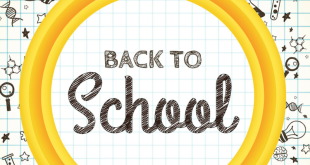
Transform Your Academic Year with Skolera
August 21, 2023
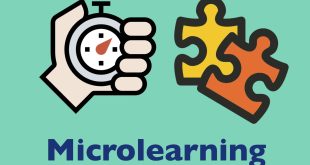
Microlearning: The Art of Learning in Bites
July 19, 2023

Blending Synchronous and Asynchronous Learning with an LMS
Imagine this for a moment, you stand at the front of your classroom, eager to …
Creative Thinking Definition
Creative thinking examples, why is creative thinking important, how to include creative thinking skills in a job application, how to build creativity, what is creative thinking definition and examples.
- Share on Twitter Share on Twitter
- Share on Facebook Share on Facebook
- Share on LinkedIn Share on LinkedIn
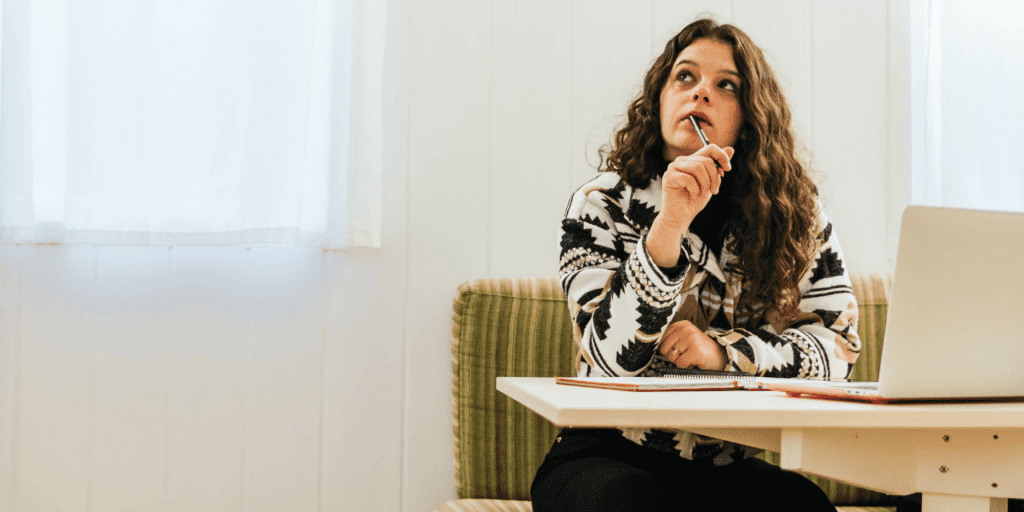
Forage puts students first. Our blog articles are written independently by our editorial team. They have not been paid for or sponsored by our partners. See our full editorial guidelines .
Table of Contents
Creative thinking is the ability to come up with unique, original solutions. Also known as creative problem-solving, creative thinking is a valuable and marketable soft skill in a wide variety of careers. Here’s what you need to know about creative thinking at work and how to use it to land a job.
Creative thinking is all about developing innovative solutions to problems. Creative thinkers brainstorm not only a large number of ideas but also a variety and range of them. In the workplace, creative thinking is highly valuable because employers look to hire innovative employees who can help them solve the company’s problems.
So, what does creative thinking in the workplace look like? First, a creative person brainstorms their ideas, then they’ll experiment with them. They look at ideas from multiple perspectives and examine how their solutions fit into the scope of what they’re working on. Creative thinkers aren’t afraid to take risks and try new ideas. In fact, this ability to develop, test, and implement original solutions makes them a valuable asset to just about any workplace.
Creative thinking in the workplace might look like:
- Holding an interactive brainstorm to gather initial thoughts on a project
- Evaluating a current process and offering suggestions on how to improve it
- Researching other ways to market a product and leading experiments on new marketing channels
- Developing an innovative way to reach out to prospective clients
- Identifying a unique opportunity to promote the company brand and developing a strategy to do so
- Discovering a new way to measure a product initiative’s success and using learnings to iterate on the next version
Finding patterns in a company’s revenue growth and using data trends to strategize a new sales plan
Creative thinking includes the process of innovative problem-solving — from analyzing the facts to brainstorming to working with others. Creative thinking examples include analytical skills, innovation, and collaboration.
Analytical Skills
Analytical skills are problem-solving skills that help you sort through facts, data, and information to develop rational solutions. These skills aid you in the first part of the creative thinking process as you brainstorm and start to generate ideas.
Analytical skills include:
- Data analysis
- Forecasting
- Interpreting
- Communication
Innovation is the ability to come up with something new; however, you don’t need to develop the first flying car to be an innovative thinker. “Something new” at work might mean a method you haven’t tried before or experimenting with an unfamiliar process. Innovators in the workplace aren’t afraid to step away from tradition and explore something original, even if it might fail.
Innovation skills include:
- Risk-taking
- Brainstorming
- Critical thinking
Collaboration
Creative thinking doesn’t have to happen alone; you might have your most creative ideas when bouncing your work off others. Collaboration skills ensure you consider multiple perspectives and ways of thinking when you develop and refine ideas.
Collaboration skills include:
- Written and verbal communication
- Active listening
- Inclusivity
A soft skill like creative thinking will always be valuable to employers, whether you’re looking for a marketing job or trying to land a career in finance . Employers need employees who can develop and experiment with new ideas to help them solve complex problems.
“Many employers seek candidates that are analytical and outside-the-box thinkers which are iterations of creative thinking skills,” says Alejandra Garcia, manager, alumni college and career success at Code2College and Forage content development partner. “Thus, creative thinking, creative problem solving, innovative thinking, and analytical skills are all valuable in the current workplace — these skills are especially important in our ever-changing workplaces with new emerging technologies.”
The data supports this idea, too. According to the World Economic Forum’s 2023 Future of Jobs report , creative thinking is the second most important skill for workers in 2023, preceded only by analytical skills. Other top skills include soft skills like resilience, flexibility and agility, motivation and self-awareness, and curiosity and lifelong learning .
“The ability to navigate new challenges quickly can benefit any workplace!” Laura Fontenot, resume writing expert, ACRW, and CPRW, says. “The current world of work is fast-paced, technically driven, and constantly changing. Being intuitive, creative, driven, and a problem solver are key.”
If creative thinking is one of the top soft skills employers look for, how do you show you have it in a job application? The key is to prove these skills through examples of how you’ve used them rather than just naming them.
On a Resume
While creative thinking is a skill employers might look for, you don’t necessarily need to write “creative thinking” on your resume to show you have this skill. Instead, it’s better to demonstrate how you’ve used creative thinking skills to drive results.
“Think of your best mental strengths,” says Fontenot. “Are you a great problem solver? Do you understand how to phrase things differently? Can you learn a new skill quickly? Those questions can help you find great words for the resume . Consider adding things like problem-solving, intuition, collaboration, fast learner, organized, or communication.”
Log in to view and download a customizable resume template with examples of how to include creative thinking skills:
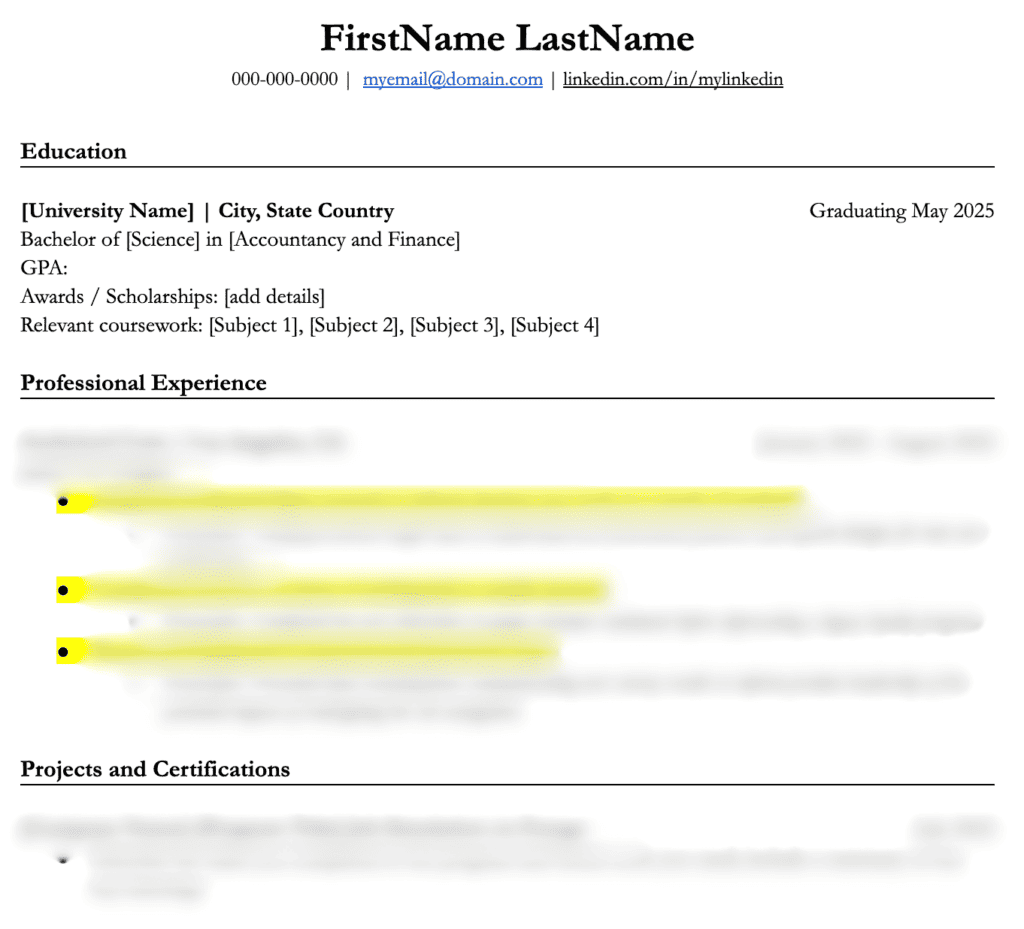
On Your Professional Profiles
You can show these skills outside of your resume in creative ways — including on your LinkedIn profile and website (if you have one!).
“Early professionals can make creative thinking a part of their professional brand by explicitly adding creative thinking or creative problem solving to their list of skills on their resumes and LinkedIn profiles — this will help with ATS optimizations,” Garcia advises.
Yet beyond just listing this skill, Garcia adds that you can provide real proof of your creativity online, too.
“Consider adding projects or an online portfolio website link to your resume and LinkedIn where you can showcase projects you’ve worked on that demonstrate their problem-solving skills.”
In the Interview
In the interview , make sure you can describe your workflow and process for these projects or any other situation when you’ve used creative thinking. Elaborate how you brainstormed ideas, what range of ideas you had, how you tested and experimented, and how you decided on a final solution.
It’s best to use the STAR method to structure your answers. This will ensure you clearly explain the situation and the results you brought by using your creative thinking skills.
>>MORE: Prepare to speak about your soft skills by practicing answers to commonly asked behavioral interview questions .
1. Put Yourself in a Box
Creative thinking is about “thinking outside the box,” but putting limitations on your problem-solving can help you think more freely and innovatively. For example, if someone tells you to make dinner, you may struggle to come up with a meal you don’t always cook. Yet if they ask you to make a hot dinner with three specific ingredients and two spices, you’ll more likely come up with something original.
Putting yourself inside a box can help expand your thinking, whether that’s by telling yourself you need to include three charts in your presentation or giving yourself a strict word count for an article.
2. Switch up Your Routine
Routine can be a great productivity booster, but it also can get in the way of your creativity. So, switch up your routine for one project, day, or even an hour. This can be something as small as where you’re physically sitting when you do your work or something as big as your process for approaching projects. Challenging yourself to do something different will help you find creative ways to adapt to your new environment.
3. Challenge What’s Currently Working
Think about how you might expand or improve upon a current process. What would you do if you had more resources, whether that’s time, money, or another expert? What would you do if you had fewer resources? If this project was taking place at a different time of year? If the target audience was different? Imagining these different potential scenarios will force you to problem-solve and adjust for various (very possible!) circumstances.
4. Find Inspiration
Creative thinking doesn’t happen in a bubble. It’s vital to ask for others’ opinions and ideas. Creative thinkers consider multiple perspectives and are curious about how others think. Ask your colleague about their work processes, whether it’s how they research for a client deliverable or how they approach meeting an external buyer.
5. Ask for Feedback
The best way to improve a skill is to get feedback from others on how you’re using it — and you don’t need to set up a formal feedback session to do so. Instead, ask questions when you’re working with others about your work. Keep these questions open-ended and lead with curiosity instead of looking for a specific answer. What did they think of how you led the brainstorm? What would they have done differently? What strikes them about the final product? Keep an open mind and remember not to take the feedback personally. It’s an opportunity to grow, and growing those skills might just help you land your next job!
Two Sigma Professional Skills Development Program
Level up your non-technical skills and learn how to approach problems, set goals, and communicate clearly.
Avg. Time: 5-6 hours
Skills you’ll build: Project planning, project management, relationship management, explaining analysis
Image credit: Canva

Related Posts
6 negotiation skills to level up your work life, how to build conflict resolution skills: case studies and examples, what is github uses and getting started, upskill with forage.

Build career skills recruiters are looking for.

- arrow_forward_ios Main menu
- Education sectors
- Scottish Attainment Challenge
- About Curriculum for Excellence
- Curriculum Themes
- Curriculum areas
- Key documents
- National approach to professional learning
- Professional learning programmes, webinars and events
- Leading professional learning
- Self-directed professional learning
- Resources search
- Resources by type
- Resources by theme
- Find an inspection report
- What we do and how we do it
- HM Chief Inspector reports and guidance
- Inspection Frameworks
- Parentzone Scotland
- Resources ›
What are creativity skills?
Log in or register
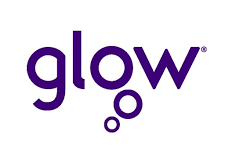
Thank you for registering
Not received your email, forgotten password.

The World Economic Forum states that by 2025, the top five skills employers will be looking for include innovation, complex problem solving, critical thinking, creativity and originality. Creativity is one of our most essential skills.
Here in Scotland we define creativity skills in a way that educators across all sectors can identify, value and discuss with learners:
- Open-Mindedness
- Imagination
- Problem solving
The development of creativity skills is a responsibility of all educators and the infographic What are creativity skills? offers a succinct starting point. Every school and early learning centre in Scotland has received posters of the visual, and all local authorities received a set of pull-up banners of creativity infographics, including this one. You can download the visual , or contact your local Creative Learning Network/key contacts to access the pull up banners for events, CLPL or to use with learners. You can also download activities to accompany the banners.
Education Scotland, often in partnership with Creative Scotland, offers many means of support for educators including:
- films to develop creativity skills
- tools to plan, develop and evaluate creativity skills
- funded Creative Learning Networks that support creativity across learning, teaching and employability at a local level
- films and tools that support creative change, planning and improvement.
A full list of creativity resources is available below.
PDF file: What Are Creativity Skills? (771 KB)
PDF file: What Are Creativity Skills? - Gaelic version (180 KB)
ZIP file: What are creativity skills downloadable jpeg versions
PDF file: Creativity banner activities (279 KB)
Share this resource:
We use cookies to ensure that we give you the best experience on our website. If you continue to use this website, we'll assume that you are happy to receive these cookies. Accept and Close Find out more about cookies.

What Is Creative Thinking And Why It Is Important
When learning is purposeful, creativity blossoms. When creativity blossoms, thinking emanates. When thinking emanates, knowledge is fully lit. When knowledge…

When learning is purposeful, creativity blossoms. When creativity blossoms, thinking emanates. When thinking emanates, knowledge is fully lit. When knowledge is lit, economy flourishes. – A.P.J. Abdul Kalam
How often do you take time out from your day-to-day pressures and tedious meetings to glance out of the window and dream? How often do you deviate from the mundane routine and let your imagination run wild?
Unless you break free from ‘short-term’ and ‘shortcut,’ your thinking will not deepen. Unless you set your mind free to dream and ideate, your creativity will not blossom.
So to start with, take time out to understand what is creative thinking and why is it important.
What is creative thinking?
Creativity is the ability to generate a thought or an idea that is completely new, appealing, and useful. Creative thinking is a skill that enables you to come up with original and unconventional ideas.
Creative thinking expresses itself in a multitude of ways. A graphic artist creates a brilliant logo. A lawyer discovers an out-of-the-box strategy to defend her client. A photographer captures an extraordinary frame when out in the field. A product designer solves a problem with his innovative product.
Who says creative thinking is limited only to the artists, painters, designers, or writers? Creative skills give an edge to all professionals. It drives innovation and progress in almost every field. The eureka moment of cracking an idea can be experienced by anyone and everyone.
It is clear that exceptionally creative people are found in STEM fields—Science, Technology, Engineering, and Mathematics—as well. Designing an app, assembling a robot, creating an Artificial Intelligence application, and developing an online social network requires high levels of creative thinking.
Types of Creative Thinking
The celebrated author and psychologist Edward de Bono has said that creativity involves breaking out of established patterns in order to look at things in a different way. What are these different ways? Let’s go a little deeper.
Divergent Thinking: Exploring multiple perspectives with flexibility, fluency, and originality to find a solution for a problem.
Lateral Thinking: Exploring new ideas, thinking outside the box, avoiding clichés
Aesthetic Thinking: Visual or spatial thinking with the use of structure, colors, composition to achieve aesthetic beauty
Systems Thinking: Identifying an interrelation between things and viewing them from a 360-degree perspective
Inspirational Thinking: Lightbulb moments inspired by great personalities or insightful thoughts
Abstract Thinking: Thinking in terms of objects, principles and experiences that may not be physically or materially present
Design Thinking: Applying strategy, problem-solving and decision-making to the process of design
Once you know what is creative thinking, you can stay a step ahead by applying that knowledge to the way you carry out your communications. Research indicates that the companies that believe in fostering creative thinking outperform their competitors in every functional area.
Creativity is one of the most in-demand skills in the world. Have you seen those superhero movies with great VFX technology? The visuals are spectacular. The technology is state-of-the-art. But without a powerful creative concept and storyboard, the entire movie can be a flop show. That’s where creative thinking plays a role.
A person who knows the importance of creative thinking is open-minded in approach. Their assumptions are unbiased, they possess the problem-solving ability, and are impactful verbal and written communicators. They are able to analyze a brief and distill it to its essence.
Harappa Education’s Unleashing Creativity course explains how to cultivate a creative mindset. It acquaints you with creative approaches to problem-solving. Through the course, you will also learn how to exercise your creativity in groups.
The importance of creative thinking
It is indispensable.
The world has taken a technological leap. Today, robots click photographs. Yet, some photographs stand out because they reflect the mind and intent of a talented professional.
Jobs in many industries have been replaced by automation. Still, creative thinkers are in high demand because originality is irreplaceable. Creative thinking is indispensable.
It gives you freedom
You must have noticed how a child’s imagination soars boundlessly. Children are naturally creative thinkers because they haven’t been bound by the ways of the world just yet. Creative thinking thrives when individuals and groups are free of artificially-imposed constraints.
Set your mind free to explore other perspectives, ‘the other side’. Then, deploy your ideas into your endeavors and see the difference. You must have heard how famous filmmakers and music directors go to hill stations or remote places to brainstorm, write and compose. To get work done, many writers prefer the quiet of country-side living to the clutter of cities.
It improves the problem-solving process
Sunil was his boss’s favorite assistant because he was an efficient problem-solver. With his creative thinking skills, he always found a solution to any unforeseen problem.
The importance of creative thinking in problem-solving is crucial. It enables you to face a challenge and think about it from all angles.
It adds to leadership qualities
Throughout history, inspiring leaders from various walks of life have been included in creative thinker examples. They achieve the highest level of excellence on the back of extraordinary ideas that have the potential to change the course of history, art, or a nation.
Take, for instance, Leonardo da Vinci, Michelangelo, Mahatma Gandhi, JRD Tata, Swami Vivekanand, Satyajit Ray. These creative minds have left indelible imprints in their chosen area of work.
It boosts productivity
Steve Jobs is considered one of the striking creative thinker examples. The Apple co-founder had a vision that transformed people’s lives with several mini-revolutions: beginning with the personal computer and then going on to the iPod and, later, the iPhone.
Steven Spielberg’s work heralded a new era in filmmaking. Albert Einstein pushed the boundaries of accepted thinking with his own ideas. ‘Logic will get you from A to B. Imagination will take you everywhere,’ he said.
A workplace that encourages creativity is a productive workplace. Encouraging creativity leads to more innovative ideas, less fear of failure, and greater emotional investment.
It makes people happier
Giving people a free hand to apply their creative thinking makes them happy. It gives them a sense of being unshackled from barriers. Such liberation yields more constructive results in the workplace. You must have noticed that you work better in a place where you are appreciated and valued.
Filmmaker Walt Disney chased his dream to make people happy through entertainment. He came up with a word that typifies his vision: Imagineering, that is imagination plus engineering. For Disney, it was fun to attempt the impossible. Yet another one of the fascinating creative thinker examples!
It leads to personal growth
Those who have bigger dreams and long-term goals should never underestimate the importance of creative thinking. It pushes you out of your comfort zone and transports you into a creative zone.
The more you create, the more you grow in terms of mindset as well as skill sets. Also, when you commit time to pursue your passions, the quality of your life goes up.
All creative thinker examples prove that such ability empowers and elevates your career graph. In the process, you obtain valuable insights about yourself.
You discover your habits, dreams, desires, and impulses. You learn to value yourself and express it in your creative output.
For it to be a high-reward endeavor, build your creative skills systematically. It’s true that some people are born with inherent creative strengths. But it’s also true that creativity can be sown and nurtured with strategy and practice.
How to enhance your creative thinking?
Pay attention to your strengths and try to incorporate more of them in your life
Tap into your inner child and explore the qualities of freshness, purity of thought and spontaneity of expression
Do not restrict yourself to a habitual pattern. Think differently. Take a different route to communicate your thoughts. Never go by stereotypes
Enjoy yourself in natural settings and set your imagination free to explore and experiment
Be curious and inquisitive about your surroundings
Don’t hesitate to take risks to further your abilities
Get rid of the negative attitudes that are blocking your creativity
Indulge in brainstorming to inspire new ideas
Accept that a problem can have multiple solutions and explore every possibility
Harappa’s Unleashing Creativity course equips you with the Design Thinking framework that encourages thinking about the end-user while developing products and services.
Through the course, you will also gain the confidence to find solutions, drive innovation, and use an iterative approach to generate, test and refine new ideas.
Yes, the creative woods are lovely, dark, and deep. So get ready for a long and wonderful journey of many, many miles!
Explore our Harappa Diaries section to know more about topics related to the Think habit such as What is Critical Thinking , Design Thinking & What is an Argument .

- Become a Member
- Artificial Intelligence
- Computational Thinking
- Digital Citizenship
- Edtech Selection
- Global Collaborations
- STEAM in Education
- Teacher Preparation
- ISTE Certification
- School Partners
- Career Development
- ISTELive 24
- Solutions Summit
- Leadership Exchange
- 2024 ASCD Leadership Summit
- 2025 ASCD Annual Conference
- Edtech Product Database
- Solutions Network
- Sponsorship & Advertising
- Sponsorship & Advertising
- Learning Library
5 Reasons Why It Is More Important Than Ever to Teach Creativity
- Education Leadership

On the laundry list of skills and content areas teachers have to cover, creativity doesn’t traditionally get top billing. It’s usually lumped together with other soft skills like communication and collaboration: Great to have, though not as important as reading or long division.
But research is showing that creativity isn’t just great to have. It’s an essential human skill — perhaps even an evolutionary imperative in our technology-driven world.
“The pace of cultural change is accelerating more quickly than ever before,” says Liane Gabora , associate professor of psychology and creative studies at the University of British Columbia. “In some biological systems, when the environment is changing quickly, the mutation rate goes up. Similarly, in times of change we need to bump up creativity levels — to generate the innovative ideas that will keep us afloat.”
From standardized tests to one-size-fits-all curriculum, public education often leaves little room for creativity, says EdNews Daily founder Robyn D. Shulman . This puts many schools out of sync with both global demand and societal needs, leaving students poorly prepared for future success.
What can education leaders do about it? For starters, they can make teaching creativity a priority. Here are five reasons to encourage teachers to bring more creativity into the classroom:
1. Creativity motivates kids to learn.
Decades of research link creativity with the intrinsic motivation to learn. When students are focused on a creative goal, they become more absorbed in their learning and more driven to acquire the skills they need to accomplish it.
As proof, education leader Ryan Imbriale cites his young daughter, who loves making TikTok videos showcasing her gymnastics skills. “She spends countless hours on her mat, working over and over again to try to get her gymnastics moves correct so she can share her TikTok video of her success,” says the executive director of innovative learning for Baltimore County Public Schools.
Students are most motivated to learn when certain factors are present: They’re able to tie their learning to their personal interests, they have a sense of autonomy and control over their task, and they feel competent in the work they’re doing. Creative projects can easily meet all three conditions.
2. Creativity lights up the brain.
Teachers who frequently assign classwork involving creativity are more likely to observe higher-order cognitive skills — problem solving, critical thinking, making connections between subjects — in their students. And when teachers combine creativity with transformative technology use, they see even better outcomes.
Creative work helps students connect new information to their prior knowledge, says Wanda Terral, director of technology for Lakeland School System outside of Memphis. That makes the learning stickier.
“Unless there’s a place to ‘stick’ the knowledge to what they already know, it’s hard for students to make it a part of themselves moving forward,” she says. “It comes down to time. There’s not enough time to give them the flexibility to find out where the learning fits in their life and in their brain.”
3. Creativity spurs emotional development.
The creative process involves a lot of trial and error. Productive struggle — a gentler term for failure — builds resilience, teaching students to push through difficulty to reach success. That’s fertile soil for emotional growth.
“Allowing students to experience the journey, regardless of the end result, is important,” says Terral, a presenter at ISTE Creative Constructor Lab .
Creativity gives students the freedom to explore and learn new things from each other, Imbriale adds. As they overcome challenges and bring their creative ideas to fruition, “students begin to see that they have limitless boundaries,” he says. “That, in turn, creates confidence. It helps with self-esteem and emotional development.”
4. Creativity can ignite those hard-to-reach students.
Many educators have at least one story about a student who was struggling until the teacher assigned a creative project. When academically disinclined students are permitted to unleash their creativity or explore a topic of personal interest, the transformation can be startling.
“Some students don’t do well on tests or don’t do well grade-wise, but they’re super-creative kids,” Terral says. “It may be that the structure of school is not good for them. But put that canvas in front of them or give them tools so they can sculpt, and their creativity just oozes out of them.”
5. Creativity is an essential job skill of the future.
Actually, it’s an essential job skill right now.
According to an Adobe study , 85% of college-educated professionals say creative thinking is critical for problem solving in their careers. And an analysis of LinkedIn data found that creativity is the second most in-demand job skill (after cloud computing), topping the list of soft skills companies need most. As automation continues to swallow up routine jobs, those who rely on soft skills like creativity will see the most growth.
“We can’t exist without the creative thinker. It’s the idea generation and the opportunity to collaborate with others that moves work,” Imbriale says.
“It’s one thing to be able to sit in front of computer screen and program something. But it’s another to have the conversations and engage in learning about what somebody wants out of a program to be written in order to be able to deliver on that. That all comes from a creative mindset.”
Nicole Krueger is a freelance writer and journalist with a passion for finding out what makes learners tick.
- artificial intelligence
- Our Mission
Creativity and Academics: The Power of an Arts Education
The arts are as important as academics, and they should be treated that way in school curriculum. This is what we believe and practice at New Mexico School for the Arts (NMSA). While the positive impact of the arts on academic achievement is worthwhile in itself, it's also the tip of the iceberg when looking at the whole child. Learning art goes beyond creating more successful students. We believe that it creates more successful human beings.
NMSA is built upon a dual arts and academic curriculum. Our teachers, students, and families all hold the belief that both arts and academics are equally important. Our goal is to prepare students for professional careers in the arts, while also equipping them with the skills and content knowledge necessary to succeed in college. From our personal experience ( and research ), here are five benefits of an arts education:
1. Growth Mindset
Through the arts, students develop skills like resilience, grit, and a growth mindset to help them master their craft, do well academically, and succeed in life after high school. (See Embracing Failure: Building a Growth Mindset Through the Arts and Mastering Self-Assessment: Deepening Independent Learning Through the Arts .) Ideally, this progression will happen naturally, but often it can be aided by the teacher. By setting clear expectations and goals for students and then drawing the correlation between the work done and the results, students can begin to shift their motivation, resulting in a much healthier and more sustainable learning environment.
For students to truly grow and progress, there has to be a point when intrinsic motivation comes into balance with extrinsic motivation. In the early stages of learning an art form, students engage with the activity because it's fun (intrinsic motivation). However, this motivation will allow them to progress only so far, and then their development begins to slow -- or even stop. At this point, lean on extrinsic motivation to continue your students' growth. This can take the form of auditions, tests, or other assessments. Like the impact of early intrinsic motivation, this kind of engagement will help your students grow and progress. While both types of motivation are helpful and productive, a hybrid of the two is most successful. Your students will study or practice not only for the external rewards, but also because of the self-enjoyment or satisfaction this gives them.
2. Self-Confidence
A number of years ago, I had a student enter my band program who would not speak. When asked a question, she would simply look at me. She loved being in band, but she would not play. I wondered why she would choose to join an activity while refusing to actually do the activity. Slowly, through encouragement from her peers and myself, a wonderful young person came out from under her insecurities and began to play. And as she learned her instrument, I watched her transform into not only a self-confident young lady and an accomplished musician, but also a student leader. Through the act of making music, she overcame her insecurities and found her voice and place in life.
3. Improved Cognition
Research connects learning music to improved "verbal memory, second language pronunciation accuracy, reading ability, and executive functions" in youth ( Frontiers in Neuroscience ). By immersing students in arts education, you draw them into an incredibly complex and multifaceted endeavor that combines many subject matters (like mathematics, history, language, and science) while being uniquely tied to culture.
For example, in order for a student to play in tune, he must have a scientific understanding of sound waves and other musical acoustics principles. Likewise, for a student to give an inspired performance of Shakespeare, she must understand social, cultural, and historical events of the time. The arts are valuable not only as stand-alone subject matter, but also as the perfect link between all subject matters -- and a great delivery system for these concepts, as well. You can see this in the correlation between drawing and geometry, or between meter and time signatures and math concepts such as fractions .
4. Communication
One can make an argument that communication may be the single most important aspect of existence. Our world is built through communication. Students learn a multitude of communication skills by studying the arts. Through the very process of being in a music ensemble, they must learn to verbally, physically, and emotionally communicate with their peers, conductor, and audience. Likewise, a cast member must not only communicate the spoken word to an audience, but also the more intangible underlying emotions of the script. The arts are a mode of expression that transforms thoughts and emotions into a unique form of communication -- art itself.
5. Deepening Cultural and Self-Understanding
While many find the value of arts education to be the ways in which it impacts student learning, I feel the learning of art is itself a worthwhile endeavor. A culture without art isn’t possible. Art is at the very core of our identity as humans. I feel that the greatest gift we can give students -- and humanity -- is an understanding, appreciation, and ability to create art.
What are some of the benefits of an arts education that you have noticed with your students?
New Mexico School for the Arts
Per pupil expenditures, free / reduced lunch, demographics:.
Teaching Skills for the 21st Century: Creativity
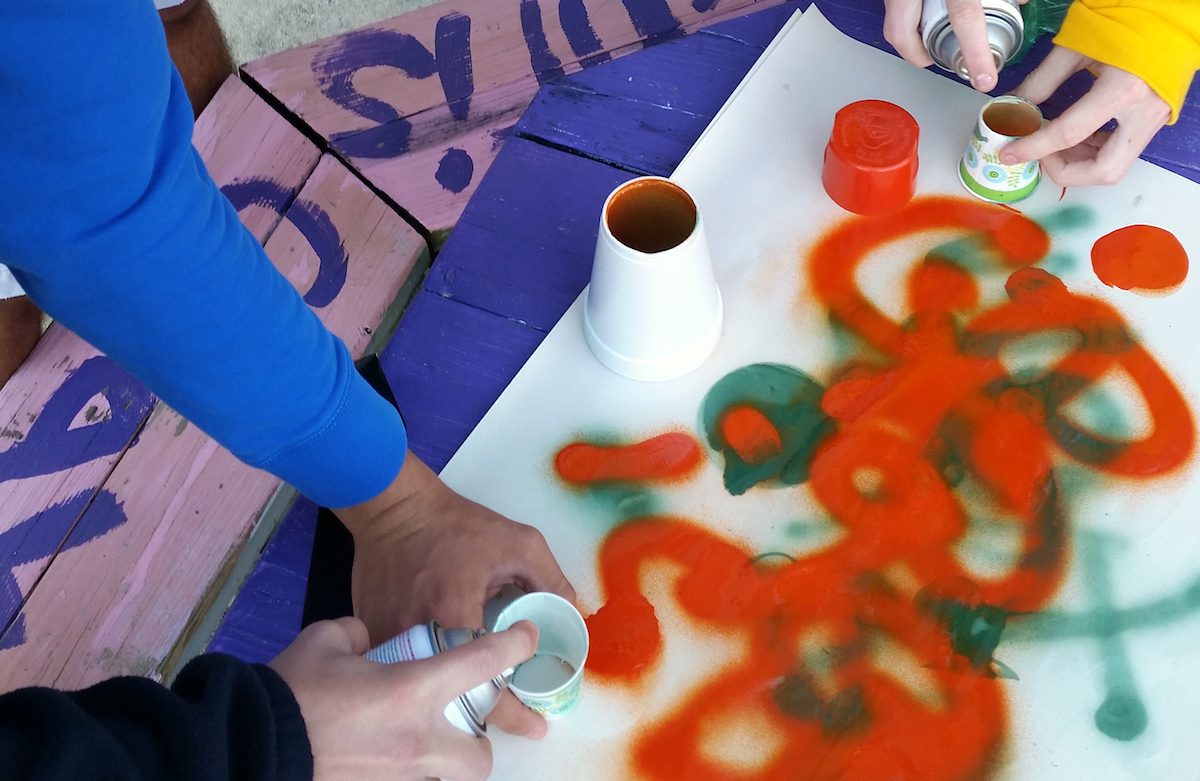
Our job as educators is to prepare our students for life after school. However, the rapid development of technology means that we have no idea what the future will look like, only that change will be a constant.
The Partnership for 21st Century Learning writes “Learning and innovation skills increasingly are being recognized as the skills that separate students who are prepared for increasingly complex life and work environments in the 21st century, and those who are not.”
Art education has a crucial role to play in developing these skills, but we need to first examine the way we teach and adapt our pedagogy to fit the needs of our students.
Often, in art class, the creative tasks that students engage in are unnecessarily close-ended. Teaching creativity involves directly teaching idea generation, planning for work, and problem-solving. To really learn these things kids have to apply them by being expected to ask the question “What do I want to make?” and being tasked with figuring out the answer.
I teach this in my classroom with a process called Design Process Thinking which I’ve developed. It’s the structure for every lesson I teach. In the beginning stages of a course, I provide a fair amount of direction and support while students learn and apply specific strategies. Each strategy learned becomes a tool that students are expected to apply with increasing independence.

Here’s how each part of the process plays out in the classroom:
Inspiration.
Students learn about themes, media, processes, and personal experiences as possible starting points for ideas. As learners become more comfortable with searching for ideas, they learn how to develop guiding questions that drive self-directed work.
In Practice:
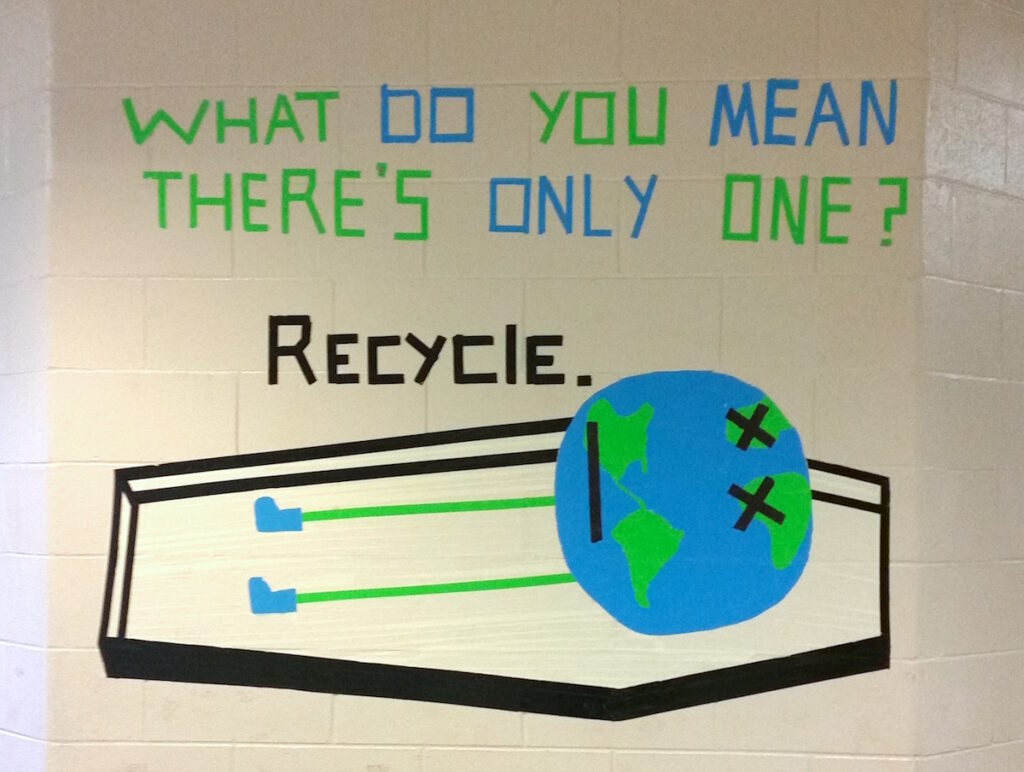
Too often, we get stuck at offering sketching as the main design process for developing ideas. Instead of following steps, kids need to develop the capacity to select the strategy that represents the best way to develop ideas. To teach the skills needed to bring ideas to fruition we need to differentiate by teaching additional strategies, like researching, experimenting with materials, and mind mapping.
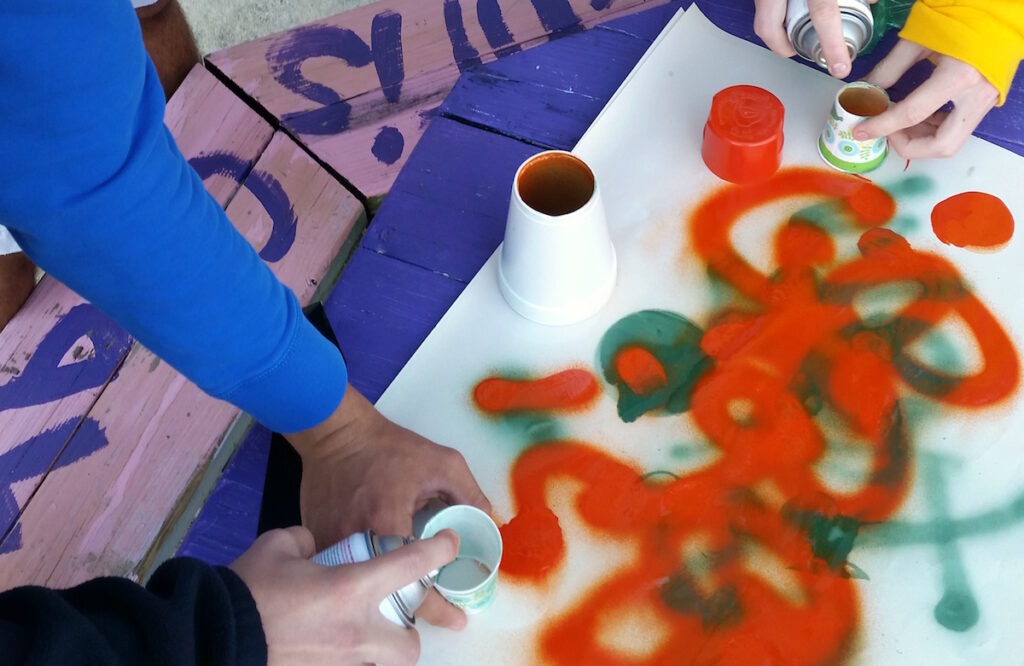
This phase hinges on teaching students the types of questions to ask themselves as they work.
- Is this working?
- What needs to be changed?
- Is it finished?
- Is it successful?
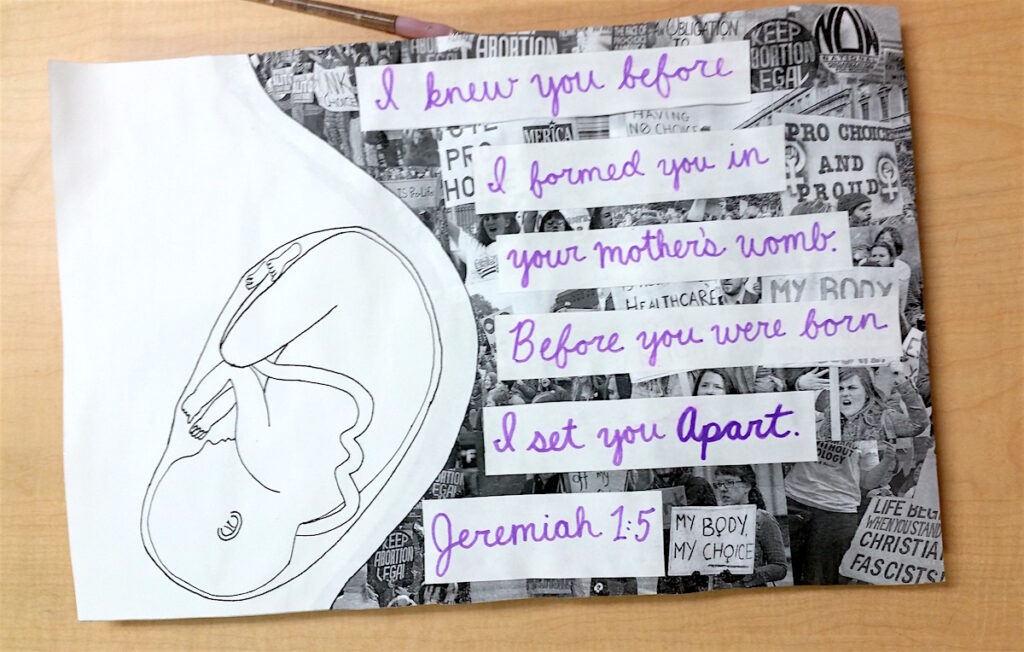
The student who made the work pictured above wanted to say something about abortion. I helped her express her views on this controversial subject through discussion and feedback as she worked. It was important to her to create artwork that showed the complexity of the issue and also that reflected her personal belief system in a way that would make the viewer think. We talked about how she could use tools like text and juxtaposition to communicate her vision.
Reflection & Presentation
This phase is used to sum up the learning that has occurred and to examine next steps. It’s a time to share and celebrate work but also to be accountable for learning. I ask students to engage in a number of activities to accomplish this: sharing work on student-created blogs , presenting, and participating in critiques.
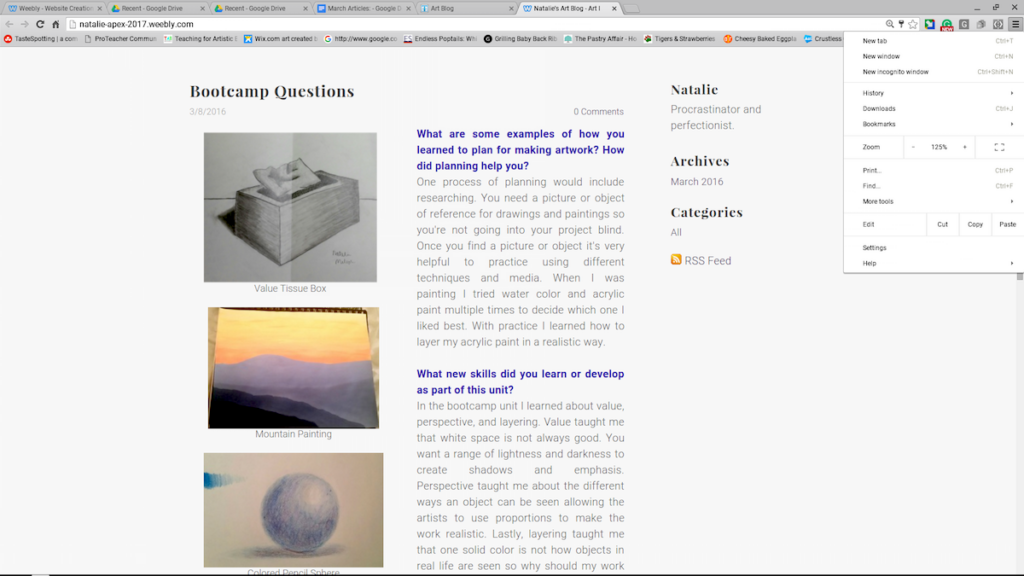
Blogging is a great way to develop reflective thinking. I plan questions that ask students to examine what they’ve learned during each unit and how they feel about the artwork produced. Students post images and text to answer each question, which gives me individualized insight into what they’ve learned.
The Takeaway
We, as art educators, are the idea people in schools. The Framework for 21st Century Learning presents an opportunity and a challenge for us to highlight the value of what we do. For the future of our students and our programs, we must examine how we teach creative thinking to students. In the past, the responsibility for finding inspiration and designing work has fallen mostly on teachers. It’s time for every art class, at every level, to shift that role to students.
How do you teach creative thinking in your classroom?
How have you shifted the responsibility for finding inspiration and designing work to your students?
Magazine articles and podcasts are opinions of professional education contributors and do not necessarily represent the position of the Art of Education University (AOEU) or its academic offerings. Contributors use terms in the way they are most often talked about in the scope of their educational experiences.

Melissa Purtee
Melissa Purtee is a high school art educator and a former AOEU Writer. She is passionate about supporting diversity, student choice, and facilitating authentic expression.
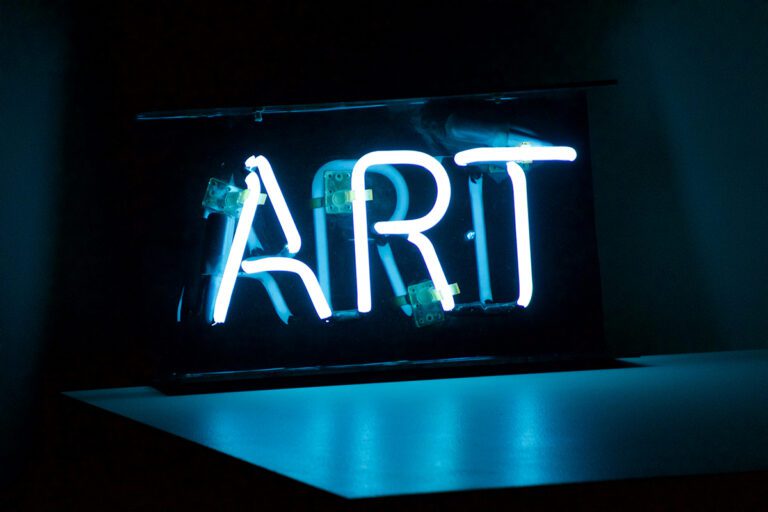
How to Engage Students on Day One by Redefining Art
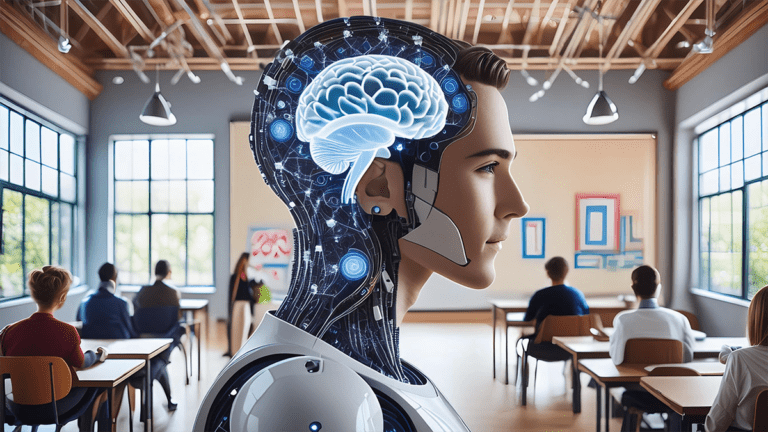
Discover How to Teach Responsible Artificial Intelligence (AI) Use in the Art Room
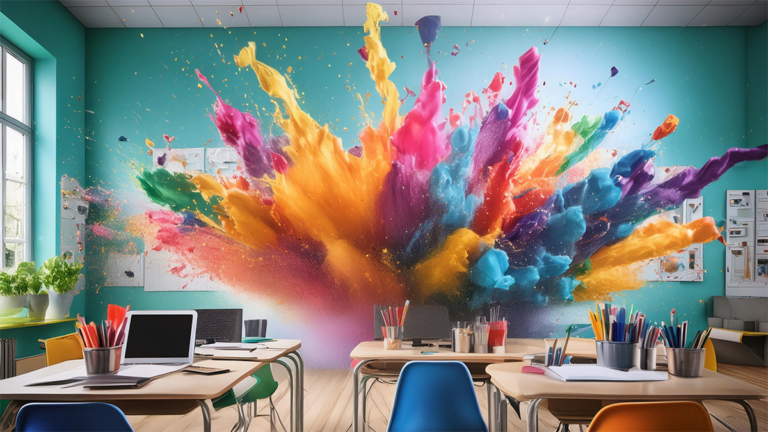
Ways AI Can Make Your Art Teacher Job Easier for Planning and Assessment
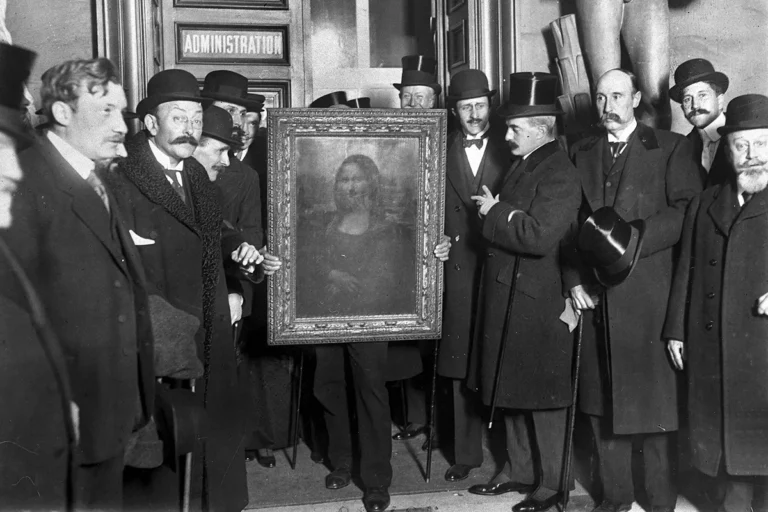
Daring Art Crimes for the Art Teacher That You Won’t Be Able to Put Down!
Fostering Creativity: 12 Strategies to Boost Creative Skills

It has also been called “ the skill of the future” (Powers, 2018).
This is partly because creativity helps individuals adapt to uncertainty and solve problems as they arise. Research has also suggested that creativity – as a component of the personality factor “ openness to experience” – is a better predictor of an extended lifespan than intelligence or overall openness to experience (Turiano, Spiro, & Mroczek, 2012).
For our own good then, it would appear creativity is worth cultivating. But can it be cultivated? If so, how? And what is creativity?
In the following article, we explore what creativity is and how personal creativity can be fostered. We discuss creativity in the classroom and workplace. We touch on creativity in art and music. We also note the intriguing connection between nighttime and creativity.
Before you continue, we thought you might like to download our three Strengths Exercises for free . These detailed, science-based exercises will help you or your clients realize your unique potential and create a life that feels energized and authentic.
This Article Contains:
What is creativity, 6 ways (+1) to be more creative, fostering creativity in the classroom: 3 tips, 3 steps for a more creative workplace, becoming more creative in art and music: solitude and collaboration, the link between night and creativity, positivepsychology.com’s resources, a take-home message.
Creativity can be defined as the ability to bring something original and valuable into the world.
Creativity can occur in almost any field. It happens in art and music, of course. It can also happen in mathematics, engineering, science, business, education. Anywhere there are problems to be solved or the mind seeks expression, creativity can be found.
Is creativity a trait that a privileged few are born with?
Not at all. In fact, research on creativity shows it can be fostered in anyone (Neumann, 2007).
Let’s take a look then at how creativity can be encouraged in any person.

1. Daily walking
Walking is the evolutionary basis for many human abilities. It is also known to foster creativity. As O’Mara (2019) writes, our ability to walk upright on our own two feet (bipedalism) has freed our hands and minds to create in ways no other animal can.
O’Mara (2019) holds that minds in motion are more creative. In one example, he relates that the Irish mathematician Sir William Hamilton had struggled for years with how to perform specific calculations in three-dimensional geometry.
Then one day in 1843, while walking beside the Royal Canal in Dublin, Hamilton made an intellectual breakthrough. He realized how quadrupled numbers or “quaternions” could be used to calculate not only in three but four dimensions (the fourth dimension being time). He quickly carved the formula for quaternions on a stone in the nearby Broom Bridge.
Since 1990, mathematicians from around the world have gathered for a commemorative “Hamilton Walk,” from his home in Dublin to the bridge where he carved his breakthrough formula.
Who knows what further mathematical breakthroughs might occur on this commemorative walk, sparked by minds in motion?
At Stanford University, Oppezzo and Schwartz (2014) compared individuals’ creativity while sitting to that when walking (including walking inside versus outside). Subjects were asked to perform various tasks requiring creativity while walking indoors on a treadmill, walking outdoors, sitting indoors, or sitting in a wheelchair outdoors as it was being pushed.
In one task, subjects were given three objects and asked to think of as many different uses as they could for each object. Overall, creative output was found to improve by about 60% when walking (either indoors or out), versus sitting. So, if you’re looking to boost your creativity, try going for a short walk – or a long one.
2. Set task limits
This idea is borrowed from an entrepreneur who called it “ embracing constraints” (Tank, 2019). This might seem counterintuitive at first. Doesn’t being creative imply being more expansive, letting one’s mind run free? Actually, setting strict limits can also foster creativity.
Tank (2019) cites the example of Theodor Geisel (Dr. Seuss), whose editor bet him he could not write a children’s book using only 50 different words. Geisel rose to the challenge, producing under this unusual constraint one of his bestselling and most memorable books: Green Eggs and Ham (Seuss, 1960).
So, consider setting some unusual limits for yourself. Whatever the activity, you might find that setting limits produces interesting and creative results.
Relaxation is known to enhance creativity. There are various proven ways to put oneself in a relaxed state. These include progressive muscle relaxation, diaphragmatic breathing, walking meditation, and yoga postures.
For example, progressive muscle relaxation has been associated with reductions in heart rate, anxiety, and perceived stress. In addition, relaxed states have been shown to foster thought processes important for creativity. For example, diaphragmatic breathing has been associated with improved attention, a key component in creative problem solving (Ma et al., 2017).
Furthermore, stress – the opposite of relaxation – is known to kill nerve cells in the hippocampus, an area of the brain where new memories are formed. These new memories help us make connections with other things, fueling the creative process. Stress management is, therefore, imperative.
So, take a break. Create a relaxed state for yourself by breathing deeply, stretching, going for a walk, whatever works for you. Once relaxed, you might find a creative answer to a problem that has been eluding you.
4. Collaborate
There is a famous image of the solitary genius, working alone in a lab or searching for a melody on a lone piano. But is the ‘solitary genius’ a myth? In a paper on collaboration and creativity, Uzzi and Spiro (2005, p. 447) note how collaboration can boost creative production: “ creativity is not only, as myth tells, the brash work of loners, but also the consequence of a social system of actors that amplify or stifle one another’s creativity. ”
Uzzi and Spiro (2005) argue that many of history’s great creators – such as Beethoven, Marie Curie, the Beatles, and Maya Angelou – were involved in creative networks in which members critiqued, encouraged and collaborated on each other’s projects.
So, if you tend to work alone and find yourself stuck on a project, consider seeking collaboration, for example, by discussing your project with another person in your field. You might find a new way forward on your project, with a little help from your friends.
5. Sleep on it
Artists, scientists, and other creative individuals have often described how sleep, and especially dreaming, helped them create new solutions to persistent problems.
For example, the psychobiologist Otto Loewi had a recurring dream that contained the design of an experiment. This experiment would later prove that brain cells communicate via chemicals or “neurotransmitters.” For this discovery, Loewi would share the Nobel Prize in medicine in 1936 (McCoy & Tan, 2014).
More recently, various experiments have shown how sleep promotes creative problem solving. One set of experiments suggested that in REM (dream phase) sleep, the brain replays memories to extract essential patterns or lessons from them.
In non-REM (deep or dreamless) sleep, the brain then makes connections between these patterns or lessons and other things we already know (Lewis, Knoblich, & Poe, 2018). We can thereby arrive at new solutions to problems that have preoccupied us during waking hours; as when, for example, James Watson dreamed of two intertwined serpents, leading to the discovery of DNA as a double helix (Conradt, 2012).
So, if your mind is stuck on a problem, try sleeping on it. You might wake up with your solution.
6. Genius hour
This tip for fostering creativity comes from a teacher who uses it in his classroom (Provenzano, 2015).
He calls it “genius hour,” but the period spent could be more or less than 60 minutes. The idea is to start a side project, something you are passionate about. The inspiration, ideas, and skills you develop in this labor of love might well translate to other, more routine projects, moving those forward in positive ways.
+1. Your creative tip
It seems appropriate that an article on fostering creativity would encourage you, the reader, to come up with at least one of your own tips in this regard. We invite you to think of something that has helped you foster creativity in yourself or others. Feel free to share any such suggestions in response to this article.
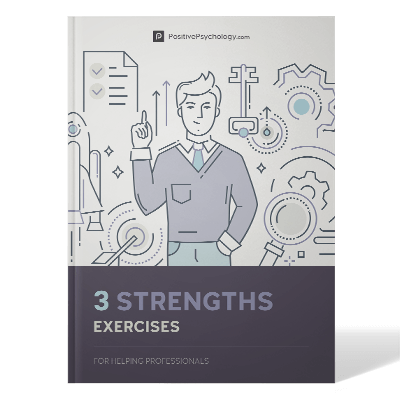
Download 3 Free Strengths Exercises (PDF)
These detailed, science-based exercises will equip you or your clients with tools to discover and harness their unique strengths.
Download 3 Free Strengths Tools Pack (PDF)
By filling out your name and email address below.
Allowing kids to develop their creativity from a young age will give them skills for a lifetime.
1. Value creativity
In the classroom, show your students that you value creativity. This can be done in many ways.
Encourage trial and error on tasks. Thomas Edison famously said, of different trials to solve a given problem, “ I haven’t failed. I’ve just found 10,000 ways that won’t work ” (Daum, 2016).
Sometimes, by finding what won’t work, you are led to what will, as when Edison tried hundreds of materials as microphone transmitters before successfully narrowing the choice to a small carbon disc.
2. Give it time
Valuing creativity also means giving it time in the classroom. Sarah Diaz, a kindergarten teacher in Spain, asserts that adequate time is crucial for creativity, especially for young children (Tornio, 2017). Consider giving students an entire class period each week to work freely on projects and materials they have chosen.
3. Write it down
Lauren Cassini Davis, a second-grade teacher, describes the effect on her classroom of handing out “Da Vinci” notebooks to all students (Davis, 2018). These are empty notebooks in which students are encouraged to write any questions, ideas, or expressions that occur to them, at any time during the day, on any topic, as Leonardo Da Vinci did throughout his long and creative life.
Ms. Davis relates how, within just one week, she was astounded by everything that the students had written in their notebooks. The notebooks were full of questions such as ‘How does your brain work?’ ‘Why do we have music?’ and ‘Why am I not a tiger?’ There were also poems, drawings of inventions, and comments about life in the classroom. These notebooks became a spur to all kinds of creative learning projects.

1. Break boundaries
In 2014, Steve Jobs and Apple unveiled a new corporate headquarters in Cupertino, CA.
According to Johnny Ives, Apple’s chief designer, this headquarters was meant to break down boundaries between offices and occupations.
The new Apple headquarters maximized common pathways and workspaces, allowing people to “ connect and collaborate and walk and talk” (Levy, 2017). It seems to have worked. In 2018, Fast Company recognized Apple as (still) the most innovative company in the world (Safian, 2018).
Fostering creativity takes dedicated time. We noted this above, concerning creativity in the classroom. It also applies to the workplace.
Google, for example, was known for its “20%” program. This program gave software developers and other employees permission to work 20% of their paid time on projects of their choosing. While Google eventually took back this 20% time, it was credited with spawning some of the company’s best products including Google News, Gmail, and AdSense.
Other companies have adopted various approaches to giving creative time in the workplace, with the consensus being that creativity is a business asset, and employees should be given time to explore and develop their new ideas (Subramanian, 2013).
3. Promote trial and error
According to business consultant Deborah Goldstein, creativity in business requires experimentation, and even failure, to be supported. She asserts that “ Experiments never fail. Even when the attempt fails, with the right mindset, teams learn priceless lessons to succeed in the future ” (Forbes Coaches Council, 2017).

World’s Largest Positive Psychology Resource
The Positive Psychology Toolkit© is a groundbreaking practitioner resource containing over 500 science-based exercises , activities, interventions, questionnaires, and assessments created by experts using the latest positive psychology research.
Updated monthly. 100% Science-based.
“The best positive psychology resource out there!” — Emiliya Zhivotovskaya , Flourishing Center CEO
In particular art forms, such as painting, work is often solitary. Artists need time and solitude to focus on the act of painting. Yet such solitude can be difficult to bear if not broken by social contact.
Jason Horejs (2020) writes of breaking the isolation that can occur in art. He cites the example of a female painter living in a small town in Montana. This artist speaks of how joining an artists’ group in her area helped her socially and artistically.
The group meets every Saturday to paint together. They regularly hold art shows with constructive critiques of each other’s work. They also have a group website with links to individual artists’ web pages.
Such collective pursuits have helped this artist remain inspired and creative, even when alone in her studio. In the end, it might be some mixture of solitude and collaboration that keeps us creative in art. What of music?
In his autobiography Testimony (2016), Robbie Robertson, guitarist and principal songwriter for The Band , describes how his band was used to creating songs.
Robertson often drafted songs on his own. He sketched “The Weight,” a classic The Band song, by himself in one night. Afterward, he would bring these song ideas to the group.
They worked in close company to flesh the songs out, in the basement of a large pink house in upstate New York. Their group creativity thrived on being able to hear each other’s musical ideas, moment to moment. It was also important for them to see each other’s musical cues.
Robertson then relates how during their first recording session for Capitol Records, band members were separated from each other in the studio. Partitions had been put up to better record the distinct sound of each instrument. However, the band members soon found that without being able to see or hear each other as usual, they lacked the organic sound that had so impressed Bob Dylan and other musicians.
At Robertson’s insistence, the studio partitions were removed. The resultant recordings went on to become the highly creative and acclaimed album Music from Big Pink . The Band had thus found the type of working and studio environment that facilitated creativity for them.
And Robertson had found the interplay between solitude and collaboration that worked best for The Band ’s material. Again, it might be a unique balance of solitude and collaboration that helps us be most creative in art and music.

As nocturnal (versus diurnal or daytime) types, we find the quiet of night refreshing and open with possibilities.
Some well-known “night owls” more inclined to working and innovating after dark include individuals as diverse as Winston Churchill, Christina Aguilera, Bob Dylan, Fran Leibowitz, and Barack Obama (Curtin, 2018).
Giampietro and Cavallera (2007) explored creativity in people inclining toward a nocturnal work schedule. They found nocturnal types scored more highly than diurnals on a task (Torrance Test of Creative Thinking) measuring creativity on dimensions of originality, fluidity, and flexibility of responses.
But take heart, diurnal types.
Plenty of diurnal individuals swear by such pro-daytime habits as rising early and are very creative in their own right. Apple CEO Tim Cook rises at 3:45 a.m., while Oprah Winfrey, Michelle Obama, and General Stanley McCrystal are also early risers, who swear this starts their day off right.
In the end, what counts most is finding the schedule – nocturnal, diurnal, or somewhere in between – that best suits your personality, circumstances, and creativity.
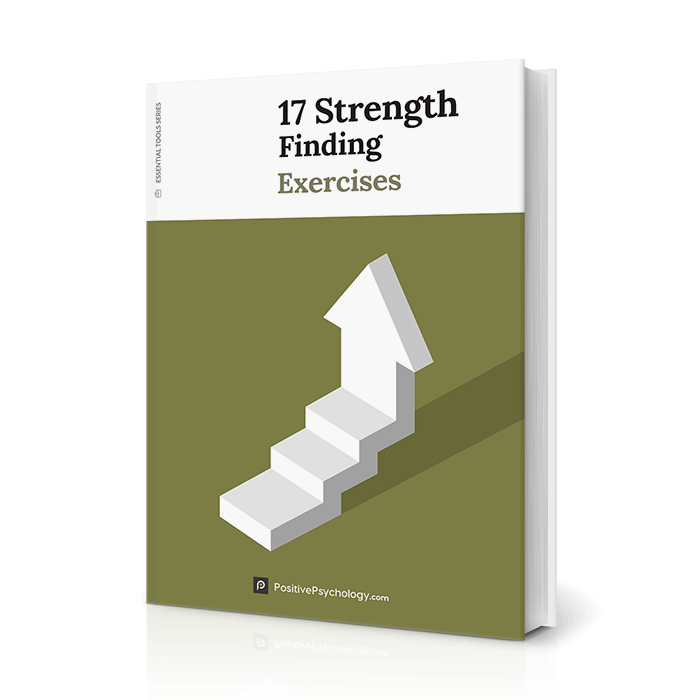
17 Exercises To Discover & Unlock Strengths
Use these 17 Strength-Finding Exercises [PDF] to help others discover and leverage their unique strengths in life, promoting enhanced performance and flourishing.
Created by Experts. 100% Science-based.
The following PositivePsychology.com worksheets might also prove helpful in fostering creativity.
- Visualize Success . This resilience-building exercise invites individuals to engage their creative thinking to visualize successful performance.
- Career Visualization . This exercise is similar to the previous visualization, and is designed to help individuals imagine in a detailed way how it would look, feel, and be to have the career they would like.
- Social Problem Solving . This exercise was developed to help individuals or groups apply brainstorming techniques when solving problems. Clients generate as many solutions as they can to a problem, emphasizing quantity over quality, then assess each possible solution in terms of effort required
- Designing Affirmations Worksheet . This exercise was developed to help individuals creating self-affirmations that can help them help them build self-esteem.
If you’re looking for more science-based ways to help others develop their strengths, this collection contains 17 strength-finding tools for practitioners. Use them to help others better understand and harness their strengths in life-enhancing ways.
Creativity – the ability to bring something original and valuable into the world – is not reserved for a privileged few artists or intellectuals. We all have the potential to be creative. This potential can be cultivated by finding the specific means for enhancing creativity in a given individual or group.
Specific means for an individual might include going for a walk or engaging in relaxation exercises that enhance thinking and creativity.
Means for cultivating creativity in groups might include providing students or employees with Da Vinci-style notebooks for writing down ideas as they occur, designing workspaces that invite collaboration, or setting aside “genius time” for your students’ or employees’ creative pursuits.
In the end, we need to be adaptive and innovative in finding the means by which creativity is enhanced for a particular person, group, or situation.
We hope you enjoyed reading this article. Don’t forget to download our three Strengths Exercises for free .
- Clarke, J. (2018). Breeding ideas. Minds at Work. Retrieved from http://www.mindsatwork.com.au/innovation-2/breeding-ideas/
- Conradt, S. (2012, October 11). Creative breakthroughs people had in their sleep. Mental Floss. Retrieved from https://www.mentalfloss.com/article/12763/11-creative-breakthroughs-people-had-their-sleep
- Curtin, M. (2018, January 30). 7 things night owls do that morning people will never understand. Inc. Retrieved from https://www.inc.com/melanie-curtin/7-things-night-owls-do-that-morning-people-will-never-understand.html
- Daum, K. (2016, February 11). 37 quotes from Thomas Edison that will inspire success. Inc. Retrieved from https://www.inc.com/kevin-daum/37-quotes-from-thomas-edison-that-will-bring-out-your-best.html
- Davis, L. C. (2018, December 17). Creative teaching and teaching creativity: How to foster creativity in the classroom. Psych Learning Curve. Retrieved from http://psychlearningcurve.org/creative-teaching-and-teaching-creativity-how-to-foster-creativity-in-the-classroom/
- Forbes Coaches Council. (2017, December 21). 15 ways leaders can promote creativity in the workplace. Forbes . Retrieved from https://www.forbes.com/sites/forbescoachescouncil/2017/12/21/15-ways-leaders-can-promote-creativity-in-the-workplace/#6d08235f58ef
- Giampietro, M., & Cavallera, G. M. (2007). Morning and evening types and creative thinking. Personality and Individual Differences. 42 (3), 453–463.
- Horejs, J. (2020, April 19). Working alone: Breaking the isolation that can surround the pursuit of art. red dot blog . Retrieved from https://reddotblog.com/working-alone-breaking-the-isolation-that-can-surround-the-pursuit-of-art-19-2/
- Levy, S. (2017, May 16). Inside Apple’s insanely great (or just insane) new mothership. Wired . Retrieved from https://www.wired.com/2017/05/apple-park-new-silicon-valley-campus/
- Lewis, P. A., Knoblich, G., & Poe, G. (2018). How memory replay in sleep boosts creative problem-solving. Trends in Cognitive Sciences, 22 (6), 491–503.
- Ma, X., Yue, Z. Q., Gong, Z. Q., Zhang, H., Duan, N. Y., Shi, Y. T., … & Li, Y. F. (2017). The effect of diaphragmatic breathing on attention, negative affect, and stress in healthy adults. Frontiers in Psychology, 8, 874 .
- McCoy, A. N., & Tan, S. Y. (2014). Otto Loewi (1873–1961): Dreamer and Nobel laureate. Singapore Medical Journal, 55 (1), 3–4.
- Neumann, C. J. (2007). Fostering creativity. A model for developing a culture of collective creativity in science. EMBO Reports 8 (3), 202–206.
- O’Mara, S. (2019). In praise of walking: The new science of how we walk and why it’s good for us. Penguin Books.
- Oppezzo, M., & Schwartz, D. L. (2014). Give your ideas some legs: The positive effect of walking on creative thinking. Journal of Experimental Psychology : Learning, Memory, and Cognition, 40 (4), 1142–52.
- Powers, A. (2018, April 30). Creativity is the skill of the future. Forbes . Retrieved from https://www.forbes.com/sites/annapowers/2018/04/30/creativity-is-the-skill-of-the-future/#1ba564e34fd4
- Provenzano, N. (2015, June 25). Creativity in the classroom. Edutopia. Retrieved from https://www.edutopia.org/blog/creativity-in-the-classroom-nicholas-provenzano
- Robertson, R. (2016). Testimony . Knopf.
- Safian, R. (2018, February 21). Why Apple is the world’s most innovative company. Fast Company. Retrieved from https://www.fastcompany.com/40525409/why-apple-is-the-worlds-most-innovative-company
- Seuss, D. (1960). Green eggs and ham . Beginner Books.
- Subramanian, S. (2013, August 19). Google took its 20% back, but other companies are making employee side projects work for them. Fast Company. Retrieved from https://www.fastcompany.com/3015963/google-took-its-20-back-but-other-companies-are-making-employee-side-projects-work-for-them
- Tank, A. (2019, June 7). I trained myself to be creative by doing these nine things. Fast Company . Retrieved from https://www.fastcompany.com/90360673/i-trained-myself-to-be-creative-by-doing-these-9-things
- Tornio, S. (2017, March 3). Nine teacher-tested ways to encourage creativity in the classroom. We Are Teachers. Retrieved from https://www.weareteachers.com/encourage-creativity-classroom/
- Turiano, N. A., Spiro, A., 3rd, & Mroczek, D. K. (2012). Openness to experience and mortality in men: Analysis of traits and facets. Journal of Aging and Health, 24 (4), 654–672.
- Uzzi, B., & Spiro, J. (2005). Collaboration and creativity: The small world problem. American Journal of Sociology, 111 (2), 447–504.
Share this article:
Article feedback
What our readers think.
I’ve found in my own creative career, that any activity that clears the mind of the daily channel fodder, a lot of it worry based, is essential to allow the juice to flow. An example being that if a life stress hits hard, creativity is impossible. Another base philosophy is maintaining the child’s ability to be curious, unattached/open and make it fun always. Through the eyes of a child. I’ve told many people I see they are creative and they always say “I cannot draw to save my life!” So I think what you have laid out is very useful as the first things to know. It takes away this mystery of being born creative. Well done. By the way I’m a night time creator, originally driven by a total fear of ending up in a factory after school, (fact) braved my way into Art College, committed to working my ass off and realizing that to be creative was mostly desire and great teachers taught you all the formulas for improving a scant talent as presentable work. I now “go” with the first idea that comes into my view/head, no matter what, then work it. Always make at least four options. The more you make the better you get, because your brain makes brand new connections every time you stretch a little. You grow confident re enforced by a passion that is FUN. I go daydream/meditate mode for an hour every night and it works wonders for me personally. I also add chats to myself or others, amongst that mode. For me it’s like an natural method of doing a factory mind reset!
Vassudeva (post on 27 November, 2020),
Thank you for your comment!
I agree that walking is a great technique for fostering creativity. I’m glad you’ve been inspired to walk daily.
It also occurs to me that such walks can be paired with journaling, in a “walk journal” that records any new ideas that came while walking. Probably best to write any ideas down immediately after the walk, so they don’t slip away.
Jeff Gaines
My Major Misconception is now Rectified!! Today I realized Creativity Can be Fostered in anyone at any age..Thanks for the Info. I am now starting to walk daily to improve my Creative Thinking. Various dimensions in which we can foster creativity is well explained. Will be trying-out in my work group.
Thank you for the feedback! I agree we are designed for creativity, even if trends in a given society work to keep us doing rote or mechanical tasks, toward someone’s else’s ends. But the creative potential is there, and I do believe can be cultivated.
loved the article…its a common misconception that creativity is the blessing only a few enjoy, I believe humans have been fundamentally designed for creativity….we just have very different expressions. Infact i have found trapped creative energy as one of the issues while working with those experiencing a low emotional state,
This such reach article with ample ideas for adults and school age as well … It just make you think the opportunities on embarking on creativity journey
Thank you for the comment. I’m glad you found the article thought-provoking! Sincerely, Jeff Gaines
Let us know your thoughts Cancel reply
Your email address will not be published.
Save my name, email, and website in this browser for the next time I comment.
Related articles

Type B Personality Advantages: Stress Less, Achieve More
Type B personalities, known for their relaxed, patient, and easygoing nature, offer unique advantages in both personal and professional contexts. There are myriad benefits to [...]
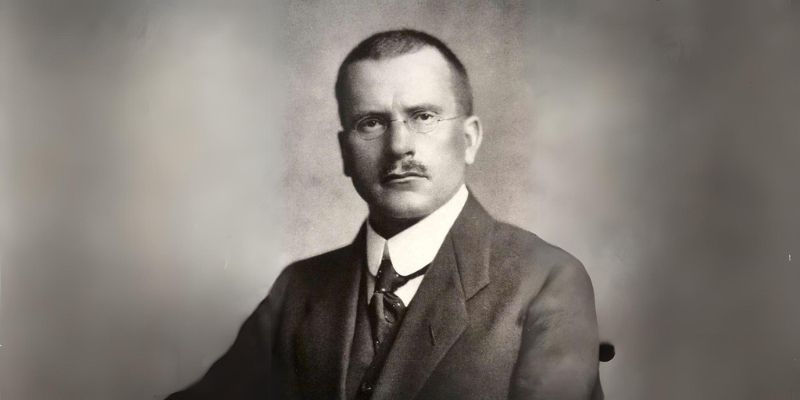
Jungian Psychology: Unraveling the Unconscious Mind
Alongside Sigmund Freud, the Swiss psychiatrist and psychoanalyst Carl Gustav Jung (1875–1961) is one of the most important innovators in the field of modern depth [...]

12 Jungian Archetypes: The Foundation of Personality
In the vast tapestry of human existence, woven with the threads of individual experiences and collective consciousness, lies a profound understanding of the human psyche. [...]
Read other articles by their category
- Body & Brain (52)
- Coaching & Application (39)
- Compassion (23)
- Counseling (40)
- Emotional Intelligence (21)
- Gratitude (18)
- Grief & Bereavement (18)
- Happiness & SWB (40)
- Meaning & Values (26)
- Meditation (16)
- Mindfulness (40)
- Motivation & Goals (41)
- Optimism & Mindset (29)
- Positive CBT (28)
- Positive Communication (23)
- Positive Education (36)
- Positive Emotions (32)
- Positive Leadership (16)
- Positive Parenting (14)
- Positive Psychology (21)
- Positive Workplace (35)
- Productivity (16)
- Relationships (46)
- Resilience & Coping (38)
- Self Awareness (20)
- Self Esteem (37)
- Strengths & Virtues (29)
- Stress & Burnout Prevention (33)
- Theory & Books (42)
- Therapy Exercises (37)
- Types of Therapy (54)

4 Ways Creative Thinking Drives Professional Success
Learn how to inspire creativity that will change people's lives with these expert tips from instructor Anne Manning.
Anne Manning
“We are going to reimagine every unloved product in people’s lives!” That’s the line that yielded the equity the founders of Nest needed to build a company that made thermostats.
Initially venture capitalists turned down their pitch for funding because thermostats are so, well, dull. Why did Kleiner Perkins eventually provide the capital?
Because the Nest founders were clear their business wasn’t about thermostats. It was about looking at familiar objects, seeing them in a new light, and inventing products that will change people’s lives. In other words, it was about imagination and creativity.
Nest recently sold their company to Google for $3.2 billion, proof that imagination and creative thinking produce results.
Imagination and creativity are the catalysts for transforming knowledge into insights, valuable ideas, and successful implementation. In essence, you see the potential instead of the problem. You see the reasons to act rather than the reasons not to act. Ultimately, breakthrough results depend on these cognitive capabilities.
In organizations, innovation comes from people who use imagination and creativity to solve complex problems. Frameworks like creative problem solving and design thinking all share one common thread: they support and promote individual creative skills.
How To Sharpen Your Creative Thinking Skills
Here are four skills that, with practice, are guaranteed to help you reimagine solutions to challenges you are facing and lead you to professional success.
1. See with Fresh Eyes.
Nest reimagined the thermostat by seeing it with fresh eyes. They observed the thermostat differently than other people.
Fresh observations are the result of noticing and recording the details of situations. Look at things from new angles. Record what you are seeing, feeling, tasting, hearing, and touching. Details fuel imaginative and creative solutions.
For example, what if you were charged with improving the waiting room experience at a doctor’s office? The first thought might be to provide more comfortable chairs or more specific estimates of wait times.
But Jerry Seinfeld provides this detailed description of the waiting room experience that might drive a whole different set of ideas:
“I hate the waiting room because it’s called the waiting room. There’s no chance of not waiting. Why would they take you right away when they’ve got this room all set up. You sit there with your little magazine. You pretend you’re reading but you’re really looking at other people, wondering what he’s got. Then they finally call you and you think you’re going to see the doctor, but you’re not. You’re going into the next, small waiting room where you don’t have a magazine. And you’ve got no pants on.”
These rich observations might lead you to ask: How might we eliminate the waiting room altogether? Or, in what ways might we make examination rooms more entertaining?
Search all Innovation programs.
2. Make No Assumptions.
If you want a new solution, challenge what you think you know. Imagine you’re tasked with developing a new salad dressing. Before reading on, record at least five ideas. (Seriously. This insight is more meaningful if you do the exercise.)
What kind of ideas did you write down? Most people come up with new flavors. That’s fine — if you want evolutionary change based on known characteristics and assumptions. But breakthrough ideas require you to literally break through your current assumptions — like salad dressing is cold, it’s liquid, and it gets poured on lettuce.
If you challenge these assumptions (i.e., salad dressings are not cold), you open the door to new and potentially successful ideas (for example, a pouch of dressing you heat in the microwave).
3. Spew Ideas Like Confetti at the Super Bowl.
How many of us sit in meetings where someone says something equivalent to: “Sales are down. Let’s spend some time brainstorming ideas for improving the situation.” Then every idea is met with comments like, “We’ve tried that before and it didn’t work.”
Next time you need new ideas, set aside time to come up with lots of ideas without critiquing them. Then pick five or six you like and try to combine them in new ways. You might be surprised to see what happens.
4. When It’s Time for Critiques, Start with the Positive.
It’s easy to crush an idea. It’s harder to nurture it.
One way to nurture an idea is to look for the positive first. What will work about it? Then look for the potential. If this idea worked, what would it help us accomplish? Finally, think about the challenges to implementing the idea and what it would take to overcome those challenges. This approach will help you retain ideas instead of kill them too quickly.
Success — at work and at home — is always fueled by creativity and imagination. And it’s a myth that these creative thinking skills can’t be learned or enhanced. If you practice these four skills, you will become a respected creative thinker who is valued as a problem solver at work and at home.
Find related Innovation Strategy programs.
Browse all Professional & Executive Development programs.
About the Author
Manning is a founding partner of Drumcircle and an Innovation Fellow with Encore.org, and brings over 25 years of experience working with senior executives at Fortune 500 firms.
Mastering the Basics of Communication
To be a better communicator, you must listen, observe, organize, and connect.
Harvard Division of Continuing Education
The Division of Continuing Education (DCE) at Harvard University is dedicated to bringing rigorous academics and innovative teaching capabilities to those seeking to improve their lives through education. We make Harvard education accessible to lifelong learners from high school to retirement.


IMAGES
VIDEO
COMMENTS
The interdependence between the Project-Based Learning (PjBL) Model and the growth and enhancement of Creative Thinking and Mathematical Problem Solving Skills in Elementary Schools is unquestionable nowadays. Prior studies have yet to discover concrete evidence regarding the interdependence being discussed.
In early childhood education, fostering creativity has a huge impact on cognitive skills. Activities that promote creative thinking, such as problem-solving tasks and imaginative play, help children develop their memory and critical thinking. These skills are crucial for academic success and are foundational to quality education.
Students learn to manage their emotions and control their impulses as they engage in the creative process. These types of skills profoundly impact academic success, emotional well-being, and the long-term ability to participate positively in conversations and society. Art-based SEL activities also engender social awareness and relationship skills.
Automated feedback on creative skills like writing is controversial too: "Students want feedback from humans, and assessment is a way for teachers to get to know students. Some feedback can be ...
The Coffee Filter Rainbow Craft is a creative and hands-on art project where students use coffee filters to create vibrant rainbow designs. By using watercolor markers or liquid watercolors, students can add color to the coffee filters, and when water is applied, the colors blend and spread, creating a beautiful rainbow effect.
In today's rapidly evolving job market, innovation and creativity have become crucial skills for graduates. Our research has shown that employers are looking for employees who can think outside the box, adapt to change and devise innovative solutions to complex problems. As educators, we play a vital role in preparing students for these challenges by enabling creativity within curricula.
Sharpen your Adobe creative skills. As an Adobe Creative Campus, UTSA provides access to Adobe's suite of Creative tools to UTSA students. The Adobe Education team has curated these short courses to introduce you to Adobe tools in two hours or less, including on its GenAI tools. Login with your UTSA credentials to get started today! Get started ...
There are 16 WRYSE competencies - or sets of knowledge, skills and experience. They are based on the National Occupational Standards for the creative industries, and are developed with industry professionals that breaks down the technical and transferable skills and knowledge required to work within the stage & screen sector.
Transferable Skills By studying philosophy, students develop cognitive transferable skills that pay off in a variety of professions—transferable skills such as Logical Reasoning • Analysis • Abstract Conceptualization • Problem-Solving • Creative Thinking • Clear and Persuasive Writing • Mental Dexterity • An Ability to Assess Different Perspectives and Frameworks ...
With the rise of digital education, more families are turning to online academies as a flexible and convenient option. However, while this approach offers many benefits, it also comes with the ...
Examples of creative thinking skills (and how to use them) Creative thinking skills come in all shapes and sizes, ranging from things like abstract thinking and storytelling to finding ways to radically plan projects or recognize organizational patterns.. In this section, we'll explore each of the example creative skills below and talk about how you might use them in your personal and ...
Posted June 25, 2020. By Emily Boudreau. Understanding the learning that happens with creative work can often be elusive in any K-12 subject. A new study from Harvard Graduate School of Education Associate Professor Karen Brennan, and researchers Paulina Haduong and Emily Veno, compiles case studies, interviews, and assessment artifacts from ...
1. Read. Reading is an effective way to exercise your mind, increase your vocabulary, and expose yourself to new ways of thinking. Whether your book is on a problem you're facing at work or a new and exciting subject, reading is an excellent opportunity to learn.
These simple creativity challenges can encourage students to have the mindset of an artist, a designer, and a change-maker. We're living in an era when the thinking process is becoming increasingly more important in a student's learning journey: the ability to be reflective, adaptable, flexible, and nimble during times of constant change.
Creativity and critical thinking prepare students for innovative economies and improve wellbeing. However, educators often lack guidance on how to equip students with creativity and critical thinking within subject teaching. Education systems have likewise rarely established ways to systematically assess students' acquisition of creativity ...
Importance of Creative Thinking for Students. Developing creative thinking in learners has long been considered an essential aspect of education and brain development. Harold Bloom (1956), the American Literary critic and educator, devised his Bloom's Taxonomy which categorises learning into 6 categories—the final stage is to "create."
Yes, You Can Teach and Assess Creativity! By Andrew Miller. March 7, 2013. Photo credit: venosdale via flickr (CC BY-NC-SA 2.0) A recent blog by Grant Wiggins affirmed what I have long believed about creativity: it is a 21st-century skill we can teach and assess. Creativity fosters deeper learning, builds confidence and creates a student ready ...
1. Put Yourself in a Box. Creative thinking is about "thinking outside the box," but putting limitations on your problem-solving can help you think more freely and innovatively. For example, if someone tells you to make dinner, you may struggle to come up with a meal you don't always cook.
The four core creativity skills run throughout the four capacities and are integral to the meta skills which are increasingly important in today's workplace. The World Economic Forum states that by 2025, the top five skills employers will be looking for include innovation, complex problem solving, critical thinking, creativity and originality.
Creativity is the ability to generate a thought or an idea that is completely new, appealing, and useful. Creative thinking is a skill that enables you to come up with original and unconventional ideas. Creative thinking expresses itself in a multitude of ways. A graphic artist creates a brilliant logo.
That all comes from a creative mindset.". Nicole Krueger is a freelance writer and journalist with a passion for finding out what makes learners tick. 5 reasons to teach creativity: 1) It motivates kids. 2) It lights up the brain. 3) It spurs emotional development. 4) It ignites hard-to-reach kids. 5)….
Bring powerful creative tools to the classroom. From critical thinking and creative problem solving to communication and collaboration, Adobe Creative Cloud helps students build the skills they need to succeed in K-12, higher education, and the modern workforce.
Through the arts, students develop skills like resilience, grit, and a growth mindset to help them master their craft, do well academically, and succeed in life after high school. (See Embracing Failure: Building a Growth Mindset Through the Arts and Mastering Self-Assessment: Deepening Independent Learning Through the Arts.) Ideally, this ...
Teaching creativity involves directly teaching idea generation, planning for work, and problem-solving. To really learn these things kids have to apply them by being expected to ask the question "What do I want to make?" and being tasked with figuring out the answer. I teach this in my classroom with a process called Design Process Thinking ...
All participants will earn a Certificate of Completion from the Harvard Division of Continuing Education. Benefits of Creative Thinking Skills Training. The goal of this creative thinking program is to help you develop the strategic concepts and tactical skills to lead creative problem solving for your team and your organization. You will learn to:
Creativity Skills: Definition, Tips and Examples. Creativity is a valuable workplace skill because it can be a useful tool for developing new ideas, increasing efficiency and devising solutions to complex problems. While you may have natural creativity skills in certain forms, it is a skill that can be learned and developed over time.
Overall, creative output was found to improve by about 60% when walking (either indoors or out), versus sitting. So, if you're looking to boost your creativity, try going for a short walk - or a long one. 2. Set task limits. This idea is borrowed from an entrepreneur who called it " embracing constraints" (Tank, 2019).
Frameworks like creative problem solving and design thinking all share one common thread: they support and promote individual creative skills. How To Sharpen Your Creative Thinking Skills. Here are four skills that, with practice, are guaranteed to help you reimagine solutions to challenges you are facing and lead you to professional success. 1.
Creative photographers come in all shapes and sizes, but whether you're working with portraits, commercial clients, the abstract, or so much more, your photography skills come from training and practice. It takes a firm grasp of camera settings, composition, lighting, and other basics to produce high-quality photography.
Nizhny Novgorod (/ ˌ n ɪ ʒ n i ˈ n ɒ v ɡ ə r ɒ d / NIZH-nee NOV-gə-rod; [14] Russian: Нижний Новгород, IPA: [ˈnʲiʐnʲɪj ˈnovɡərət] ⓘ lit. ' Lower Newtown '; colloquially shortened to Nizhny) [a] is the administrative centre of Nizhny Novgorod Oblast and the Volga Federal District in Russia.The city is located at the confluence of the Oka and the Volga rivers in ...